Keep up to date with the news about valuation trends.....
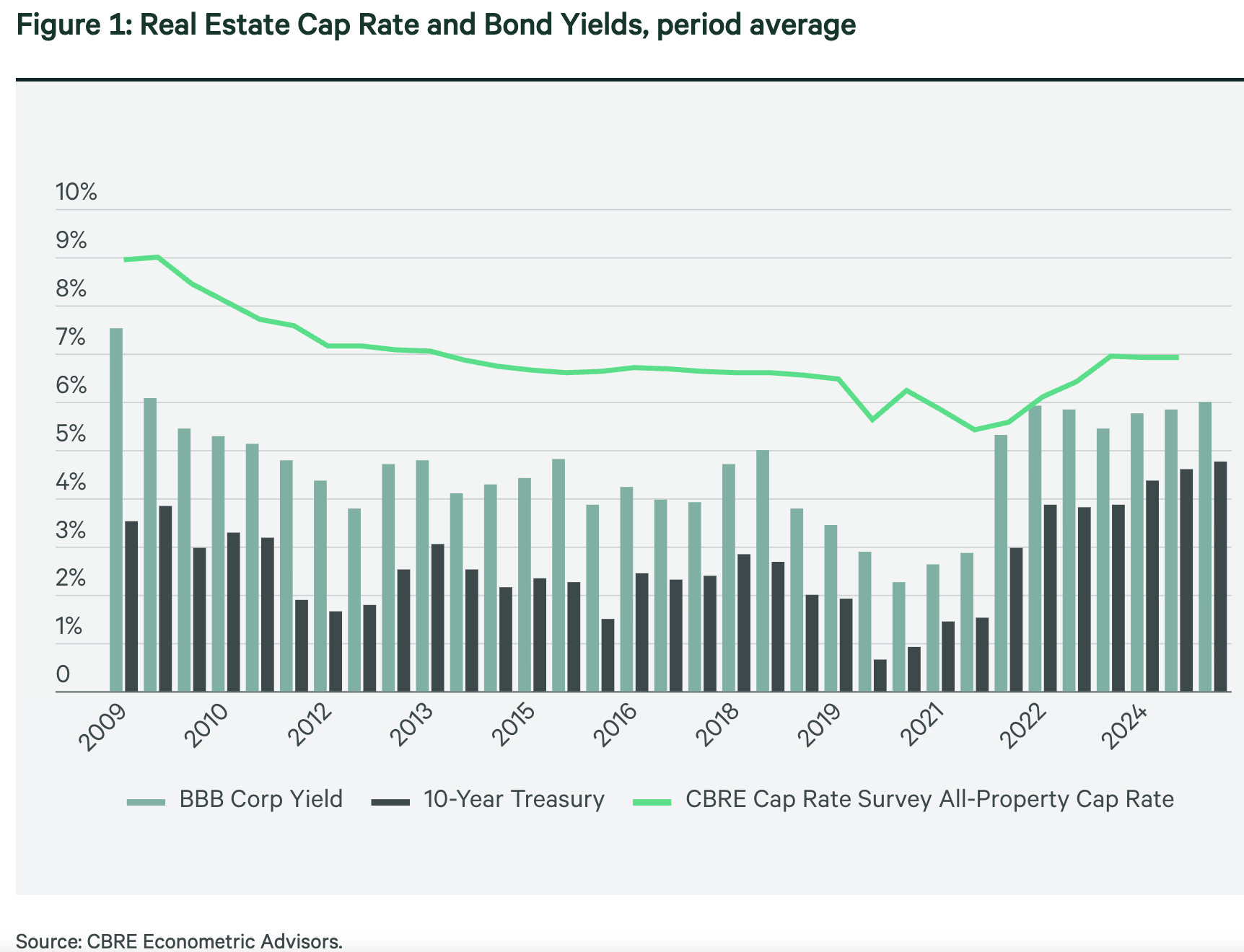
CBRE - Cap Rates held steady during the 2nd half of 2024
Treasury yields were extremely volatile during 2024, as financial markets grappled with economic data that sent mixed signals about the outlook for inflation, Federal Reserve policy and where long-term interest rates will settle.
The 10-Year Treasury yield started the year below 4% and peaked at 4.7% in late April. Ultimately continued disinflation and expectations for Fed rate cuts pushed the 10-Year Treasury yield down to 4.2% in June and 3.6% in September. But yields reversed course during Q4 as the Fed signaled there would be fewer future cuts than the market was expecting. This pattern has continued into 2025 as the large federal budget deficit, policy uncertainty, and varying inflation signals keep bond markets guessing but with an upward bia
Feb 12, 2025
Source - read more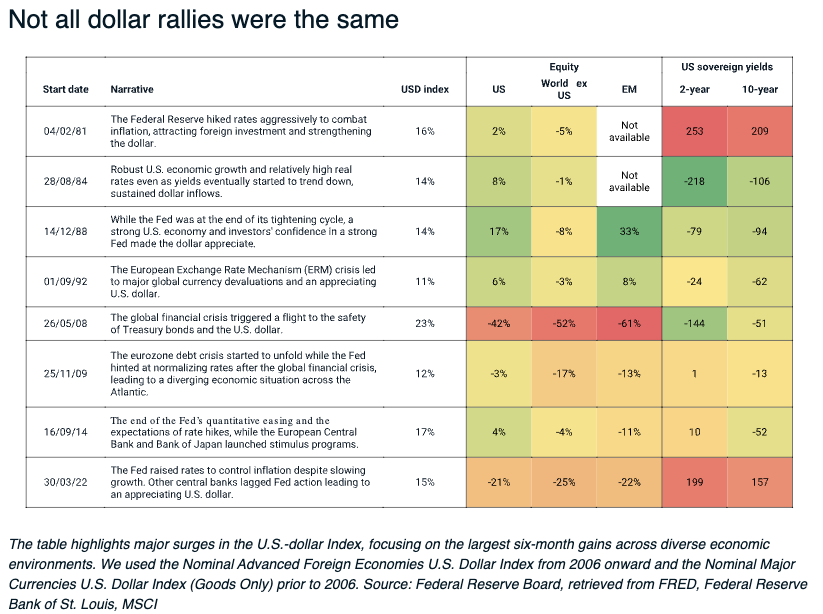
Scenario Analysis: Tariffs and a Strong US dollar
With tariffs taking center stage, multi-asset-class investors may face a variety of stresses on their portfolios. We model a what-if scenario with an inflationary spike, a drag on growth and strength in the U.S. dollar.
History shows that USD strength has had varied implications for asset classes, depending on the underlying economic backdrop.
Under our scenario, both U.S. equities and bonds take a hit, while global stocks face two distinct pressures in USD terms — economic headwinds and home-currency depreciation.
March 3, 2025
Source - read more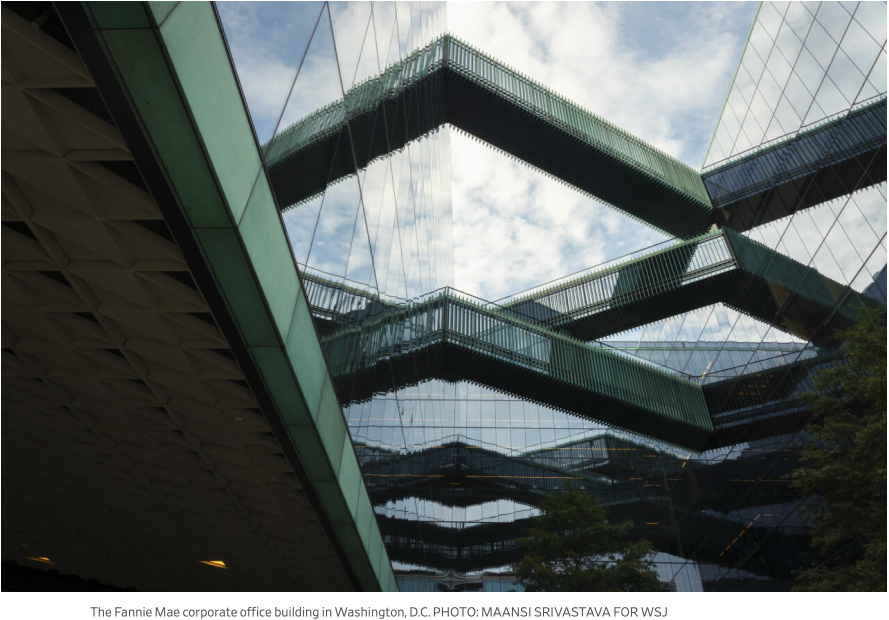
Trump’s Housing Chief Embarks on Shake-Up at Mortgage Giants Fannie Mae and Freddie Mac
In his first full week as head of the Federal Housing Finance Agency, home-builder heir and former private-equity executive William Pulte ousted more than a dozen board members at mortgage giants Fannie Mae and Freddie Mac.
Pulte made himself the chairman of the boards and installed a set of new directors (one of them was Christopher Stanley, an Elon Musk ally who resigned from the post a day later). He removed senior executives at the companies and the FHFA, which regulates Fannie and Freddie. Among those let go was Freddie CEO Diana Reid.
March 23, 2025
Source - read more
Pulte made himself the chairman of the boards and installed a set of new directors (one of them was Christopher Stanley, an Elon Musk ally who resigned from the post a day later). He removed senior executives at the companies and the FHFA, which regulates Fannie and Freddie. Among those let go was Freddie CEO Diana Reid.
March 23, 2025
Source - read more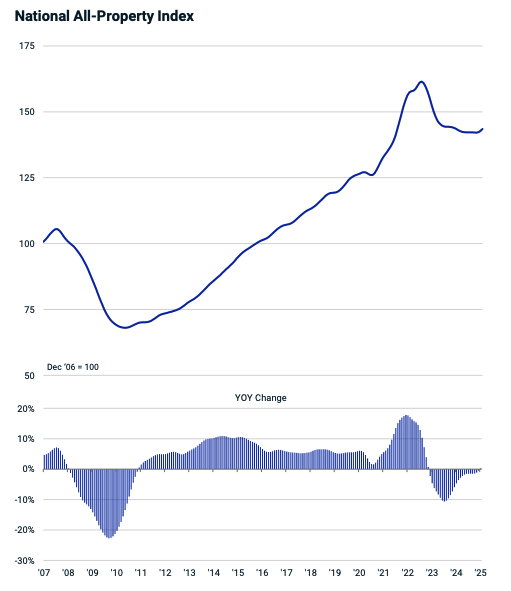
Commercial property price indexes report
Commercial property prices edged into annual growth in January, with a 0.3% increase in the RCA CPPI National All-Property Index. The index has posted three consecutive monthly increases, and in January prices rose 0.5% from December, suggesting a faster annualized pace of growth of 6.5%. January 1, 2025
Source - read more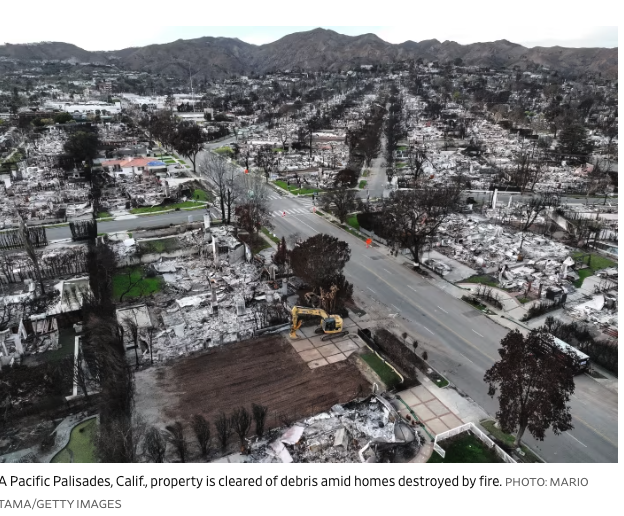
Home-selling season starts after LA Wildfires- and there is demand
LOS ANGELES—In two Los Angeles neighborhoods where wildfires destroyed thousands of homes less than two months ago, the selling season is already well under way.
More than 80 new listings of scorched plots in Pacific Palisades and Altadena have hit the market since the middle of February. Land parcels where homes once stood are commanding selling prices above early expectations.
Febuary 3, 2025
Source - read more
More than 80 new listings of scorched plots in Pacific Palisades and Altadena have hit the market since the middle of February. Land parcels where homes once stood are commanding selling prices above early expectations. Febuary 3, 2025
Source - read more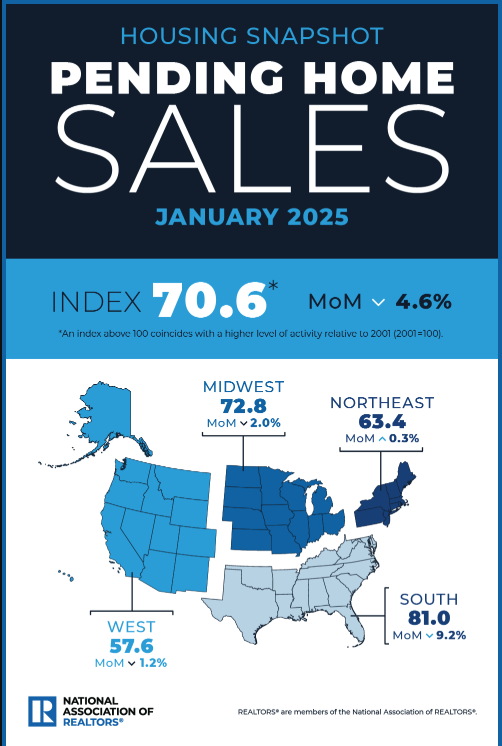
Pending home sales waned 4.6% in January
WASHINGTON (February 27, 2025) – Pending home sales pulled back 4.6% in January according to the National Association of REALTORS®. The Midwest, South and West experienced month-over-month losses in transactions – with the most significant drop in the South – while the Northeast saw a modest gain. Year-over-year, contract signings lowered in all four U.S. regions, with the South seeing the greatest falloff.
Feb 27, 2025
Source - read more
Feb 27, 2025
Source - read more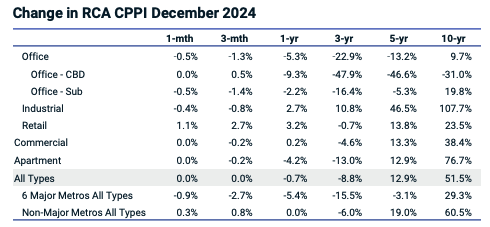
RCA CPPI Commercial property price indexs
U.S. commercial property prices continued to stabilize in 2024, with encouraging signs of recovery emerging across property markets. The RCA CPPI National All-Property Index fell 0.7% YOY in December, a significant improvement on the 5.9% drop recorded at the close of 2023. The index was little changed relative to November.
Earlier in 2024, increased optimism about Federal Reserve rate cuts and less uncertainty around inflation contributed to the start of a rebound in activity. The shift in outlook supported improved alignment between buyers and sellers on pricing.
Dec, 2024
Source - read more
Earlier in 2024, increased optimism about Federal Reserve rate cuts and less uncertainty around inflation contributed to the start of a rebound in activity. The shift in outlook supported improved alignment between buyers and sellers on pricing. Dec, 2024
Source - read more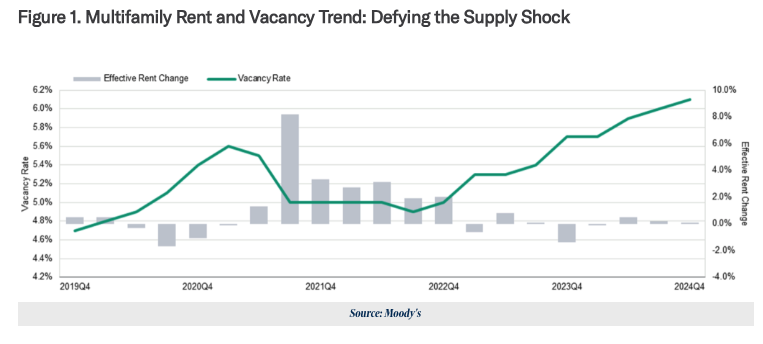
Moody's Q4 2024 Preliminary Trend Announcment
Multifamily Continued to Defy the Supply Shock, Office’s Vacancy Rate Broke Another Record, Retail Rents Drift Higher with Tight Supply, And Industrial Maintains Status Quo
The Federal Reserve’s battle against inflation continues to remain important as the prolonged economic soft landing endures. Three rate cuts by the FOMC throughout 2024 helped the commercial real estate (CRE) industry, but with annual inflation rate accelerating to 2.7% in November expectations of slower movement for future cuts have emerged. While uncertainties remain, preliminary Q4 data shows a continued trend from prior quarters and levels of resiliencies across the sectors.
January 3, 2025
Source - read more
The Federal Reserve’s battle against inflation continues to remain important as the prolonged economic soft landing endures. Three rate cuts by the FOMC throughout 2024 helped the commercial real estate (CRE) industry, but with annual inflation rate accelerating to 2.7% in November expectations of slower movement for future cuts have emerged. While uncertainties remain, preliminary Q4 data shows a continued trend from prior quarters and levels of resiliencies across the sectors. January 3, 2025
Source - read more
The U.S. Government Has a Landlord, and Trump Isn’t a Fan
Shortly before he was elected president in 2016, Donald Trump took a break from campaigning to attend a ceremony for his new flagship hotel, the Trump International Hotel Washington, D.C.
The General Services Administration, the federal agency that owns, manages and leases much of the government’s real estate, had previously awarded Trump the rights to redevelop the government-owned Old Post Office as a luxury hotel. The GSA selected him over Hilton, Marriott International and other big-name operators.
Jan 21, 2025
Source - read more
The General Services Administration, the federal agency that owns, manages and leases much of the government’s real estate, had previously awarded Trump the rights to redevelop the government-owned Old Post Office as a luxury hotel. The GSA selected him over Hilton, Marriott International and other big-name operators. Jan 21, 2025
Source - read more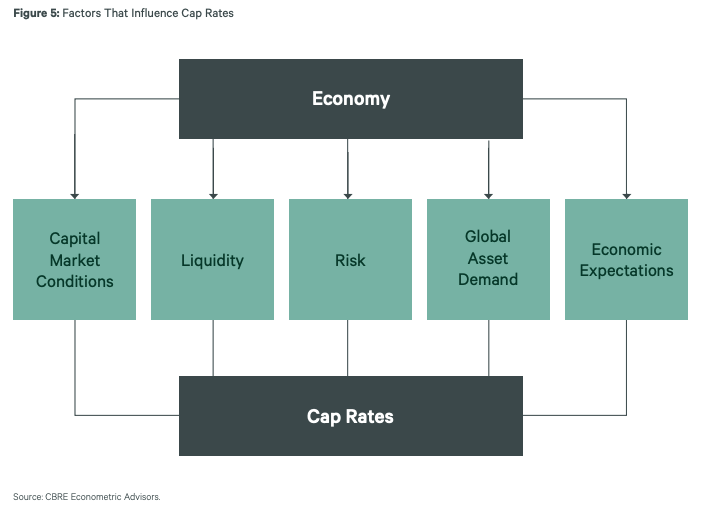
CBRE projects Cap Rates will compress in 2025
CBRE’s new report on the market outlook for U.S. real estate in 2025 presents a picture of cautious optimism with both opportunities and risks for investors. It predicts investment sales will continue to recover, boosted by strong economic growth, with volume up by as much as 10% next year. However, investors will remain careful. Primary targets will be industrial and multifamily assets. “Assuming minimal disruptions from tariffs, retail will continue to attract investors with its strong fundamentals and we expect some portfolio sales will ensure a robust year for this property type,” the report commented. Dec 13, 2024
Source - read more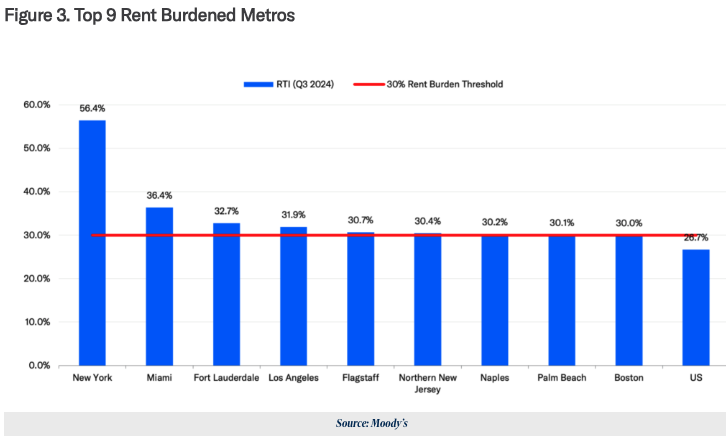
Moody's Q3 2024 Housing Affordability Update
The national median household income rose 3.6% over the year, easing the Rent-to-income (RTI) ratio which declined to 26.7%, providing relief for rent-burdened metros. Population growth in the South, driven by migration from expensive cities, is changing demographics and subsequently will impact housing affordability. States with higher population churn ratios, such as North Carolina, Texas, and Florida indicate strong appeal to new residents, whereas New York and California faced significant net population losses. Student Housing rent growth outpaced multi-family rent growth over the past two years, raising affordability concerns for students. Certain universities have higher student housing rents compared to their local multi-family market, reflecting localized demand pressures. Dec 9, 2024
Source - read more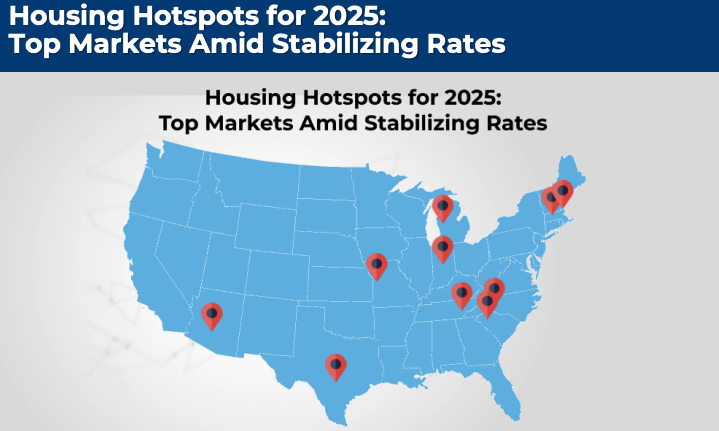
NAR: Housing Hot Spots 2025
The year ahead is poised to bring more opportunities for homebuyers as the housing market continues to stabilize. The Federal Reserve is expected to maintain a gradual approach to easing monetary policy in 2025.
While concerns about federal deficits and rising public debt may cap the extent of those rate cuts, borrowing costs are anticipated to stabilize overall, offering some relief to prospective buyers.
Sustained International Interest: Pricing in the U.S. adjusted faster than in many other parts of the globe, making the basis for acquisition attractive.
However, mortgage rates are unlikely to return to the ultra-low levels seen during the pandemic or the pre-pandemic levels. Affordability will remain a concern for many, particularly in high-demand markets. The National Association of REALTORS® forecasts mortgage rates to stabilize near 6% in 2025, likely establishing a new normal.
Dec 12, 2024
Source - read more
Sustained International Interest: Pricing in the U.S. adjusted faster than in many other parts of the globe, making the basis for acquisition attractive.
However, mortgage rates are unlikely to return to the ultra-low levels seen during the pandemic or the pre-pandemic levels. Affordability will remain a concern for many, particularly in high-demand markets. The National Association of REALTORS® forecasts mortgage rates to stabilize near 6% in 2025, likely establishing a new normal.
Dec 12, 2024
Source - read more
However, mortgage rates are unlikely to return to the ultra-low levels seen during the pandemic or the pre-pandemic levels. Affordability will remain a concern for many, particularly in high-demand markets. The National Association of REALTORS® forecasts mortgage rates to stabilize near 6% in 2025, likely establishing a new normal. Dec 12, 2024
Source - read more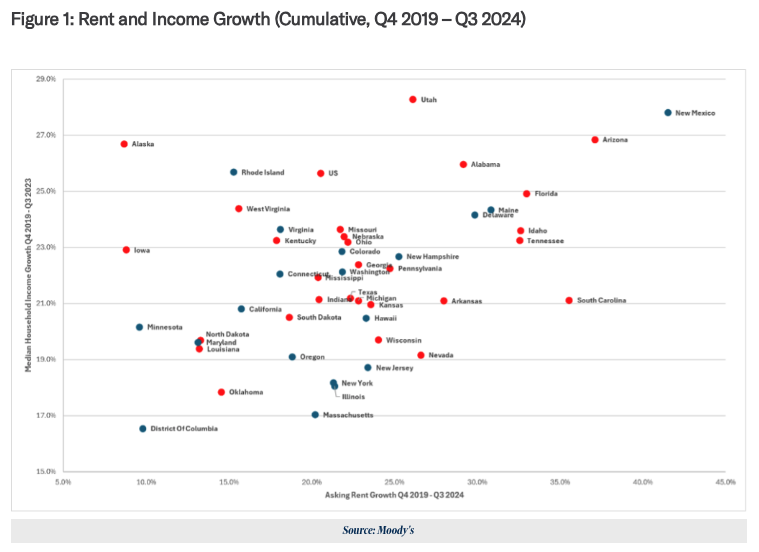
Multifamily Housing and the 2024 Election
Housing affordability played an important role in the 2024 election as both parties outlined their plans to respond to rising rent levels. Effective rents have climbed 20% nationally since Q4 2019 along with rising prices throughout the economy resulting from the period of heightened inflation that the Federal Reserve continues to fight. President-elect Trump’s second term is likely to lead to adjustment in the American economy as a result of outlined plans to raise tariffs on foreign goods and tighten immigration levels along with expected tax and spending adjustments. As outlined in our analysis before the election, we expect effective rent growth to moderate as a result of macroeconomic conditions and recent supply growth, with reduced housing demand placing further downward pressure on rent growth with a tradeoff of lower expected supply growth. Nov 13, 2024
Source - read more
Led by AI, Tech Demand for Office Space Is on the Rise
Technology companies’ leasing of office space jumped in the third quarter to its highest level in nearly three years, reflecting the growth of artificial-intelligence firms and job growth in the tech industry.
Tech firms leased 9.9 million square feet of U.S. office space during the third quarter. That was up from about eight million in the second quarter, and the highest amount since the fourth quarter of 2021, according to a new report from commercial real-estate services firm CBRE Group.
Hiring by tech companies has also edged higher, resulting in an uptick in office demand. Job growth was up 1% for the year through July, compared with all of 2023 when it rose 0.3%.
That is still well off the 5.4% growth in 2021, CBRE said. The U.S. office market remains in a glut, in part because many tech companies are taking less space when signing new leases because of hybrid workplace strategies.
Nov 12, 2024
Source - read more
Tech firms leased 9.9 million square feet of U.S. office space during the third quarter. That was up from about eight million in the second quarter, and the highest amount since the fourth quarter of 2021, according to a new report from commercial real-estate services firm CBRE Group.
Hiring by tech companies has also edged higher, resulting in an uptick in office demand. Job growth was up 1% for the year through July, compared with all of 2023 when it rose 0.3%.
That is still well off the 5.4% growth in 2021, CBRE said. The U.S. office market remains in a glut, in part because many tech companies are taking less space when signing new leases because of hybrid workplace strategies.
Nov 12, 2024
Source - read more
That is still well off the 5.4% growth in 2021, CBRE said. The U.S. office market remains in a glut, in part because many tech companies are taking less space when signing new leases because of hybrid workplace strategies. Nov 12, 2024
Source - read more
Colliers 2025 Global Investor Outlook
Commercial real estate markets worldwide are showing signs of positive momentum, with stronger sentiment growing as asset values stabilize. Investor confidence is rising,
and while gross transaction volumes remain modest, conversations and funraising activity indicate that markets are moving past their low point.
Revival in Activity: Investors can now look forward to falling interest rates and improved market conditions. A tailwind of declining rates will be supportive of a market rebound
over the next several quarters.
Sustained International Interest: Pricing in the U.S. adjusted faster than in many other parts of the globe, making the basis for acquisition attractive.
Asset Class Allocation: The multifamily and industrial sectors are expected to lead sales, while office presents unique buying opportunities. Additionally, growth in alternative assets can unlock investment potential.
Nov 19, 2024
Source - read more
Revival in Activity: Investors can now look forward to falling interest rates and improved market conditions. A tailwind of declining rates will be supportive of a market rebound
over the next several quarters.
Sustained International Interest: Pricing in the U.S. adjusted faster than in many other parts of the globe, making the basis for acquisition attractive.
Asset Class Allocation: The multifamily and industrial sectors are expected to lead sales, while office presents unique buying opportunities. Additionally, growth in alternative assets can unlock investment potential.
Nov 19, 2024
Source - read more
Sustained International Interest: Pricing in the U.S. adjusted faster than in many other parts of the globe, making the basis for acquisition attractive.
Asset Class Allocation: The multifamily and industrial sectors are expected to lead sales, while office presents unique buying opportunities. Additionally, growth in alternative assets can unlock investment potential.
Nov 19, 2024
Source - read more
Asset Class Allocation: The multifamily and industrial sectors are expected to lead sales, while office presents unique buying opportunities. Additionally, growth in alternative assets can unlock investment potential. Nov 19, 2024
Source - read more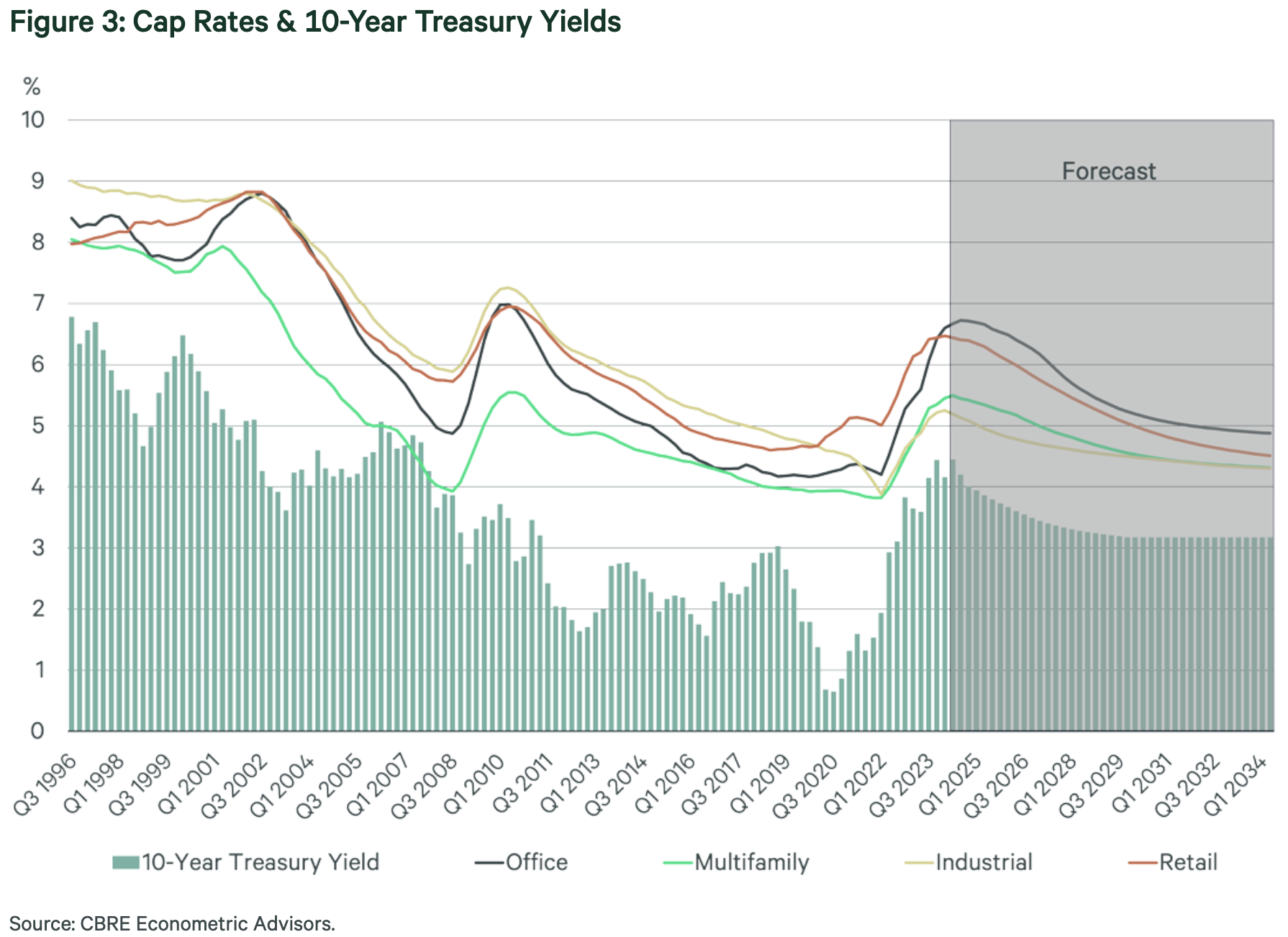
Impact of Interest Rate Cuts on Real Estate Cap Rates
Now that the Fed is starting to cut interest rates, how will real estate capitalization rates react? Conditions that facilitate changes in short-term policy rates influence the long-end of the yield curve, which in turn most influences real estate investment activity. A CBRE Econometric Advisors (CBRE EA) review of cap rates since 1995 shows that for every 100-basis-point change in the 10-year Treasury yield, cap rate movements range between 41 basis points (bps) on average for industrial assets to 78 bps for retail assets. Office cap rate movements averaged 70 bps, while those for multifamily assets averaged 75 bps. Oct 10, 2024
Source - read more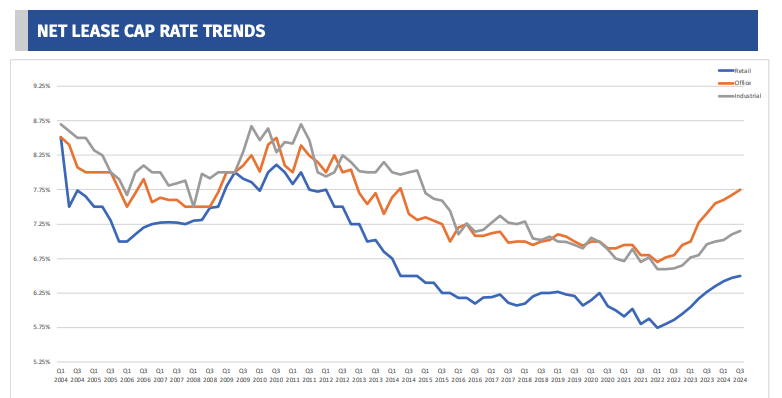
Boulder Group - STNL Cap Rates Inch Higer in 3Q
Cap rates in the single tenant net lease sector increased for the 10th consecutive quarter within all three sectors in the third quarter of 2024. Single tenant cap rates increased to 6.50% (+3 bps) for retail, 7.75% (+8 bps) for office, and 7.15% (+5 bps) for industrial. The persistent upward trend in cap rates can be primarily attributed to sustained high interest rates. Additionally, there is a stagnant supply of net lease properties on the market resulting from limited transaction activity from both private and institutional buyers. Oct 3, 2024
Source - read more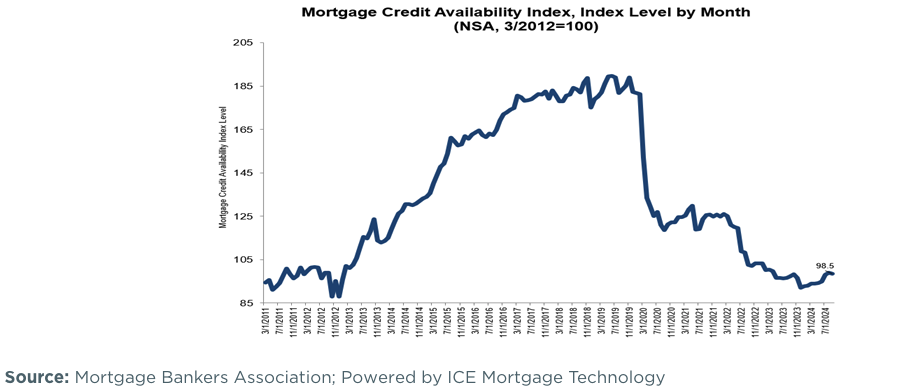
Mortgage Credit Availability Decreased in September
Mortgage credit availability decreased in September according to the Mortgage Credit Availability Index (MCAI), a report from the Mortgage Bankers Association (MBA) that analyzes data from ICE Mortgage Technology. The MCAI fell by 0.5 percent to 98.5 in September. A decline in the MCAI indicates that lending standards are tightening, while increases in the index are indicative of loosening credit. The index was benchmarked to 100 in March 2012. The Conventional MCAI decreased 1.7 percent, while the Government MCAI increased by 0.8 percent. Of the component indices of the Conventional MCAI, the Jumbo MCAI decreased by 2.6 percent, and the Conforming MCAI remained unchanged. Oct 15, 2024
Source - read more
Baby Boomers Refuse to Sell Homes as Younger Families House Hunt
A shortage of homes for resale is helping keep home prices up and beyond the reach of many would-be buyers. However, the majority of baby boomers who own many of the existing houses that could become the dream homes of young families have no interest in selling. Indeed, more than half believe younger generations could afford to buy a home if they tried harder or were more responsible. These are the findings of a survey of 1,100 Americans born between 1946 and 1964 by Clever Real Estate, a St. Louis-based real estate company. The survey was conducted in July. Of the boomers surveyed, 61% currently own their homes, and 54% of them plan never to sell because they attribute much of their financial security to home ownership. Almost 90% also say it leads to a more stable home life. And 46% say they would consider themselves failures if they didn't own a home. Only 15% expect to sell in the next five years. However, 25% of boomer owners also want to stay put because a new home would cost more than they could afford as a result of inflation or because of the high costs of assisted living or retirement communities. Sept 12, 2024
Source - read more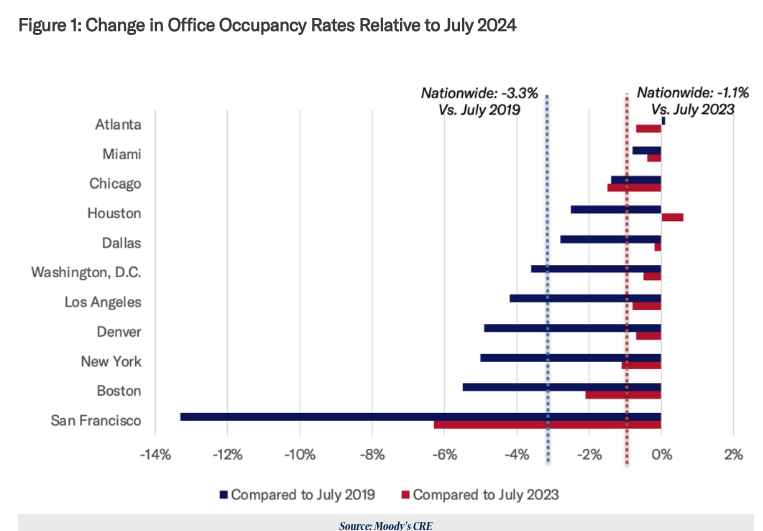
Increasing Office Visits Not A Panacea for Record High Vacancy Rates
According to Placer.ai – a startup that uses cell phone data to analyze foot traffic patterns down to the property level – nationwide employee office visits were 27.8% lower than compared to July 2019 and 16.5% higher than July 2023. Perhaps unsurprisingly, among the eleven metros included in Placer.ai’s report, San Francisco’s office recovery has been the most mired with office visits (as of July 2024) 47.3% lower relative to July 2019. However, relative to July 2023, office visits in San Francisco were 20.2% higher, which was tied with Los Angeles for the second-highest percentage increase (behind Miami) among those select metros. Combining the Placer.ai with Moody’s CRE data continues to suggest that higher employee utilization rates do not necessarily translate into higher office occupancy rates. Specifically, for every one percentage point increase in office visits, the occupancy rate either increased or decreased by approximately 16-bps depending on the time interval used in the regression. Sept 9, 2024
Source - read more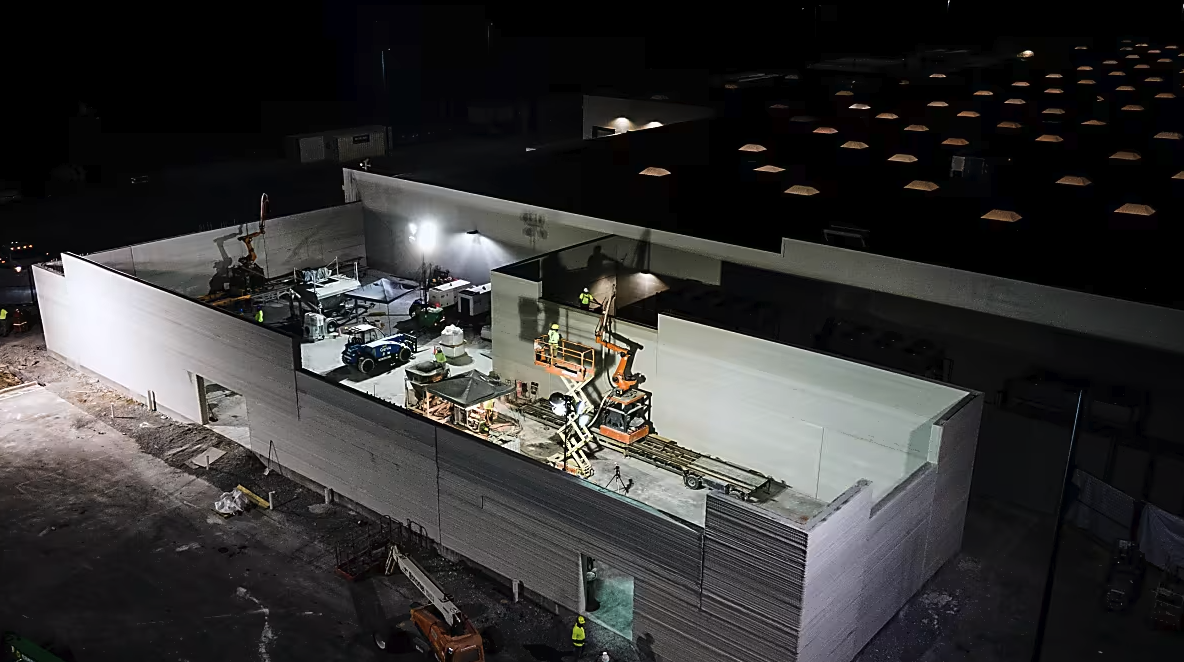
Can 3-D Printing Revolutionize Real Estate? Walmart Puts That Question to the Test
A Walmart Supercenter’s new expansion is one of the largest 3-D printed commercial real-estate projects in U.S. history. Its bumpy road to completion illustrates the new technology’s promise and shortcomings. The retail giant added the 8,000-square-foot space to its Athens, Tenn., location to hold items customers buy online for pickup or delivery. Walmart, which has more than 200 other additions like this in the pipeline, wanted to see if 3-D printing could get the job done faster and more cost-effectively. Sept 9, 2024
Source - read more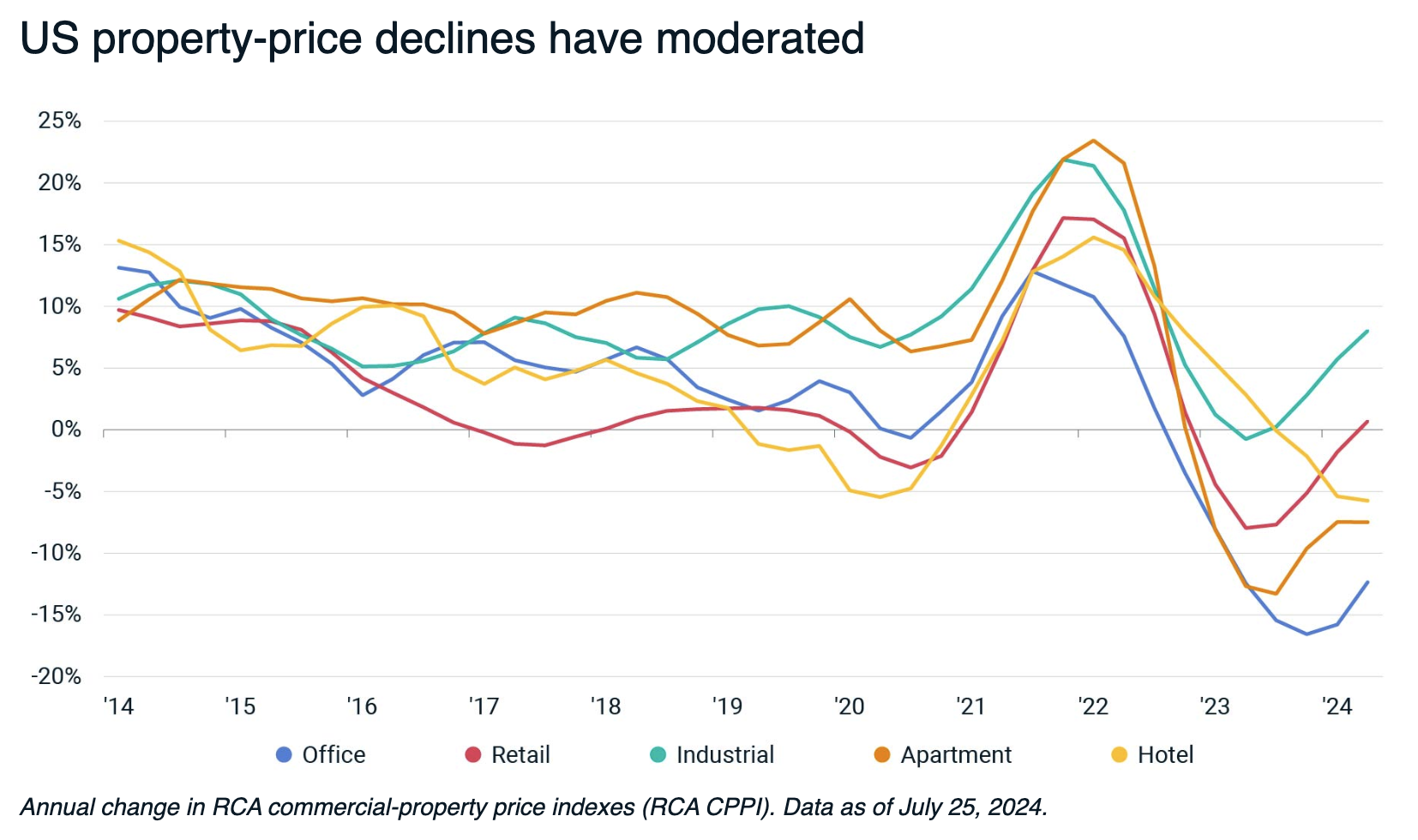
Real Estate in Focus: Signs of Recovery After the Shocks
Key findings Global commercial real estate is showing signs of recovery from the slowdown sparked by higher interest rates. Sales of commercial property worldwide in the second quarter of 2024 matched the levels of the same period in 2023, and price declines in the U.S. moderated. Challenges remain, including fears that slowing U.S. job growth could lead to an abrupt economic downturn. Aug 9, 2024
Source - read more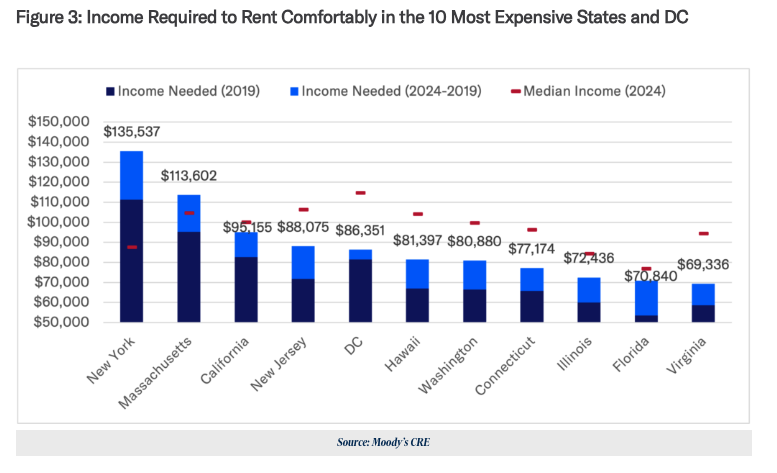
Q2 2024 Housing Affordability Update
Over the first half of the year, rents have declined while income grew on a year-over-year basis, easing the rent-to-income ratio on the national level. Among the top ten metros with the highest RTIs, most have enjoyed a decrease, except the New York metro in the last 12 months due to its lackluster income growth in comparison with rent growth. Household formation accelerated in recent quarters, contributing to rent growth turning the corner, but the rate varies across areas as they are influenced by demographic and economic factors, with the required income to reside in the costliest states ranging between $69,336 and $135,537. The lack of affordable housing in densely populated states poses challenges for both renters and policymakers, particularly affecting the younger population and immigrants. A living wage is essential for financial sustainability in areas with high living costs. Aug 20, 2024
Source - read more
Left Behind in the Retail Real-Estate Comeback: Department Stores
Department stores are bleeding customers, and landlords no longer view them as magnets for shoppers. Discounters are underpricing them. Specialty stores are outmaneuvering them. And luxury brands are sometimes bypassing department stores to open their own shops. The surviving operators are making big moves in hopes of turning things around. Saks Fifth Avenue’s parent company is buying rival Neiman Marcus. Nordstrom executives are exploring taking the company private. Macy’s new chief executive is closing stores while trying to improve the shopping experience at its leaner fleet. Aug 6, 2024
Source - read more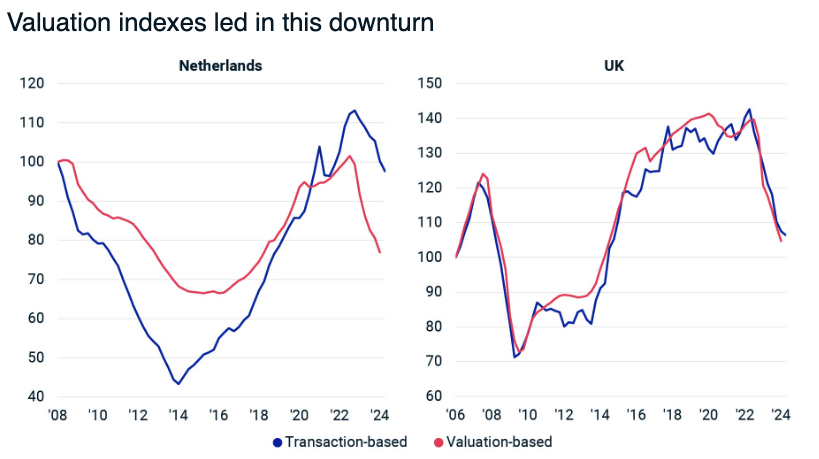
Revenge of the Appraiser: The Power of Valuations
Understanding market performance is essential for any investor in commercial real estate. Accurate and timely pricing data is of high value, especially during periods of uncertainty. Representing market trends with a transaction-based index is challenging in times such as the current period, however, when fewer transactions are occurring. The judgment applied by valuation professionals can help provide clarity in these times. May 20, 2024
Source - read more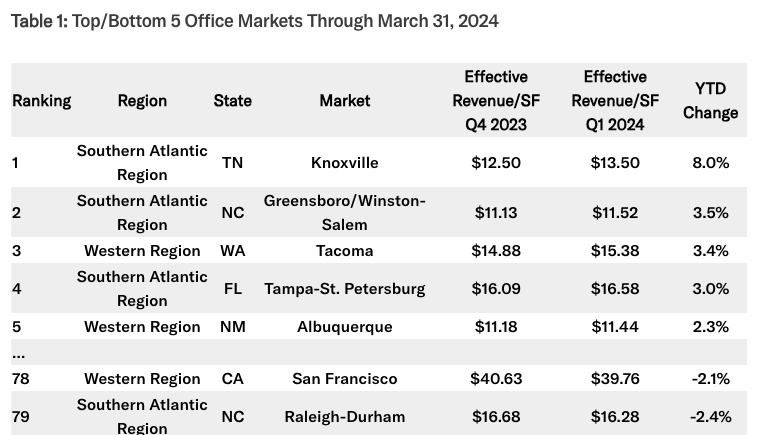
Office Submarkets Bucking the Trend
As of the first quarter of 2024, our top 82 primary office markets were evaluated based on their year-to-date change in effective revenue. Among our five regions, while the Northeast was the top ranked region for the multifamily sector, its office sector performance ranked last given its effective revenue declined by 87-bps during the quarter. Similarly, while the Southwestern Region ranked second-to-last in terms of multifamily sector performance this quarter, its office sector performance ranked first given its effective revenue was higher by 0.62%. Knoxville, TN reported the largest increase in effective revenue at 8.0% – well outpacing the runner up (Greensboro/Winston-Salem, NC) by 450-bps – while Buffalo, NY reported the largest decline at -4.1%. Among our bottom ten office metros, there were several submarkets that bucked the trend in generally down markets. Interestingly, three of those top five submarkets were from Raleigh-Durham, NC. However, the Beltsville submarket in Suburban Maryland took the crown considering its effective revenue increased the most at 10.8%. May 28, 2024
Source - read more
How Much Is Mar-a-Lago Actually Worth? It’s a Billion-Dollar Question.
It has been called “the Mona Lisa,” “the crown jewel” and “a national treasure.” As one of the largest, best-located estates in South Florida, former President Donald Trump’s Mar-a-Lago Club—a roughly 17-acre waterfront property on Palm Beach’s Billionaires’ Row—has long been a subject of fascination. The property’s potential value has also been a matter of debate in recent months. It emerged as a key example in a civil trial in New York that found Trump committed fraud by inflating his wealth and the value of his real-estate empire to secure low-interest financing. A competitive market for luxury Palm Beach properties and a string of recent big-ticket home sales there, including the $150 million deal in May for Tarpon Island, has led to further speculation about the price Mar-a-Lago could command. June 6, 2024
Source - read more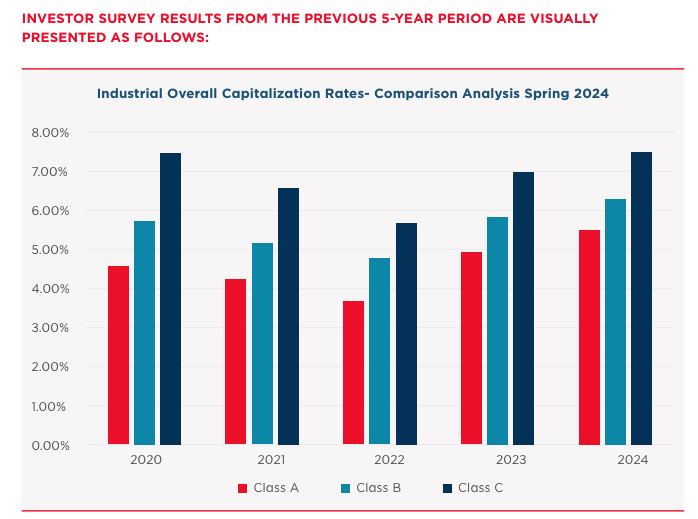
Port Cities Command Most Aggressive Industrial Cap Rates
Port cities are commanding the more aggressive overall capitalization rates for Class A properties although Midwest markets are not far behind, according to Cushman & Wakefield’s Industrial Investor Survey and Outlook for spring 2024. Most investors in the survey do not anticipate further increases in overall interest rates, as their current yield rates have been considered or priced in any potential near-term rate hikes. Activity in the 10-year US Treasury has resulted in higher yield rates and overall capitalization rates, as well as a higher cost of capital. This led the average capitalization rates for Class A assets higher by 58 bps compared to the spring 2023 survey. Likewise, Class B assets rose by 45 bps and Class C assets were up by 52 bps. May 3, 2024
Source - read more
Stalled Inflation Vexes the Fed. Is It Noise or a New Trend?
Explaining why underlying inflation fell steadily from its pandemic peak of over 5% in 2022 to under 3% at the end of last year is straightforward: improved supply, softer demand and well-anchored inflation expectations. Explaining why it stalled in the first quarter is a lot harder. The fundamentals still look good: Supply and demand are coming back into balance, at least in the labor market, and inflation expectations have edged lower. Mar 2, 2024
Source - read more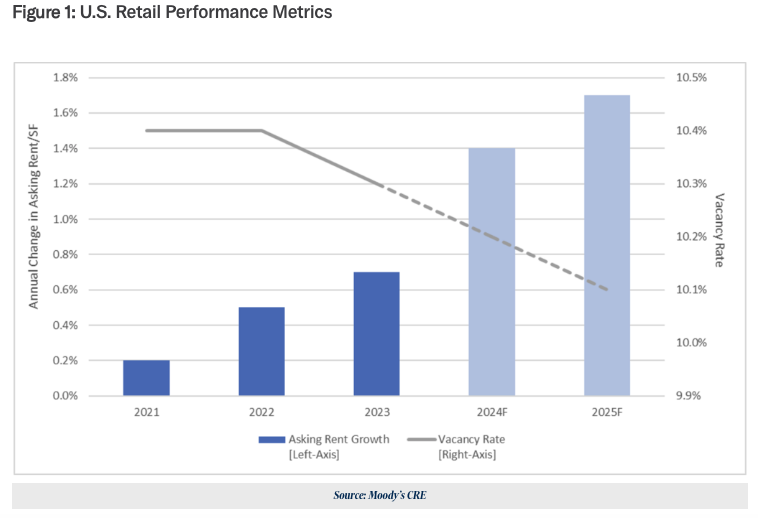
Moody's: GDP Misses While Chipotle Cooks Red Lobster
After several weeks of generally hotter-than-expected economic data, Thursday’s advance estimate of Q1 real GDP fell well short of the consensus estimate of 2.5%, increasing at a still healthy annual rate of 1.6%. Meanwhile, the Federal Reserve’s preferred inflation gauge or the core PCE Price Index, rose by 0.3% MoM and 2.8% YoY in March. With the rate of consumer spending outpacing consensus, along with initial jobless claims falling to lowest level in nine weeks, markets have scaled back the projected number of interest rate cuts to just one, 25-bps reduction by year-end. Although aggregate consumer spending habits have continued to defy expectations over the past year, elevated inflation has disproportionately affected those in lower-income households. For retailers unable to adapt to ever-changing consumer spending habits, bankruptcies have loomed large with a few notable examples of late including Red Lobster, Express, Bed Bath & Beyond, and Joann Fabrics. Evidently, not all retailers have been in dire straits. Chipotle, for example, who targets more affluent customers, recently announced on its Q1 earnings call that same store sales rose by 7% and it plans to open 285 to 315 new restaurants this year. April 29, 2024
Source - read more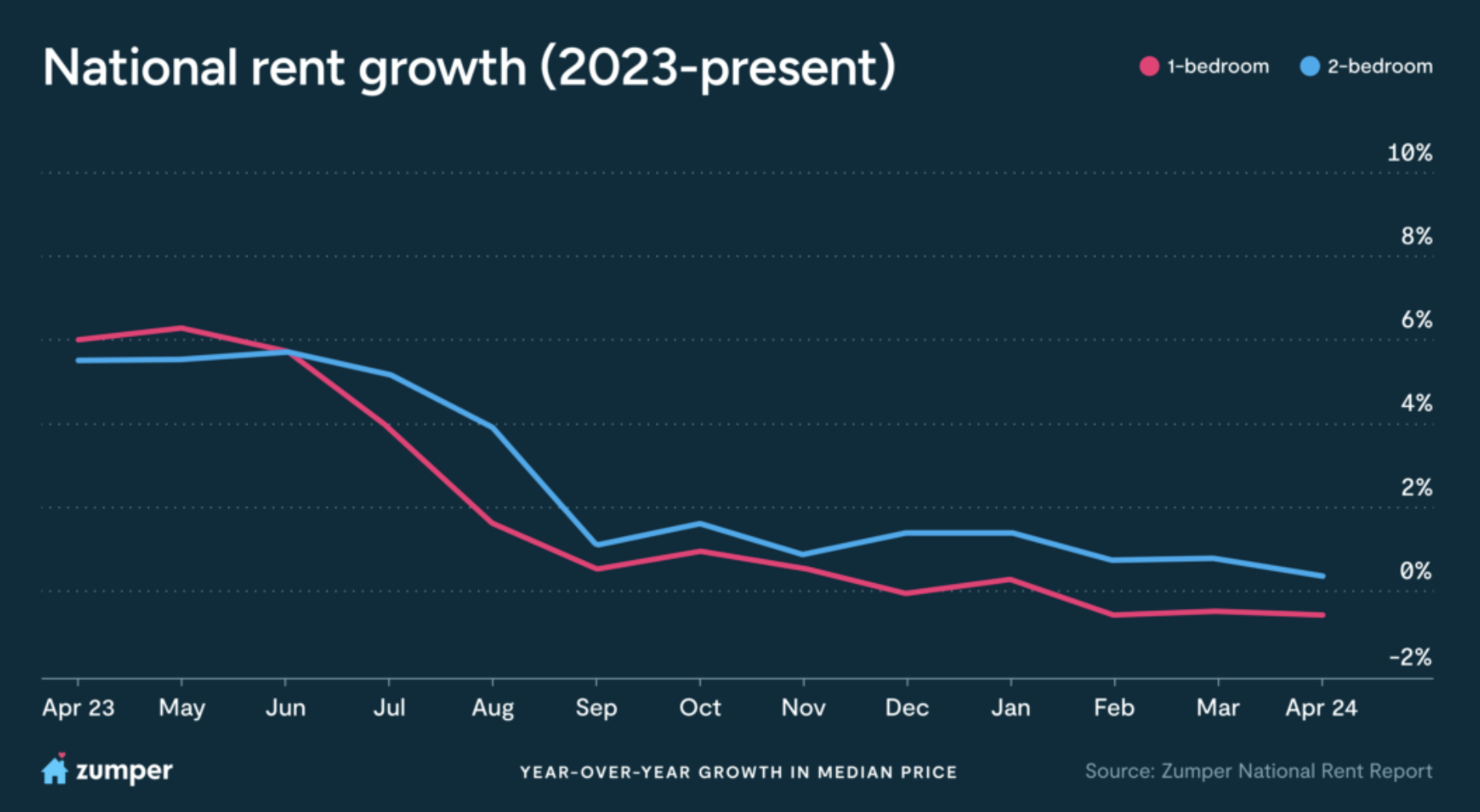
Zumper (MF) National Rent Report
The national rent index continued its trend of stable annual rates with one-bedrooms down 0.6% to $1,486, while two-bedrooms increased 0.1% to $1,843. As normal seasonality patterns return and the rental market has leveled off from the price spikes seen in the last few years, the national one-bedroom rate is now about $9 cheaper than it was last year. However, even with this cooling, the national one-bedroom rent is still nearly $250 pricier than it was in 2021. April 23, 2024
Source - read more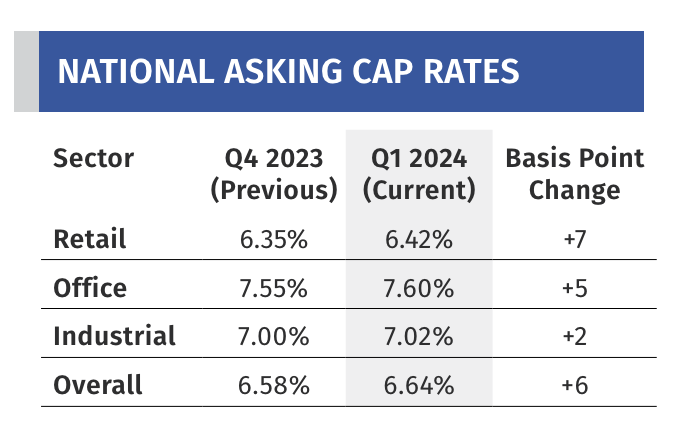
The Bolder Group: Cap Rates in the STNL sector increased 8 consecutive quarters
During the second month of the year, the Commercial Real Estate (CRE) market presented a mixed picture, with certain sectors showing resilience while others continued to face uncertainties and losses. The office sector has unquestionably borne the brunt of the most severe and persistent challenges than any other CRE category, and its outlook remains uncertain. The industrial sector has slowed down, with demand falling beneath levels seen before the pandemic. However, multifamily and neighborhood retail sectors remain strong. In the meantime, lower interest rates later this year are expected to create a more favorable environment for the CRE market by reducing costs, increasing demand, and stimulating economic activity. Q1 2024
Source - read more
Reversing the Real-Estate Doom Loop Is Possible. Just Look at Detroit
Barely a decade after Detroit declared bankruptcy, the city is emerging as America’s most unlikely real-estate boomtown. A development frenzy has gripped Detroit’s central business district. Big companies, including Ford and developer Related Cos., are spending billions of dollars on office buildings and other properties. Dan Gilbert, a Detroit native and the billionaire co-founder of home lender Rocket Mortgage, is leading the city’s revitalization. His new skyscraper, still under construction, recently topped out at 681 feet, making it the city’s second-tallest tower. It sits across the street from downtown Detroit’s first Gucci store. April 22, 2024
Source - read more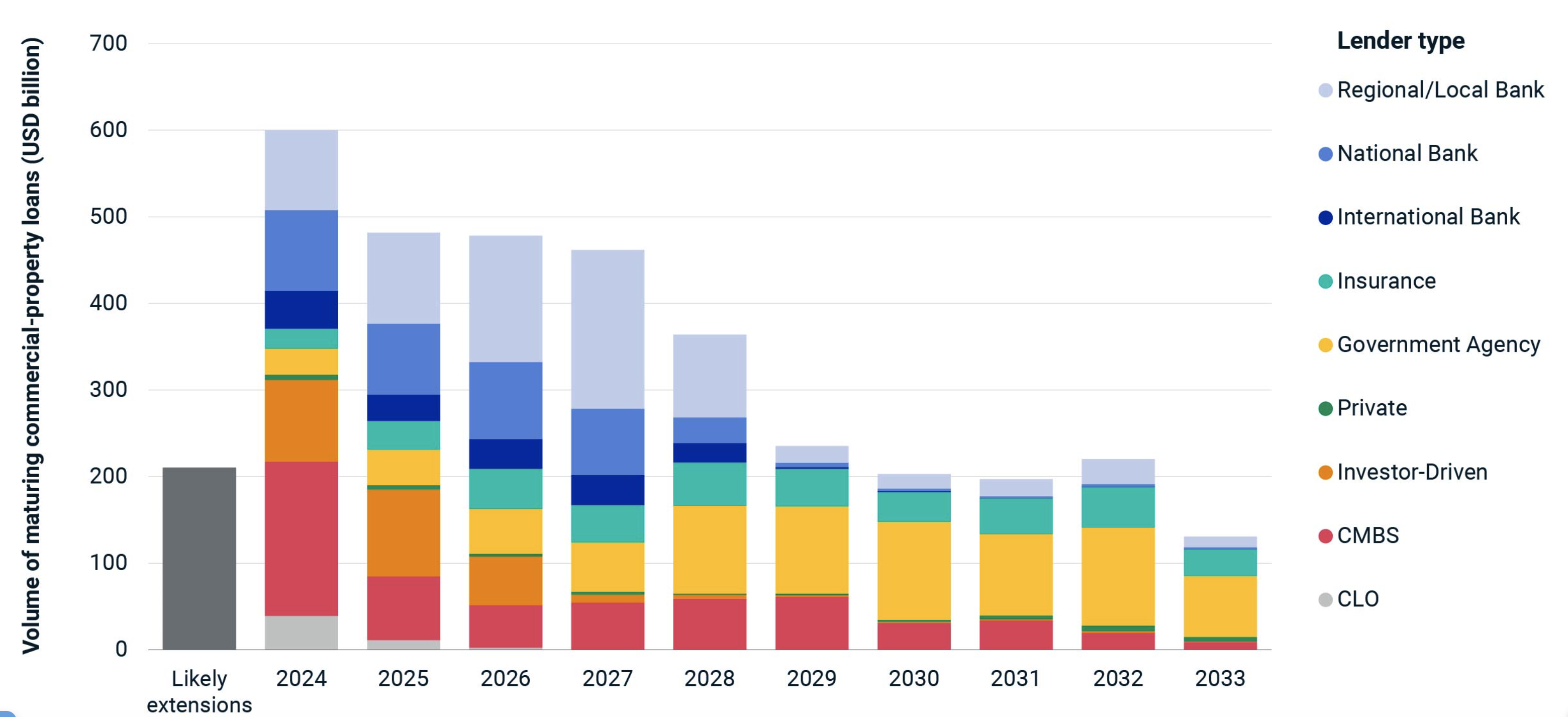
Wave of Property-Loan Maturities Amplified by Extensions
Close to USD 820 billion of U.S. commercial-property loans could mature in 2024, coming due after a broad decline in property prices and sharp increase in borrowing costs that may stymie the refinancing of some mortgages. Loans maturing in 2024 total around USD 600 billion, according to MSCI Mortgage Debt Intelligence data. Additionally, USD 214 billion of loans were slated to come due in 2023 but, according to our analysis, were not subsequently refinanced and no sale of the associated collateral occurred; we have deemed these loans “likely extensions.” Of the loans coming due this year, more than half were provided by commercial mortgage-backed security (CMBS), collateralized loan obligation and investor-driven lenders (e.g., debt funds). CMBS lenders have the single largest exposure to loans maturing in 2024, accounting for nearly 30% of the outstanding balance. Later in the maturity schedule, banks dominate. Bank lenders are behind at least 45% of the loans scheduled to come due in 2025, 2026 and 2027. Loans originated in 2021 make up the largest single vintage for 2024 loan maturities. Given these loans were originated around record-high prices and at ultra-low interest rates, we anticipate that many of these borrowers will look to their lenders in the hopes of extending the maturity of their loans. Not every lender will be willing or able to extend, however, making this vintage of loans a prime target for those investors looking for opportunities in the dislocation. March 26, 2024
Source - read more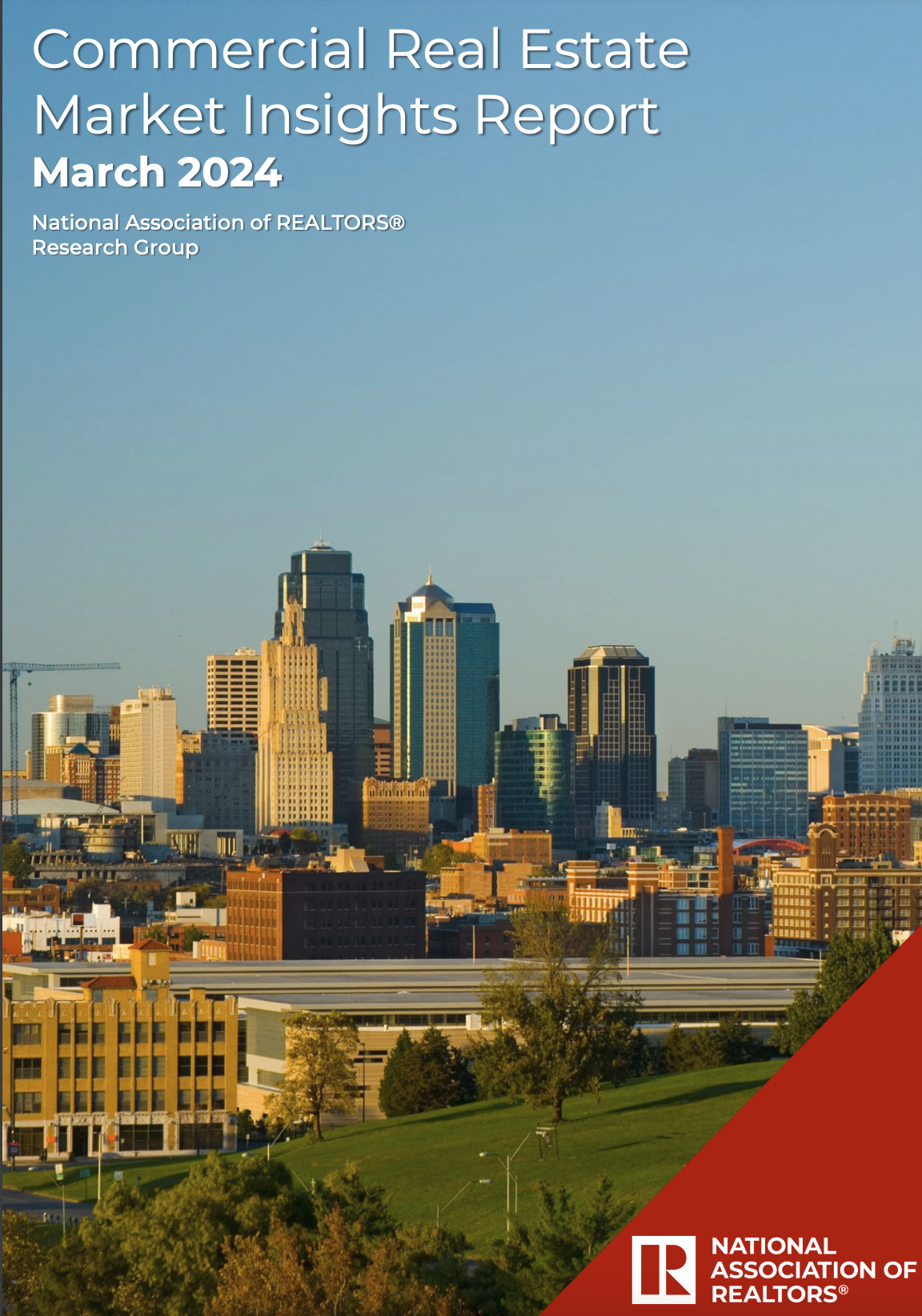
March 2024 Commercial Real Estate Market Insights
During the second month of the year, the Commercial Real Estate (CRE) market presented a mixed picture, with certain sectors showing resilience while others continued to face uncertainties and losses. The office sector has unquestionably borne the brunt of the most severe and persistent challenges than any other CRE category, and its outlook remains uncertain. The industrial sector has slowed down, with demand falling beneath levels seen before the pandemic. However, multifamily and neighborhood retail sectors remain strong. In the meantime, lower interest rates later this year are expected to create a more favorable environment for the CRE market by reducing costs, increasing demand, and stimulating economic activity. March, 2024
Source - read more
Private Cash Buyers Dominate Net Lease
Are you a net lease investor with $5 million cash in your pocket? Then you’re golden in the current market. Right now the sector’s biggest problem is that there is a considerable amount of supply on the market and not enough buyers willing to invest at cap rates where the merchant developers can break even or make some money, explains Jimmy Goodman, partner with The Boulder Group. Goodman will be a moderator at GlobeSt.com’s upcoming Net Lease conference. Most of the deals he is seeing come from private buyers because institutional capital needs to be at a much higher cap rate – over 7% – compared to what private buyers can do. “There are not enough sellers that can meet that high of a cap rate,” Goodman says. A private buyer with cash, though, does not have to secure expensive financing, which is why the sub $5 million deal space right now is particularly robust. “The larger the deal the more likely you will need some form of debt and that makes a deal harder to pencil, Goodman says. March 29, 2024
Source - read more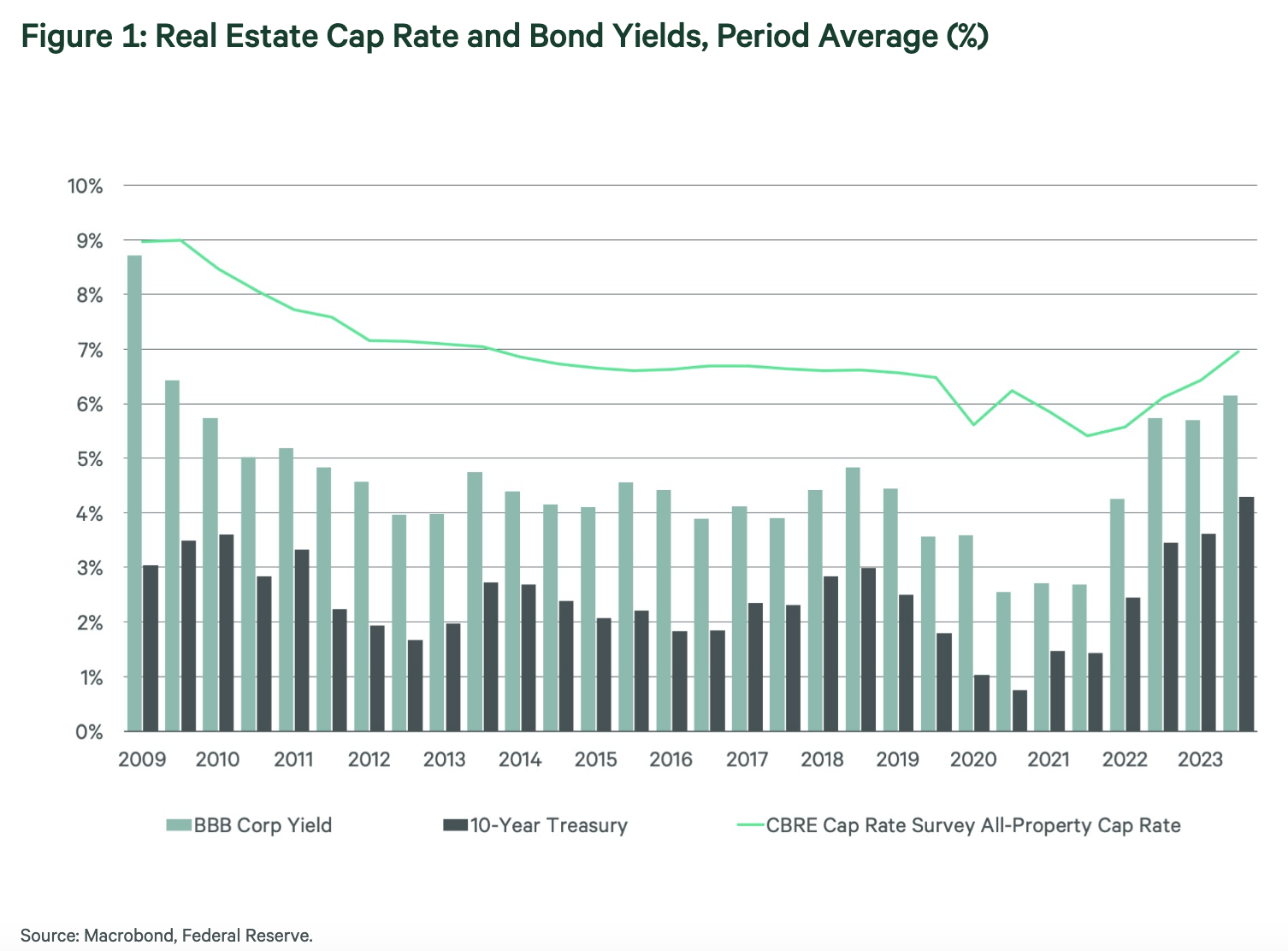
CBRE: U.S. Cap Rate Survey H2 2023
Welcome to CBRE’s H2 2023 Cap Rate Survey (CRS). This survey comes at a unique time for real estate capital markets as limited investment volume has caused pricing uncertainty. The data driving this report was gathered from mid-November through December 2023 and informed by deals that occurred throughout the second half of 2023. We acknowledge that market conditions are fluid but believe that the CRS provides a useful base and unlocks important truths about how investor sentiment is changing.ommercial-property prices are falling, and lenders, investors and especially regulators are fearful of the impact on the broader financial system. The risks in the system today are not the same as those seen during other crisis events, however. Making the assumption that all banks will face the same challenges as in other downturns may lead one down a path to bad decisions. March 5, 2024
Source - read more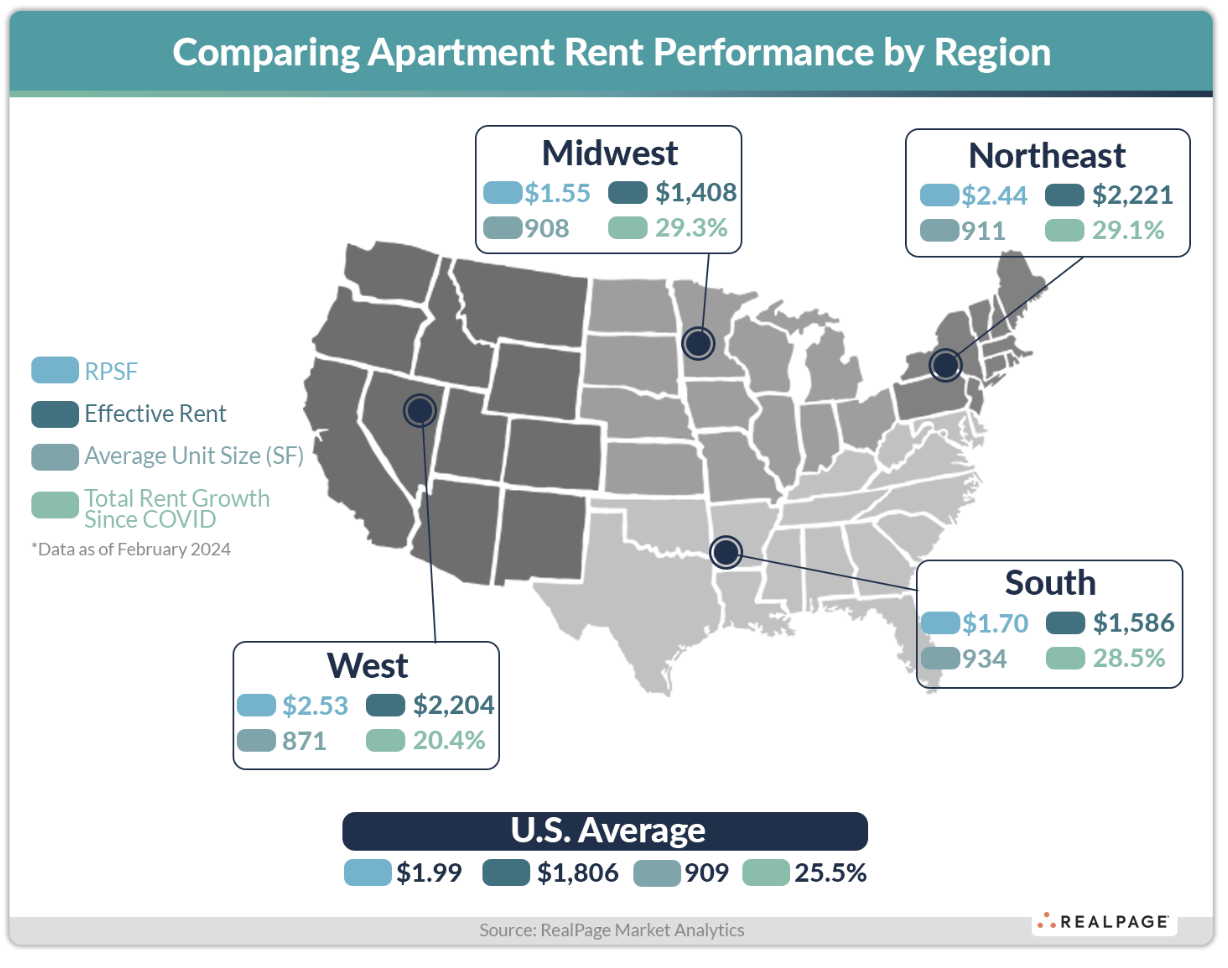
West Region Records Nation’s Slowest Apartment Rent Growth Since Pandemic
Since the global pandemic, apartment rents in the West region have grown at the slowest rate in the nation. Meanwhile, rents in the nation’s three other regions – the South, Midwest and Northeast – have all grown effective rents at a rate faster than the national norm. In turn, average effective rents in the West region now run below that of the Northeast for the first time since mid-2015. March 20, 2024
Source - read more
The New Normal for Mortgage Rates Will Be Higher Than Many Hope
Interest rates are likely to come down later this year, with the Federal Reserve on track to start cutting rates. But mortgage rates might not follow as quickly. That is because mortgages, and mortgage-backed bonds, just aren’t as in demand in financial markets as they were in the years before the Fed began to start to tighten in 2022. And they might not be for a while. March 22, 2024
Source - read more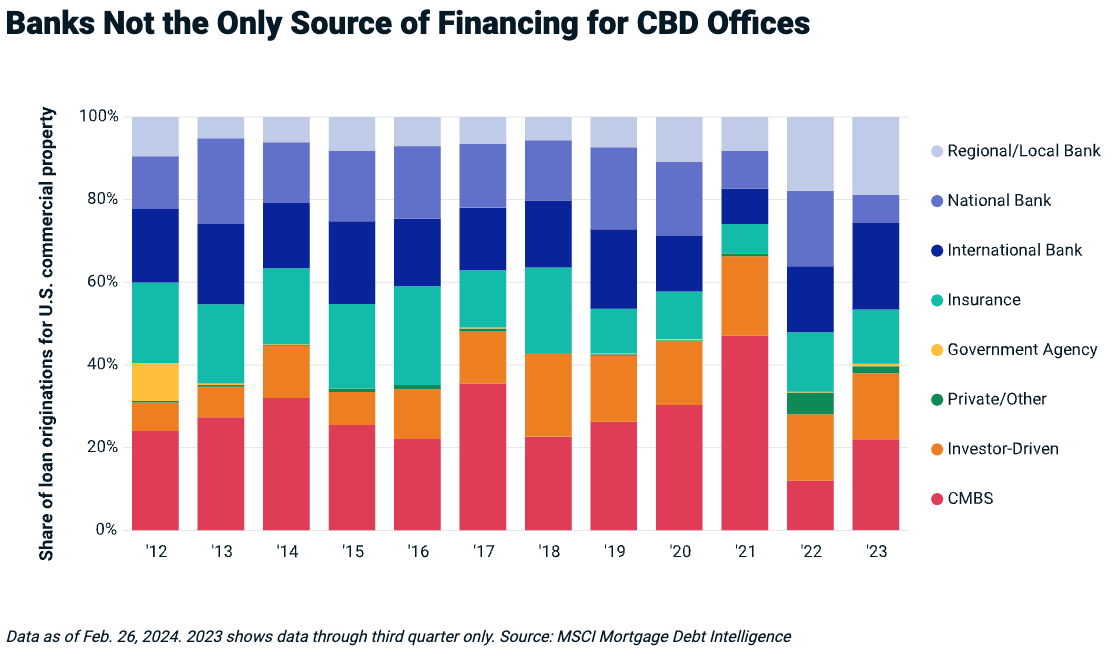
Not Every Bank Is at Risk from CRE Lending
Commercial-property prices are falling, and lenders, investors and especially regulators are fearful of the impact on the broader financial system. The risks in the system today are not the same as those seen during other crisis events, however. Making the assumption that all banks will face the same challenges as in other downturns may lead one down a path to bad decisions. March 7, 2024
Source - read more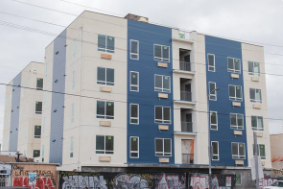
Why Private Developers Are Rejecting Government Money for Affordable Housing
LOS ANGELES—State and local governments in California have committed tens of billions of dollars to build more affordable housing. A new complex for some of the neediest low-income people doesn’t use any of it. By forgoing government assistance and the many regulations and requirements that come with it, SDS Capital Group said the 49-unit apartment building it is financing in South Los Angeles will cost about $291,000 a unit to build. The roughly 4,500 apartments for low-income people that have been built with funding from a $1.2 billion bond measure L.A. voters approved in 2016 have cost an average of $600,000 each. March 16, 2024
Source - read more
The CRE Digest: February 20, 2024
Office Space, Q4 2023 Housing Affordability Update, Q4 2023 Tech Markets, and More News from Last Week Between policy changes, market shifts, and sector trends, keeping up with all the news in the CRE world can be difficult. The CRE Digest gives you the quick insight you need into the latest goings-on, from the state of financing to deep dives on climate risk to individual metro forecasts. Check back every week for the new CRE Digest, so you can stay in the know. February 20, 2024
Source - read more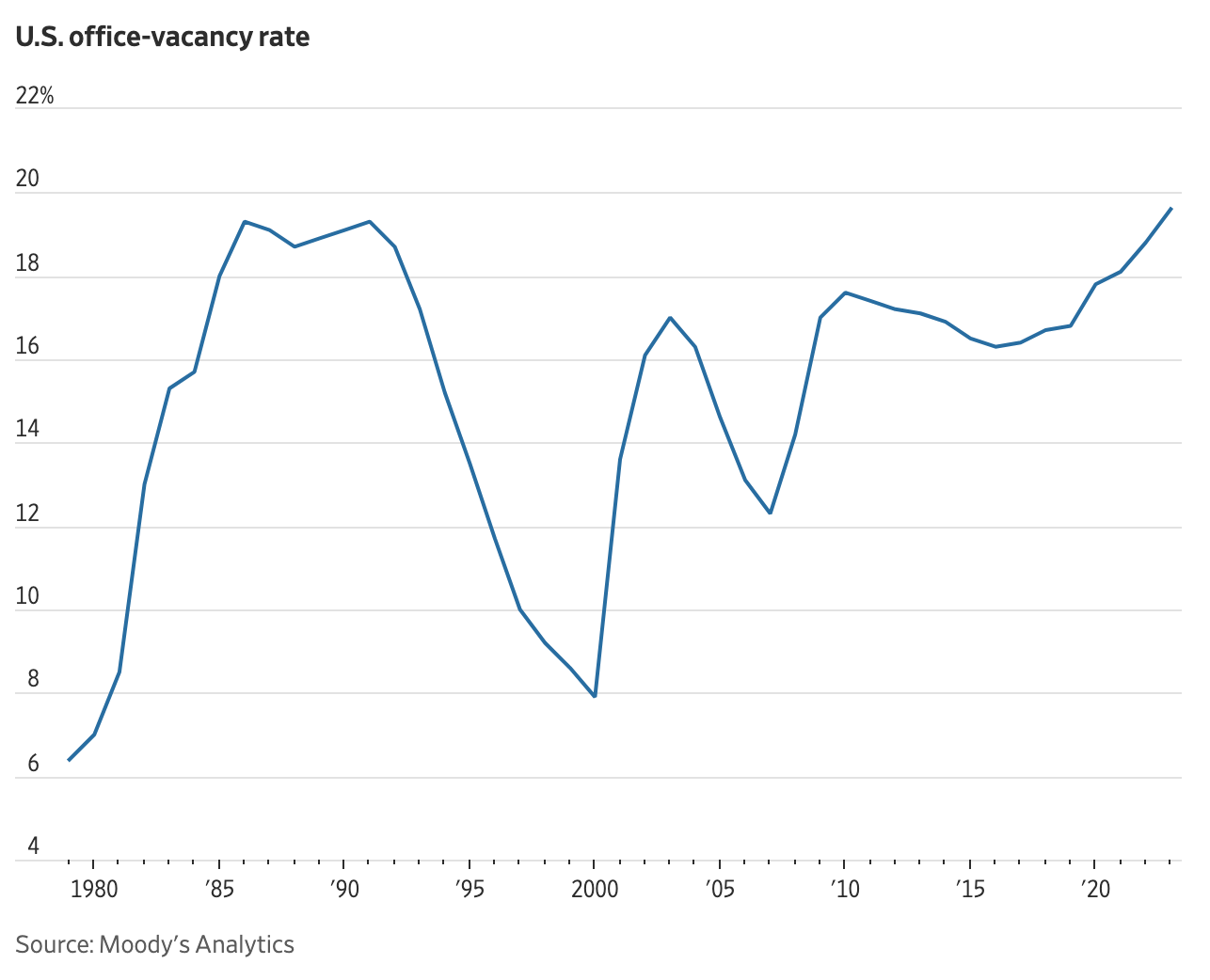
Offices Around America Hit a New Vacancy Record
America’s offices are emptier than at any point in at least four decades, reflecting years of overbuilding and shifting work habits that were accelerated by the pandemic. A staggering 19.6% of office space in major U.S. cities wasn’t leased as of the fourth quarter, according to Moody’s Analytics, up from 18.8% a year earlier. That is slightly above the previous records of 19.3% set in 1986 and 1991 and the highest number since at least 1979, which is as far back as Moody’s data go. The new record shows how remote work has upended the office market. But that is only part of the story. Much of the market’s current malaise traces its roots to the office-market downturn of the ’80s and ’90s. Jan 8, 2024
Source - read more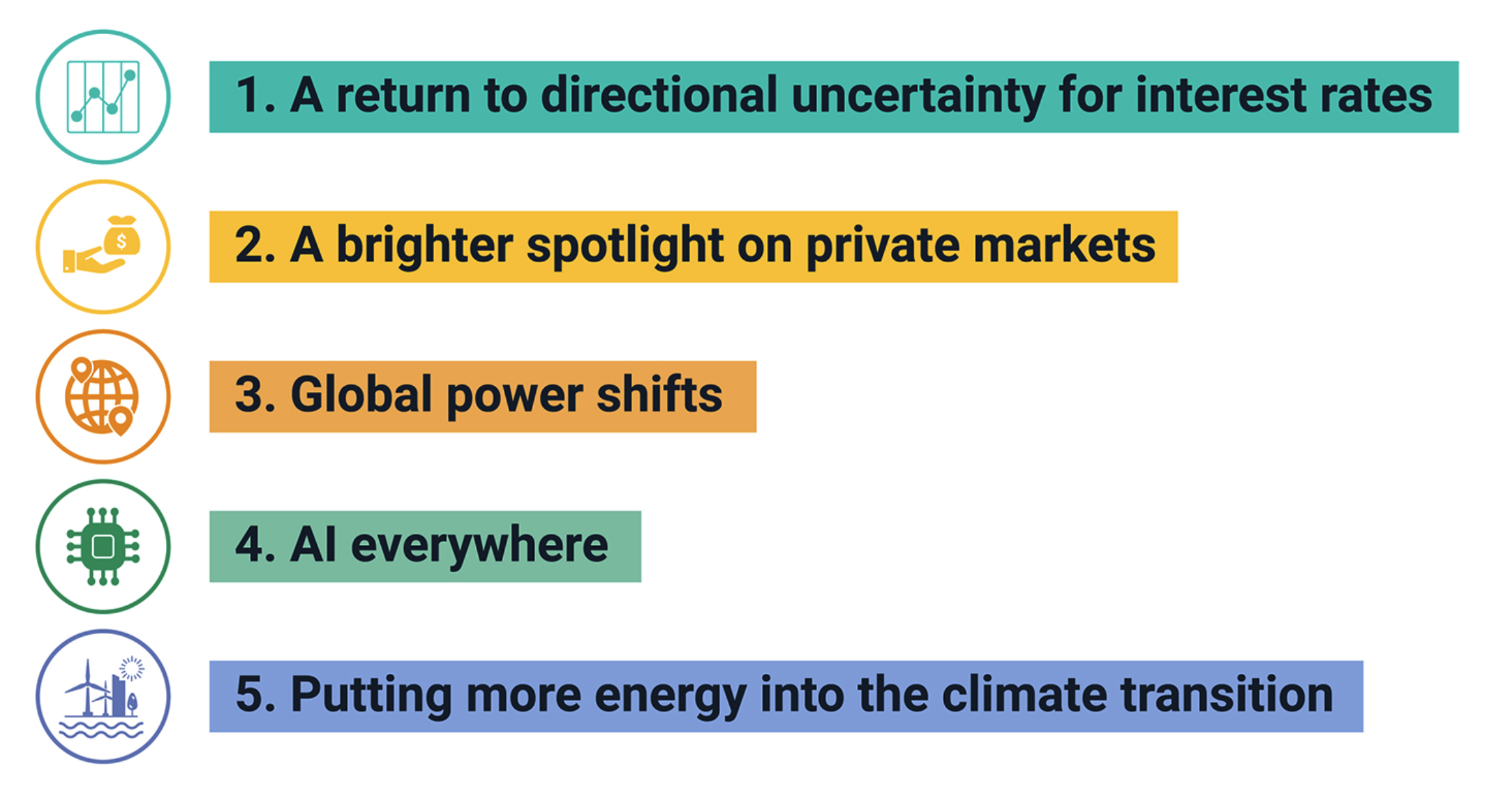
Investment Trends in Focus: Five Key Themes for 2024
2024 could be the year when major structural shifts in the economy start to have a significant effect on institutional and individual investors alike. MSCI remains committed to providing the data, models and tools that will help investors navigate both cyclical and structural challenges. With this backdrop, MSCI’s chief research officer, Ashley Lester and team have identified five key themes for this year. The macro backdrop will continue to dominate short-run concerns. But some major strategic shifts will be playing out simultaneously, including an acceleration in the growth of private credit, ongoing global power shifts, and the widespread deployment of artificial intelligence (AI). The long shadow cast by climate change lurks behind all these themes, with investors increasingly turning their attention towards the investment necessary to fund the transition. Jan 2, 2024
Source - read more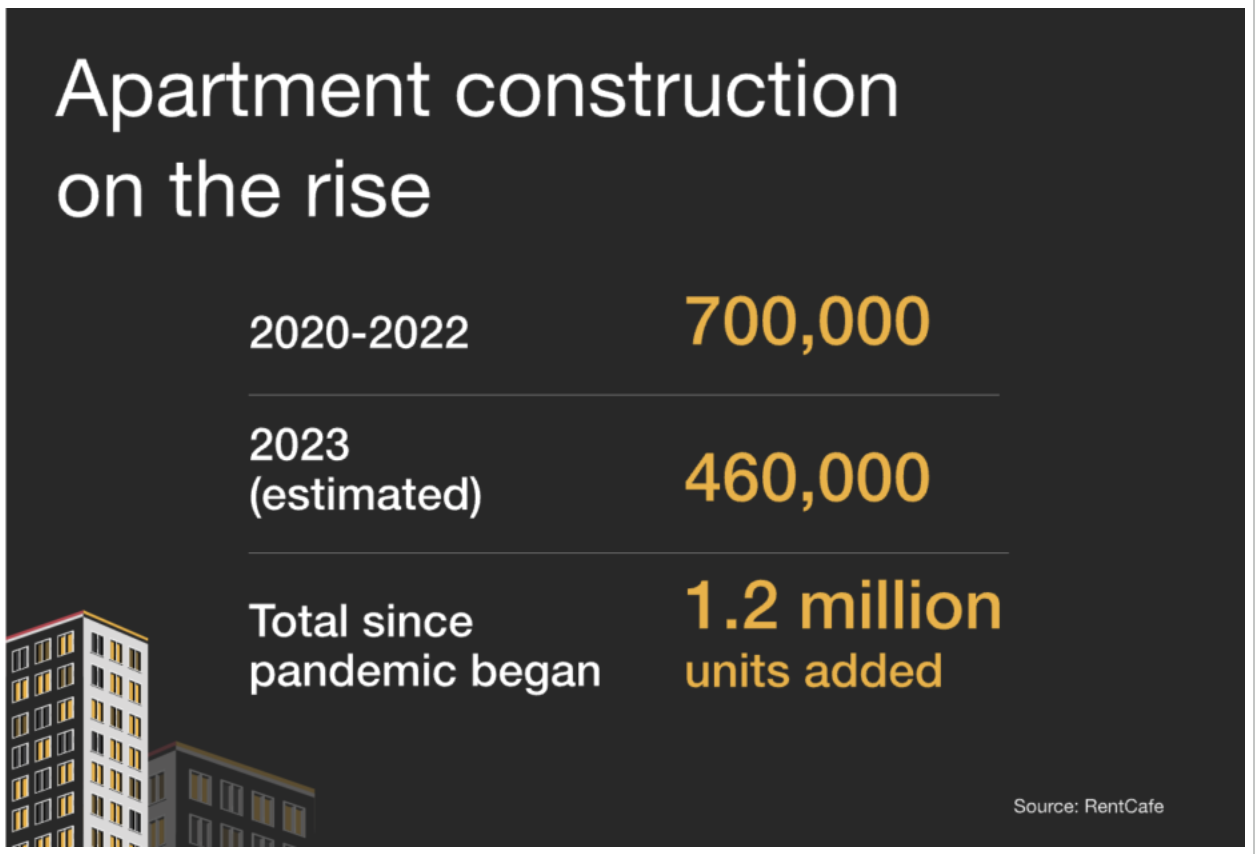
Housing Affordability Remains a Critical Concern
Industry leaders suggest it is time to let go of any notion that the real estate market will return to pre-pandemic conditions. Rather, according to PWC’s Emerging Trends in Real Estate report, pundits say they’ve accepted that a large number of Americans might not return to offices, a possibility that they say has “profound implications” not only for owners of commercial properties but also multifamily property owners as well as urban downtowns, other property sectors, and any neighborhood that depends on vibrant local office markets. Housing affordability remains a primary concern in today’s real estate market, according to the report, which last year noted that affordability had fallen to its lowest level in 30 years. “This year, it’s even worse, especially for homebuyers,” the authors note, adding that “a troubling combination of rising home prices and rapid increases in borrowing costs has put home purchases further out of reach for more people.” Jan 12, 2024
Source - read more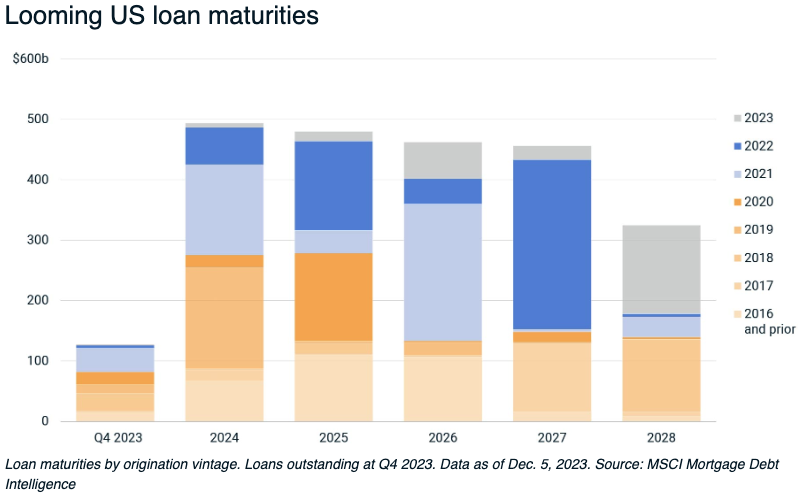
2024 Trends to Watch in Real Assets
The year 2023 was an especially tough one for real estate. Declines in asset valuations, which had begun in the second half of 2022 in many markets, proliferated across a broader range of markets through the rest of 2023. Transaction volume also continued to fall through the year, with dealmaking often paralyzed by the standoff between potential buyers and sellers on pricing. Investors will be hoping for a better 2024, where we find a floor in pricing that will return the market to more-normal levels of activity. When and how that happens remain to be seen. It may be through increased distress forcing sellers onto the market. Or we might eventually see interest rates start to fall, returning confidence to potential buyers. Whatever the details of exactly when and how we reach that point, the sudden market movements we’ve seen over the last 12 to 18 months have shifted the playing field. Investors are reassessing their real-estate allocations and strategies to mitigate significant risks but also exploit opportunities posed by this market dislocation. Dec 13, 2023
Source - read more
S&P/Case-Shiller U.S. National Home Price Index up
S&P/Case-Shiller U.S. National Home Price Index is at 312.31 for September 2023. This is up from a drawdown to 293.47 for February 2023. This followed an previous all time high of 308.30 in June of 2033. The index had increased every month since Feb 2012 until the draw down started in July 2022. Dec 18, 2023
Source - read more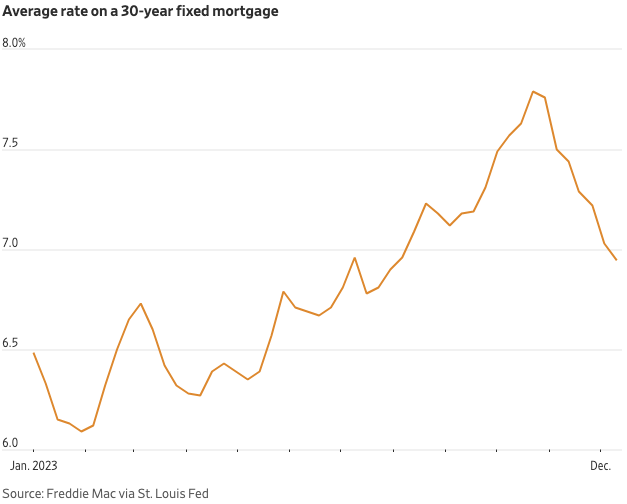
Home Buyers Are Ready to Buy. But Sellers Aren’t Selling
The lowest mortgage rates since the summer are starting to lure frustrated home shoppers back to the market. The problem is that few homeowners who have locked in much lower rates appear ready to sell. Home sales this year are on track to be the lowest since at least 2011. But as mortgage rates retreated from nearly 8% in October to below 7% last week, buyers are responding. Mortgage applications have increased for six straight weeks on a seasonally adjusted basis, though they are still down from year-ago levels, according to the Mortgage Bankers Association. Dec 17, 2023
Source - read more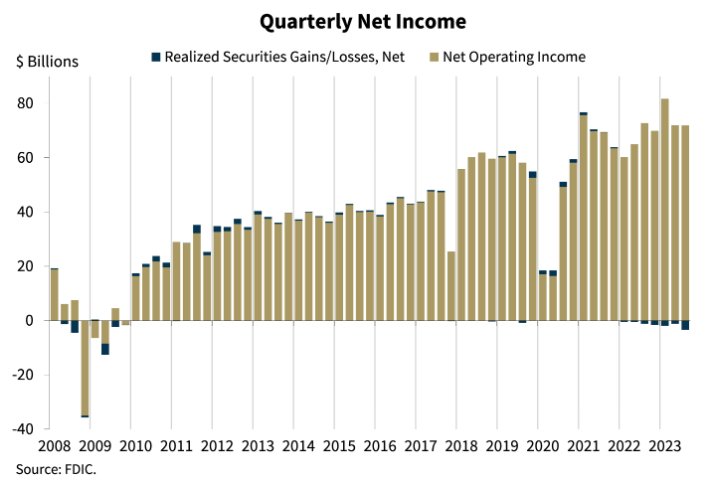
FDIC: Banking Industry strong but CRE a Significant Concern
The banking industry continued to show resilience in the third quarter. Net income remained high, overall asset quality metrics remained favorable, and the industry remained well capitalized. Despite a modest improvement in the industry’s net interest margin, funding pressures continued to challenge the industry. In the third quarter, the banking industry’s net income was $68.4 billion, a decrease of $2.4 billion from last quarter. But after adjusting for non–recurring accounting gains, the industry’s profitability has been remarkably stable for the past year. In the first two quarters of this year, the industry’s noninterest income was boosted by the accounting treatment of the acquisition of the three large failed banks. Without these non–recurring gains, net income would have been right around $68 billion—a high level by historical standards—for the past four quarters. Dec 8, 2023
Source - read more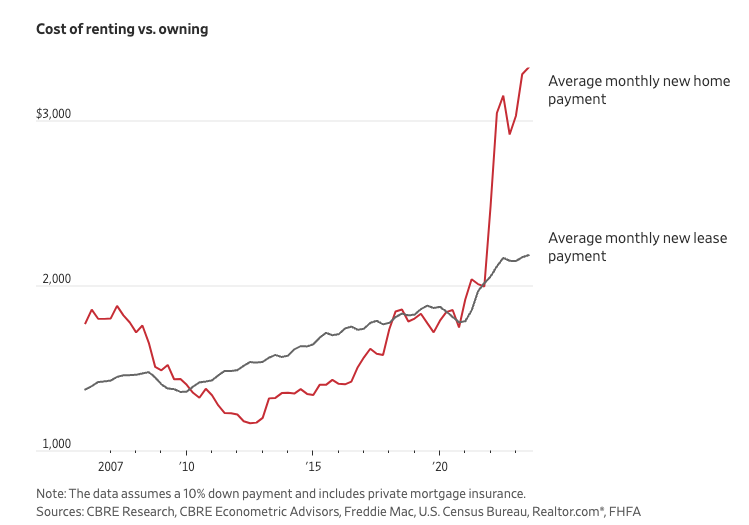
The Math for Buying a Home No Longer Works
Homeownership has become a pipe dream for more Americans, even those who could afford to buy just a few years ago. Many would-be buyers were already feeling stretched thin by home prices that shot quickly higher in the pandemic, but at least mortgage rates were low. Now that they are high, many people are just giving up. It is now less affordable than any time in recent history to buy a home, and the math isn’t changing any time soon. Home prices aren’t expected to go back to prepandemic levels. The Federal Reserve, which started raising rates aggressively early last year to curb inflation, hasn’t shown much interest in cutting them. Mortgage rates slipped to about 7% last week, the lowest in several months, but they are still more than double what they were two years ago. Dec 11, 2023
Source - read more
Apartment Owners Prioritizing Occupancy Over Rent
Apartment demand rebounded in 2023 after a dreadful year prior, especially during the second half of it, Cushman & Wakefield said. Therefore, “apartment operators today are prioritizing occupancy over rent,” its economist, Sam Tenanbaum said. There are 800,000 apartment homes currently under construction, which is about 5% of the country’s inventory, “so supply-side economics are expected to be a key theme for the next few years,” he said. Cushman & Wakefield’s most recent multifamily report said that despite an unprecedented supply wave, the multifamily market is enjoying a solid year, characterized by healthy rental demand and positive rent growth. Looking at vacancy rates alone, which steadily increased from an all-time low of 5.0% in 2021 to 7.8% as of Q3 2023, “would be suggestive of deteriorating market conditions, but it also masks favorable demand-side trends that have reemerged this year,” the report said. Dec 11, 2023
Source - read more
United States Industrial Outlook Q3 2023
Industrial fundamentals showed increasing signs of slowing in Q3 as the turbulent macroeconomic environment persists. With decreased leasing velocity and sluggish pre-leasing rates, absorption figures continued to slow. With the wave of new deliveries, the vacancy rate increased 70 basis points quarter-over-quarter to 4.9% as anticipated. While this figure seems high on the tail of historic low vacancy rates during the Covid era, the current figure is below the historical average which was 7.7% in 2013. Nov 08, 2023
Source - read more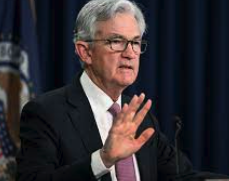
The Fed Says Best Not to Get Too Optimistic Right Now
In the minutes of the last Federal Open Market Committee’s meeting, held from October 31 to November 1, the overall take was, “Financial conditions continued to tighten, driven by higher yields on Treasury securities as well as by lower equity prices and a stronger dollar, which themselves partly reflected higher interest rates.” Nov 22, 2023
Source - read more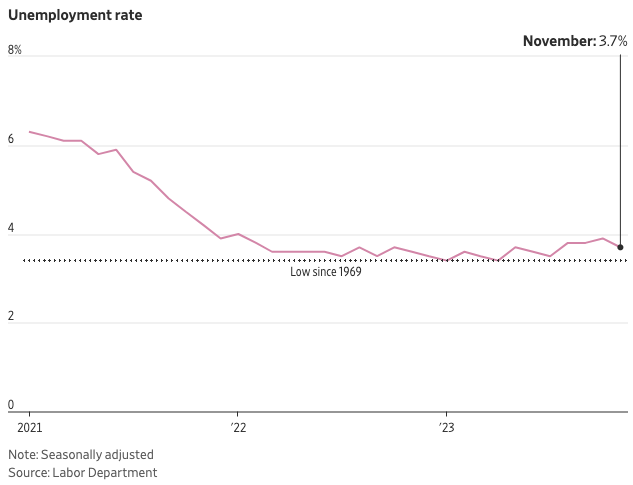
Economy’s Soft Landing Comes Into View as Job Growth Slowly Descends
A gradual cooling of the still-solid labor market extended into November, renewing optimism the economy is still on a glide path for a soft landing. Employers added a seasonally adjusted 199,000 jobs last month, the Labor Department reported Friday, slower than earlier in the year but consistent with gains before the pandemic. When excluding the effects of autoworker strikes in recent months, November’s job gain was roughly 169,000, slightly cooler than 180,000 in October. Most recent hiring occurred in two big sectors: healthcare and the government. Dec 8, 2023
Source - read more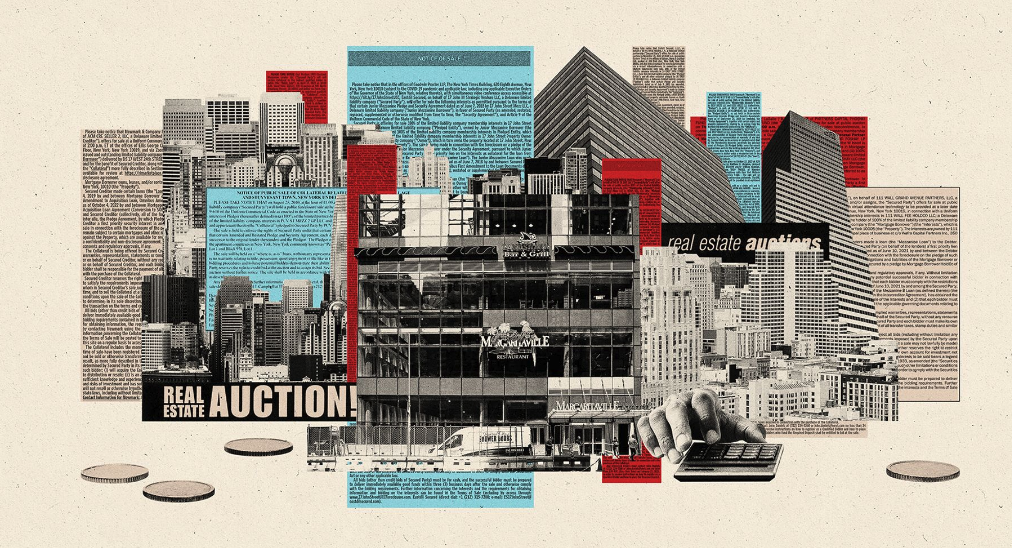
The Clearest Sign Yet That Commercial Real Estate Is in Trouble
Foreclosures are surging in an opaque and risky corner of commercial real-estate finance, offering one of the starkest signs yet that turmoil in the property market is worsening. Lenders this year have issued a record number of foreclosure notices for high-risk property loans, according to a Wall Street Journal analysis. Many of these loans are similar to second mortgages and commonly known as mezzanine loans. November 13, 2023
Source - read more
Biden-Harris Administration Takes Action to Create More Affordable Housing by Converting Commercial Properties to Residential Use
Today, the Biden-Harris Administration is announcing new actions to support the conversion of high-vacancy commercial buildings to residential use, including through new financing, technical assistance, and sale of federal properties. These announcements will create much-needed housing that is affordable, energy efficient, near transit and good jobs, and reduce greenhouse gas emissions, nearly 30 percent of which comes from the building sector. Nov 8, 2023
Source - read more
United States Retail Outlook Q3 2023
Despite concerns over inflation and high-interest rates, retail sales continue to grow. However, leasing activity is constrained by the limited availability of desirable retail space, higher operating costs, labor shortage, and increased interest rates. Retail real estate is experiencing a significant shortage of available space, with the availability rate below historical averages. M&A transactions buoyed retail capital markets activity, while power center deliveries remained low, leading to low vacancy rates and steady rent gains. Overall, there is a shift in consumer spending towards experiences and the need for retailers to adapt to changing consumer behavior. November 7, 2023
Source - read more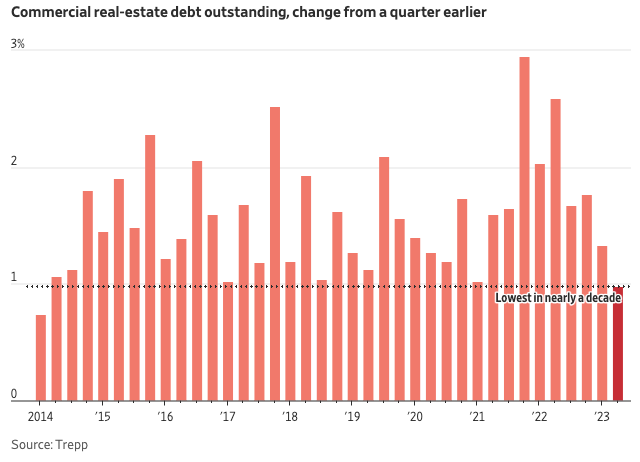
The Money Has Stopped Flowing in Commercial Real Estate
Commercial real-estate lending is shrinking to historically low levels, threatening a rise in defaults on expiring debt and a sharp decline in new construction of warehouses, apartments and other property types. Banks, insurance companies and other commercial property lenders have been cutting back since the first half of 2022 when the Federal Reserve began increasing interest rates and recession concerns intensified. But creditors have been even more reluctant to make new loans as Treasury bond yields have soared since early August. October 31, 2023
Source - read more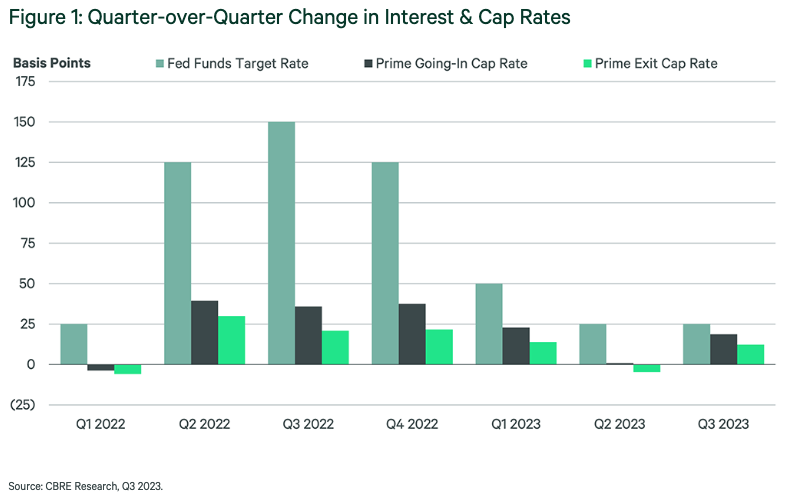
Higher Rates Push Up Prime Multifamily Cap Rates in Q3
Both going-in and exit cap rates for prime multifamily assets increased slightly in Q3 after the Federal Reserve’s 25-basis-point interest rate hike in July and the steady rise in the 10-year Treasury rate during the quarter. Although we expect that cap rates likely are near their peak, they could increase slightly into early 2024 if rates continue to rise. The average prime multifamily going-in cap rate has increased by 155 basis points (bps) to 4.92% since Q1 2022, exceeding the pre-pandemic 2018-2019 average by 70 bps. Though some additional expansion is likely, particularly if the Fed raises rates again in November or long-term rates continue to climb, underwriting assumptions for prime multifamily assets are likely nearing their peak. October 5, 2023
Source - read more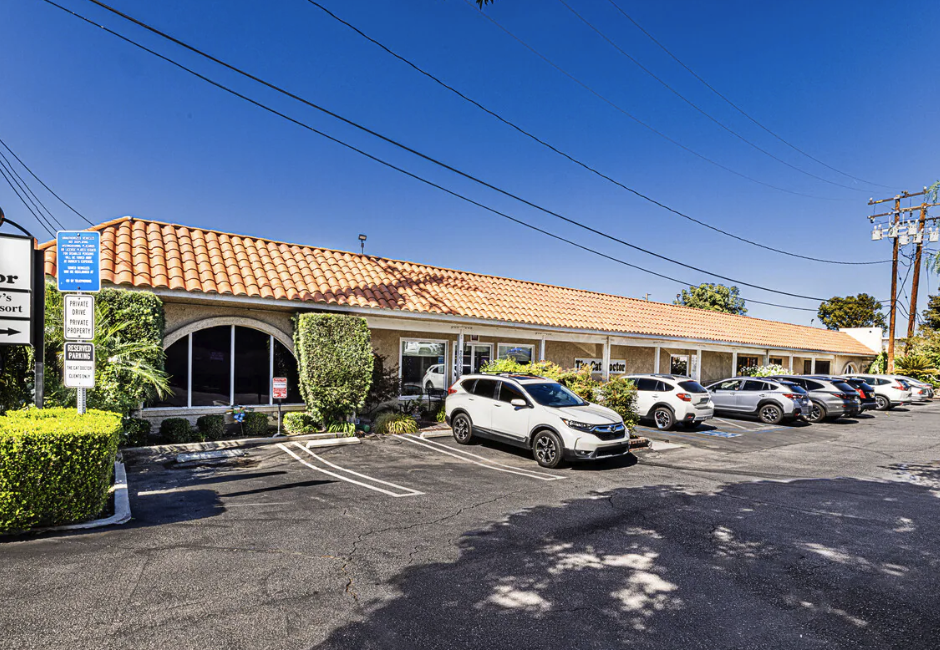
Strip Malls Are the New King of Retail Real Estate
A major shopping-center owner is spinning off all its strip malls into a new publicly traded company, indicating that this property type is thriving under a hybrid work environment. SITE Centers, which owns and manages open-air shopping centers in affluent suburbs, is placing 61 strip-mall properties into a real-estate investment trust called Curbline Properties, company executives said Monday afternoon. This new company will own and manage all of SITE Centers’ strip malls, which aren’t anchored by a grocery or big-box store. SITE Centers said it is valuing Curbline at $1.7 billion. October 30, 2023
Source - read more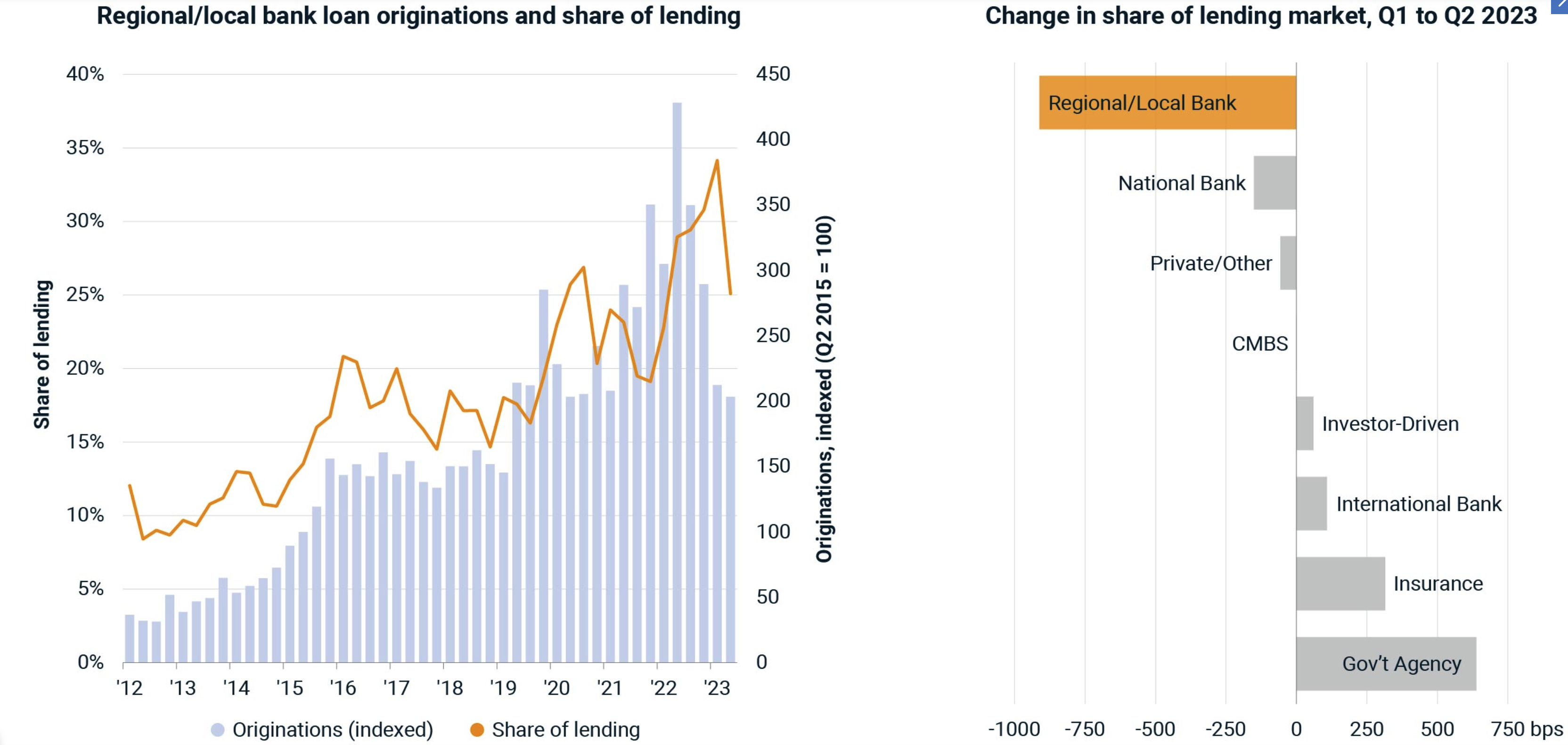
Small Banks Falter in US Commercial-Property Lending
Smaller U.S. banks retreated from commercial-real-estate (CRE) lending in Q2 of 2023. From a record high of 34.2% of all commercial-mortgage originations in the first quarter of 2023, these regional/local banks captured only 25.1% of the market in the second quarter. Never has the share of lending by these smaller banks fallen so sharply in a single quarter. The share of all CRE loans originated by regional/local banks fell 900 basis points (bps) in the second quarter. The next sharpest decline was 650 bps in Q4 of 2020. These smaller banks had consistently captured an average of 17% of the market for loans from 2015 to 2019, before their share surged into the COVID-19 era. October 2, 2023
Source - read more
Soft Landing Still Possible for U.S. Economy: Moody’s
A soft landing is still possible as the US economy enters a transition phase, a leading CRE analyst told attendees at the GlobeSt Fall Net Lease conference last week in Los Angeles. “The economy will transition,” Natalie Ambrosio Preudhomme, associate director at Moody’s Analytics, said Tuesday. “There will be further softening, but no cliff. We expect to see a small increase in growth in the near term.” October 23, 2023
Source - read more
October 2023 Commercial Real Estate Market Insights
In the final quarter, there is usually the opportunity to end a year and start the next year strong. Although the third quarter of the year has already ended, there is still much uncertainty in the market since the Federal Reserve continues its tightening monetary policy. The labor market remains firm, and the U.S. economy grows faster than the expectations. However, risks are still anticipated in the market as the full impact of the Federal Reserve's higher rates may not have been fully reflected yet in households and businesses. October, 2023
Source - read more
Do Not Fear the Impact of AI on Commercial Real Estate
Do Hype over the negative impact of AI on commercial real estate is on the rise. To hear some commentary, we should be welcoming our new robot overlords in the hopes that they will deign to give us menial jobs since all knowledge-driven activity will be replaced by machines. Forget about debates over the return to office — such a worst-case scenario caused by AI could be far more devastating to office demand. There are other, more hopeful views on the future, however, which could spell out even more demand for commercial real estate as AI gains a foothold in the economy. August 22, 2023
Source - read more
Six Office Markets That Have Seen Growth This Year
The office market may have its problems, but not everywhere according to a recent Green Street weekly institutional marketplace update that included data on how certain property types were doing by major metro in a year-over-year look at the first half of 2023 and 2022. Though while there is good news for some, there’s bad news for more. Office has likely been one of the most followed property types of late for no other reason than uncertainty about how it would do. Hybrid work, companies considering how they might cut back on real estate use and cost, all are raising questions of how many investors or existing property owners and managers want to pick up more office buildings. September 5, 2023
Source - read more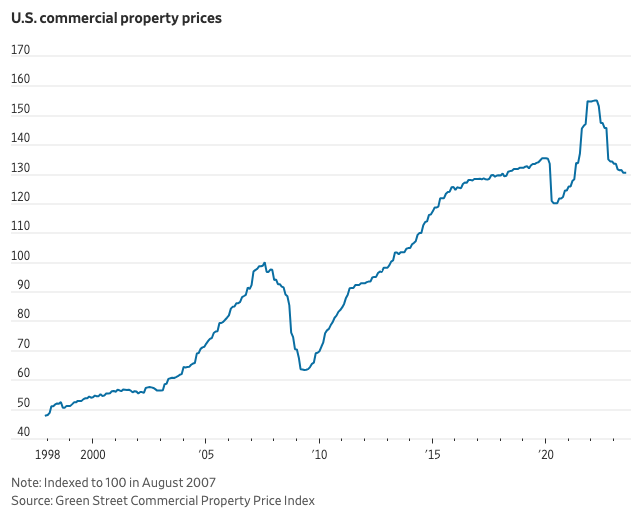
How to Play the Property Meltdown in Five Charts
Is the pain over yet for U.S. commercial real estate? The answer might be yes for stocks but no for the assets they own. A record $205.5 billion of cash is earmarked for investment in U.S. commercial real estate, according to dry-powder data from Preqin. But good deals may not be available for another six to 12 months. Here are some trends investors can watch for signs of when it is the right time to buy. August 30, 2023
Source - read more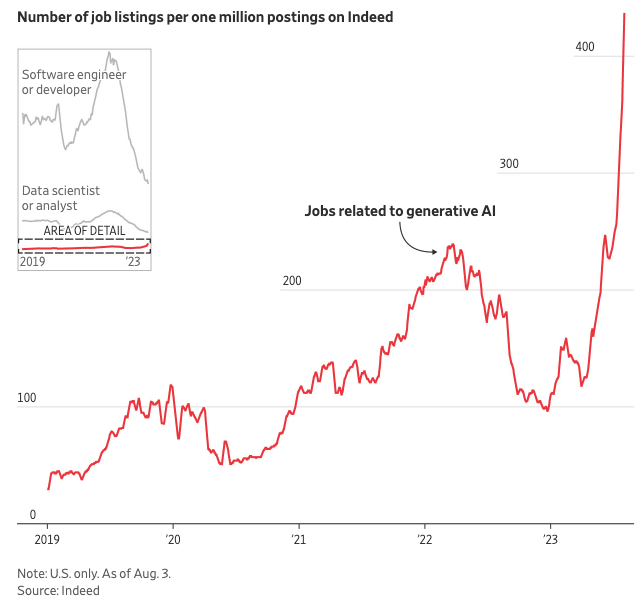
The $900,000 AI Job Is Here
American companies are in the midst of an AI recruiting frenzy, and some are willing to pay salaries approaching seven figures to hire top talent. Firms in industries such as entertainment and manufacturing are racing to seize on the potential of artificial intelligence by wooing data scientists, machine-learning specialists and other practitioners skilled at deploying the technology. The rush to hire is pushing up pay for technical professionals and prompting companies to hone their pitches to applicants to avoid losing out to rivals. Some companies, including Accenture, are building their AI expertise through individual hires and internal training programs. Others, including the technology company ServiceNow, say they are open to acquiring smaller AI startups as a way to scoop up talent. August 14, 2023
Source - read more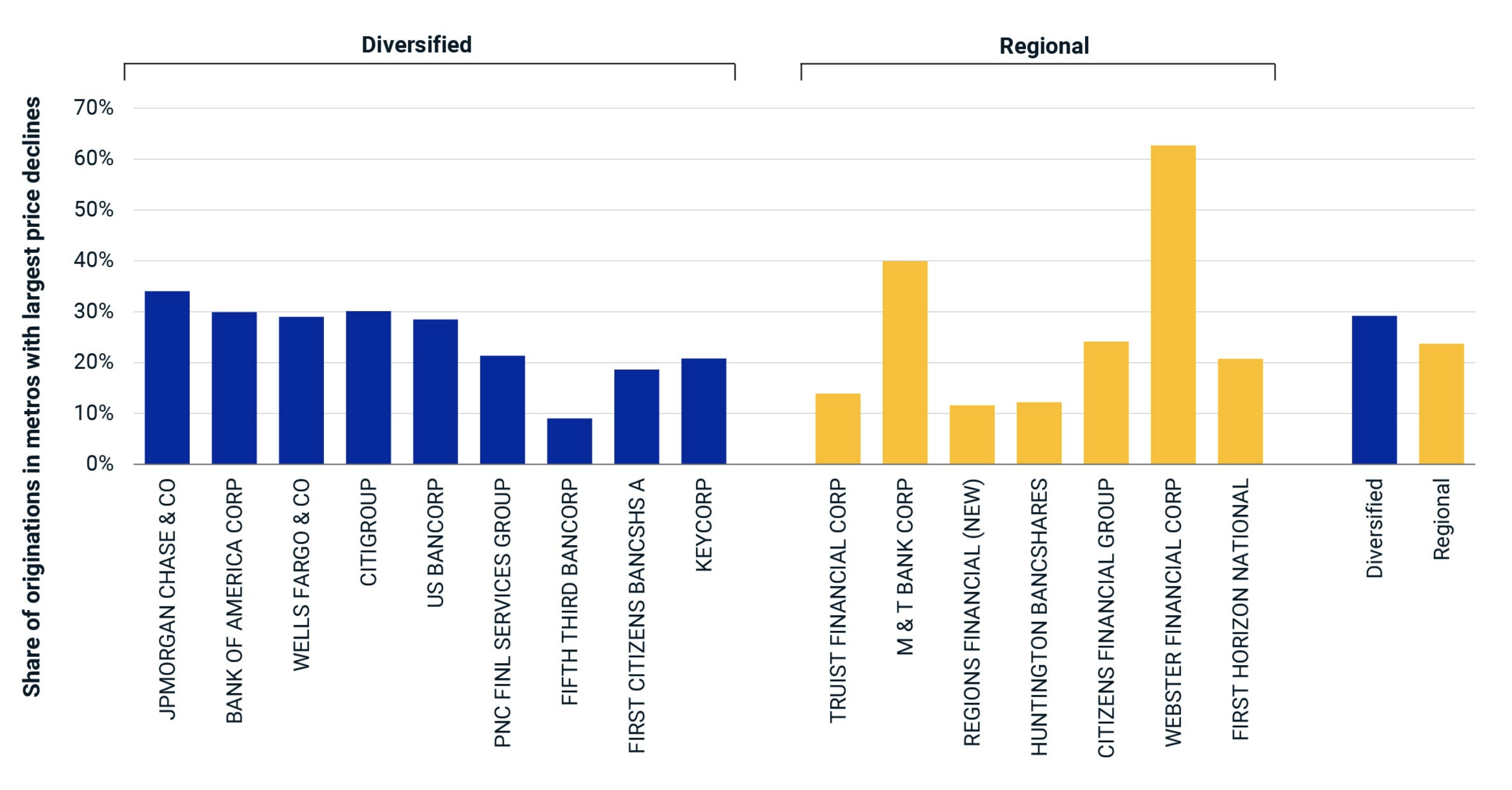
Banking on Commercial Real Estate
Worries about U.S. banks' exposure to souring commercial-property loans have weighed on bank stocks, particularly regional ones. In the four months following the collapse of two lenders in March (and another failure in May), the MSCI USA Banks Index fell 15%, compared to a 12% increase for the MSCI USA Index.1 Using data from MSCI Mortgage Debt Intelligence, we examined the commercial-mortgage originations of the seven regional banks and nine diversified banks in the MSCI USA Banks Index to identify exposures to the property types and markets under pressure. August 3, 2023
Source - read more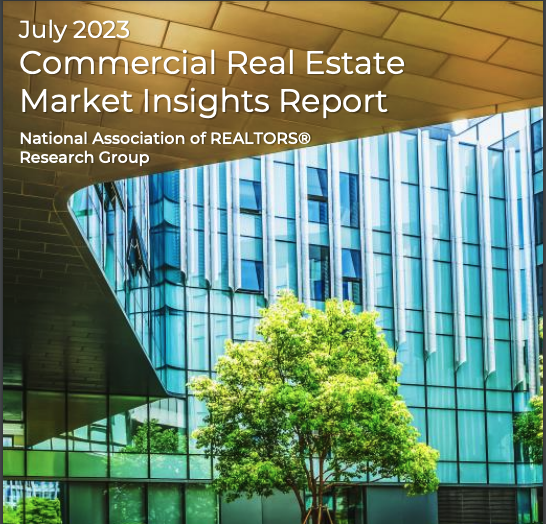
July 2023 Commercial Real Estate Market Insights
Leasing velocity slowed down in commercial real estate during the year's second quarter. While there is still much uncertainty about the total impact of the bank failures earlier in the year, there are rising concerns and speculation about where commercial real estate is headed. Since commercial real estate relies heavily on small banks for capital, a pullback in lending among these banks could further impact commercial real estate. However, data shows that commercial real estate lending activity is increasing weekly. Meanwhile, delinquency rates for commercial loans have increased since the end of 2022, but they remain below 1%. Nevertheless, delinquencies are expected to rise further in the year's second half. July 2023
Source - read more
S&P/Case-Shiller Home Price Index down
The S&P/Case-Shiller US National Home Price Index showed a decrease in home values from June 2022 to January 2023 of 15.60 points. The Index has rebounded slightly +8.33 points as of April 2023. June 27, 2023
Source - read more
Green Street Lowers Its Office Valuations. Again.
Plunging office valuations are creating challenges for analyst firms when assessing how low will they go. A Green Street office report from June 28 states as such, adding that additional signs now indicate the firm’s estimates are too high – despite already marking down A-quality office values several times this year. Green Street’s Commercial Property Price Index for REIT-quality office assets “has already been marked down 30% from pre-Covid highs prior to this recent reduction.” The report indicated that conversations with private market participants suggest at least another 5%-10% decline on average is reasonable, adding that “this varies significantly by market,” authors Dylan Burzinski and Michael Manos, wrote. June 30, 2023
Source - read more
Are we headed towards recession? If so, how long and how bad will it be?
Cushman & Wakefield's Glide Path report: Comments from the Microeconomy section: We’re not quite “there yet” on inflation; underlying pressure remains for some of the stickier portions of inflation. Fed will remain cautious and data-dependent before prematurely cutting. Expect the Fed to pivot in early 2024. Economy remains resilient due to the ongoing strength of the consumer and labor markets. Recession timing keeps getting pushed back, now expect a year-end start. Economic recession will run its course through Q3 2024. The correction in CRE started mid-2022; this is not the first inning. Recovery speeds will vary based on property type, quality and geography, but a rebound is not far off. Historically, the best time to buy property is when the Fed starts to cut rates (this tends to coincide with a bottoming and inflection in property values). June 2023
Source - read more
Looking for Loan Trouble
Refinancing commercial-property loans has become tougher because of an increase in interest rates and more-conservative lending terms. Different trends in asset-price growth and loan-to-value ratios mean that not all asset classes and markets will face pressure equally. Using a high-level estimation based on value growth and loan terms, one can home in on the market and asset-class combinations that may face more trouble. Investors in commercial real estate are alternatively worried or excited about the repricing of assets over the last year. Those who are excited are trying to determine which assets are most likely to default and may be available on the cheap. The answer may lie in the timing of loan maturities. June 2, 2023
Source - read more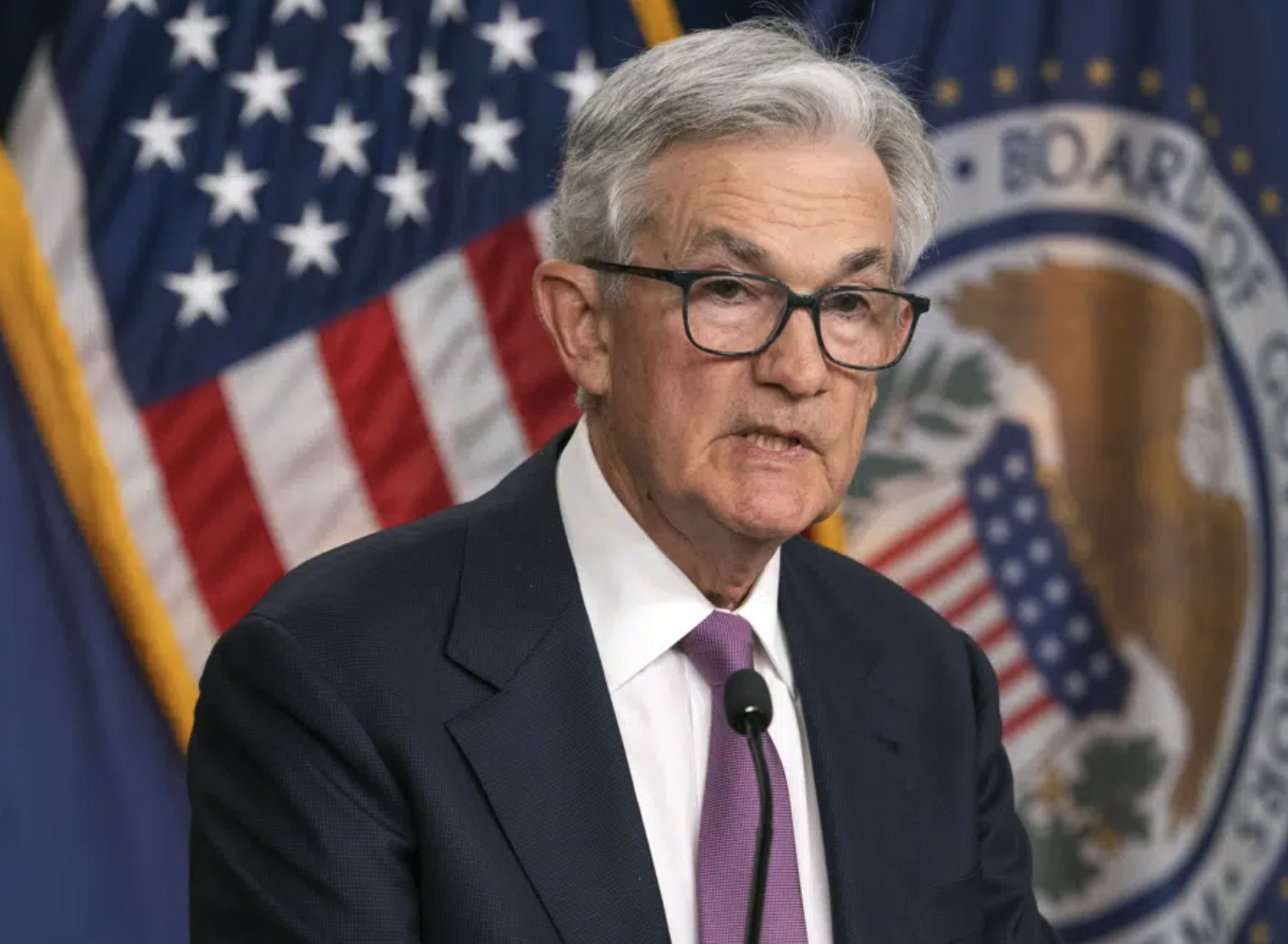
Fed Chair Powell sees progress on inflation, though not quickly enough
WASHINGTON (AP) — Inflation may be cooling — just not yet fast enough for the Federal Reserve. Chair Jerome Powell offered a nuanced view Wednesday of how the Fed intends to address its core challenge at a time when inflation is both way below its peak but still well above the central bank’s 2% target: Give it more time, and maybe some help from additional interest rate hikes. Yet on a hopeful note, Powell also suggested that the trends that are needed to further slow inflation, from lower apartment rents to slower-growing wages, are starting to click into place. As a result, the Fed decided Wednesday to forgo another increase in its benchmark interest rate, leaving it at about 5.1%. The pause followed 10 straight hikes in 15 months — the fastest series of increases in four decades. June 14, 2023
Source - read more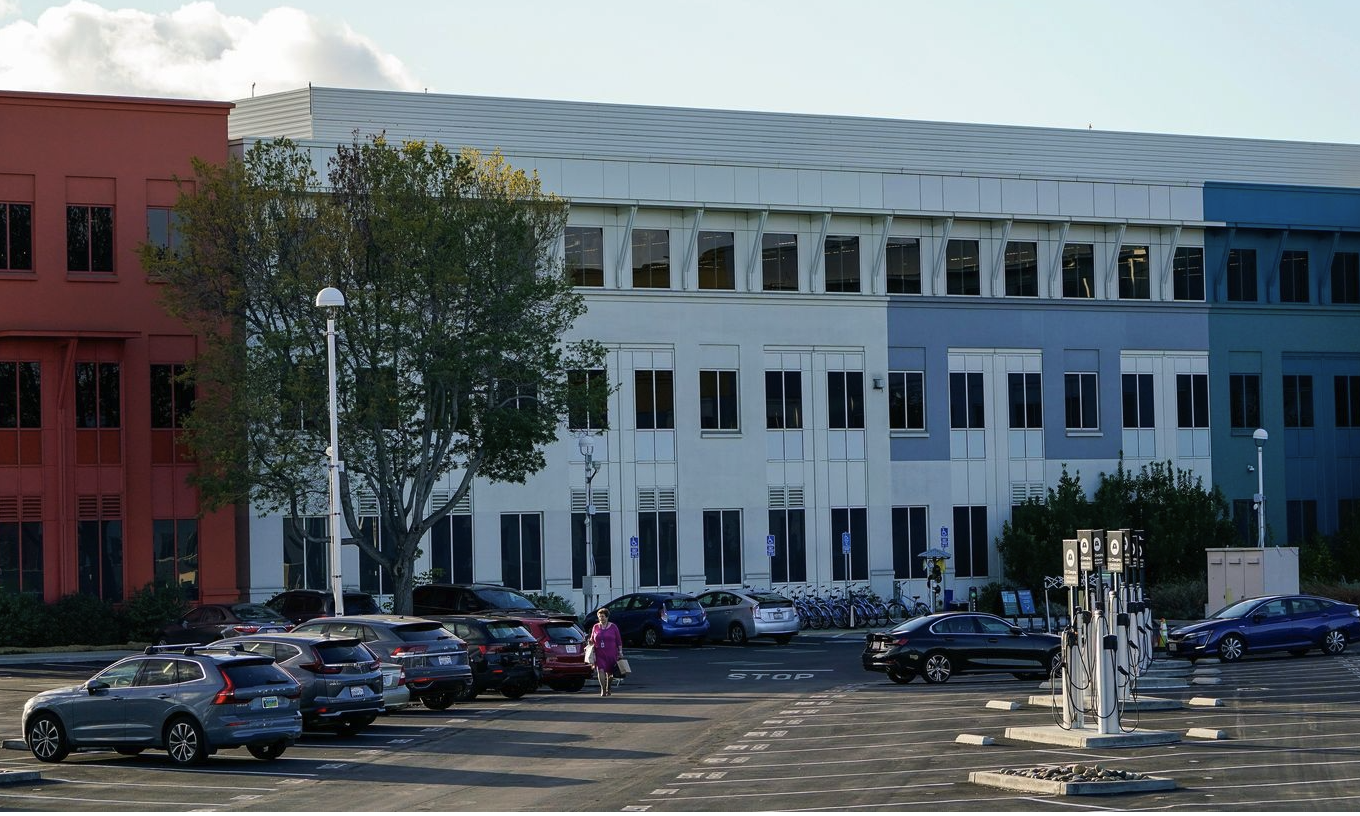
Vacant Offices Are Piling Up in Silicon Valley
Silicon Valley companies are dumping office space at an accelerating pace, as tech leaders such as Google and Facebook parent Meta Platforms close locations and reassess their commitments to the workplace. Office-vacancy rates in Silicon Valley, which includes the Northern California communities of San Jose, Palo Alto and Sunnyvale, were up to 17% in June from 11% in 2019, according to data firm CoStar Group. In some spots, such as Menlo Park and Mountain View, the rate surpassed 20% this spring, CoStar said. June 21, 2023
Source - read more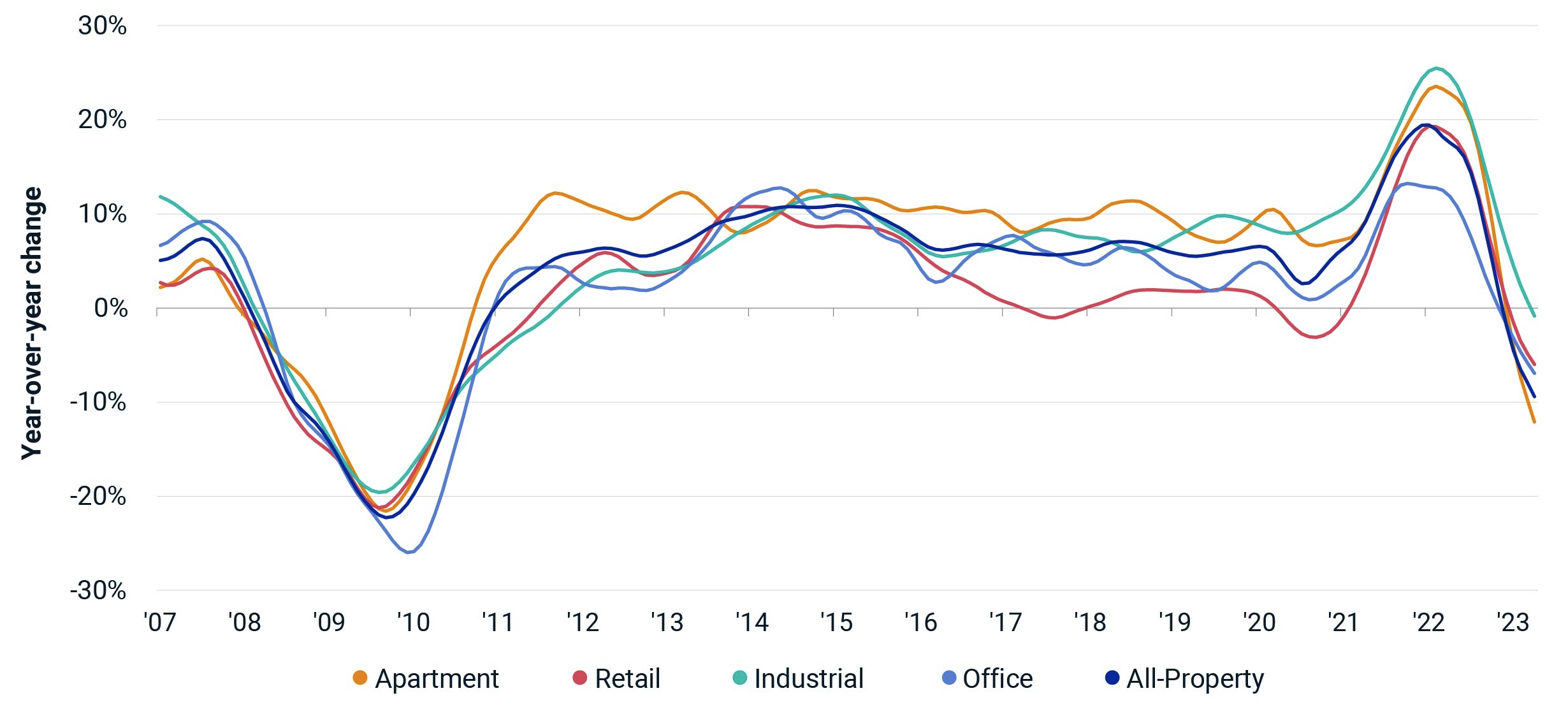
Prices of All Major US Property Types Fell in April
All major U.S. commercial-property types posted annual price declines in April, marking the first time since September 2010 that prices fell across the board. The industrial index had held out until April, when it experienced both monthly and annual price drops. Industrial prices slipped by 0.5% on the month and fell 0.8% versus a year earlier. The RCA CPPI National All-Property Index fell 1.1% relative to March and dropped 9.4% from April of 2022, dragged down by the slide in apartment prices. May 26, 2023
Source - read more
JPMorgan Chase: Plenty of Big Questions for Commercial Real Estate
Economic uncertainty remains high for commercial real estate through the rest of 2023, reported JPMorgan Chase & Co., New York. “There are plenty of big questions, including the interest rate environment and the future of office space,” said JPMorgan Chase & Co. Head of Commercial Real Estate and Commercial Banking Al Brooks in the firm’s 2023 Midyear Commercial Real Estate Outlook. “But there are also positives: multifamily and industrial continue to perform well, and the industry may have underestimated the strength of neighborhood retail.”May 24, 2023
Source - read more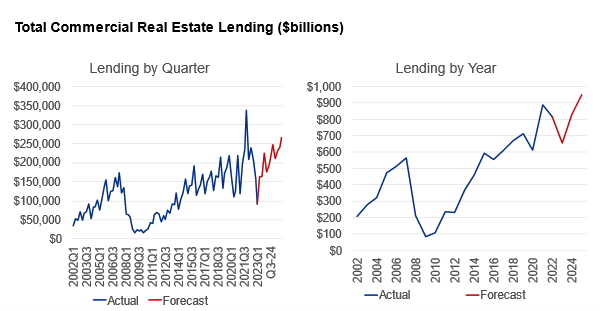
MBA Forecast: Commercial/Multifamily Lending to Fall 20 Percent in 2023
WASHINGTON, D.C. (May 11, 2023) — Total commercial and multifamily mortgage borrowing and lending is expected to fall to $654 billion this year, which is a 20 percent decline from $816 billion in 2022. This is according to an updated baseline forecast released today by the Mortgage Bankers Association (MBA) at its 2023 Commercial/Multifamily Finance Servicing & Technology Conference in Chicago. Multifamily lending alone (which is included in the total figures) is expected to drop to $375 billion in 2023 – a 14 percent decline from last year’s expected total of $437 billion. MBA anticipates borrowing and lending will rebound in 2024 to $829 billion in total commercial real estate lending, with $456 billion of that total in multifamily lending. May 11, 2023
Source - read more
United States Retail Outlook Q1 2023
Retail fundamentals have started to pull back as a consequence of sustained inflation and banking troubles. Consumers have responded to persistent inflation by shifting money away from discretionary goods purchases in favor of groceries and other key necessities. Discounters and online retailers win consumers’ dollars, as real disposable income wanes. Net absorption totaled a modest 9.1 million square feet for the quarter – a substantial decline from the 20.1 million square feet absorbed in the fourth quarter. Demand is still coming largely from discounters like Burlington and dollar stores, as well as QSRs and fast casual restaurants. In fact, aggressive expansion by QSRs and coffee chains have contributed to a record-low availability rate of single-tenant retail space at just 2.4%. May 9, 2023
Source - read more
A Guide to Valuing Buildings Amid Less Debt and Changing Cap Rates
It’s no secret that as we sit here in May of 2023, there has been a significant deterioration of values across asset classes in commercial real estate. In fact, I haven’t been in a meeting or on a call in the past several months where the level to which prices have fallen has not been a topic of conversation. Questions about office buildings dominate these discussions since their value has clearly decreased the most and some of the basic going forward assumptions are a guess at this point. Time will give us the answer of course, but by simply looking at some big picture metrics we can start to get a sense, which gives us a lot to think about. May 22, 2023
Source - read more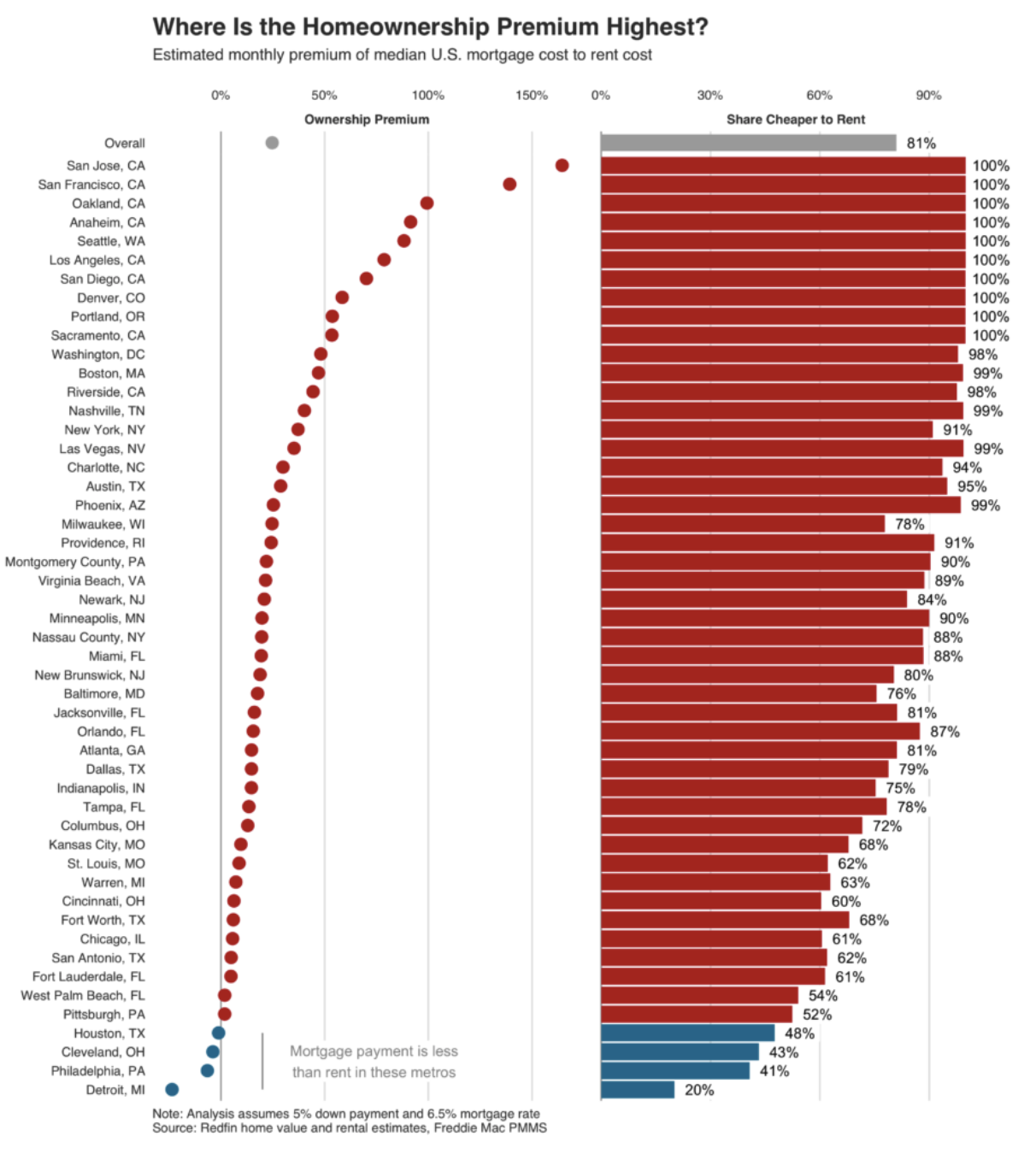
Metro Areas Where Homebuying Is Cheaper Than Renting Dwindling Nationwide
According to a new report from Redfin, there are only four major U.S. metropolitan areas where it would be cheaper to buy than rent the typical home—meaning the typical home has an estimated monthly mortgage cost lower than its estimated monthly rental cost. Key Findings: Buying is more affordable than renting in Detroit, Philadelphia, Cleveland, and Houston. The largest homeownership premium is in the Bay Area, where it’s twice as expensive to buy than rent. Nationwide, the typical home costs an estimated 25% more per month to own than rent. A drop in mortgage rates would cause the homeownership premium to shrink. If rates fell to 5%, buying the typical home would only cost an estimated 10% more than renting it. May 22, 2023
Source - read more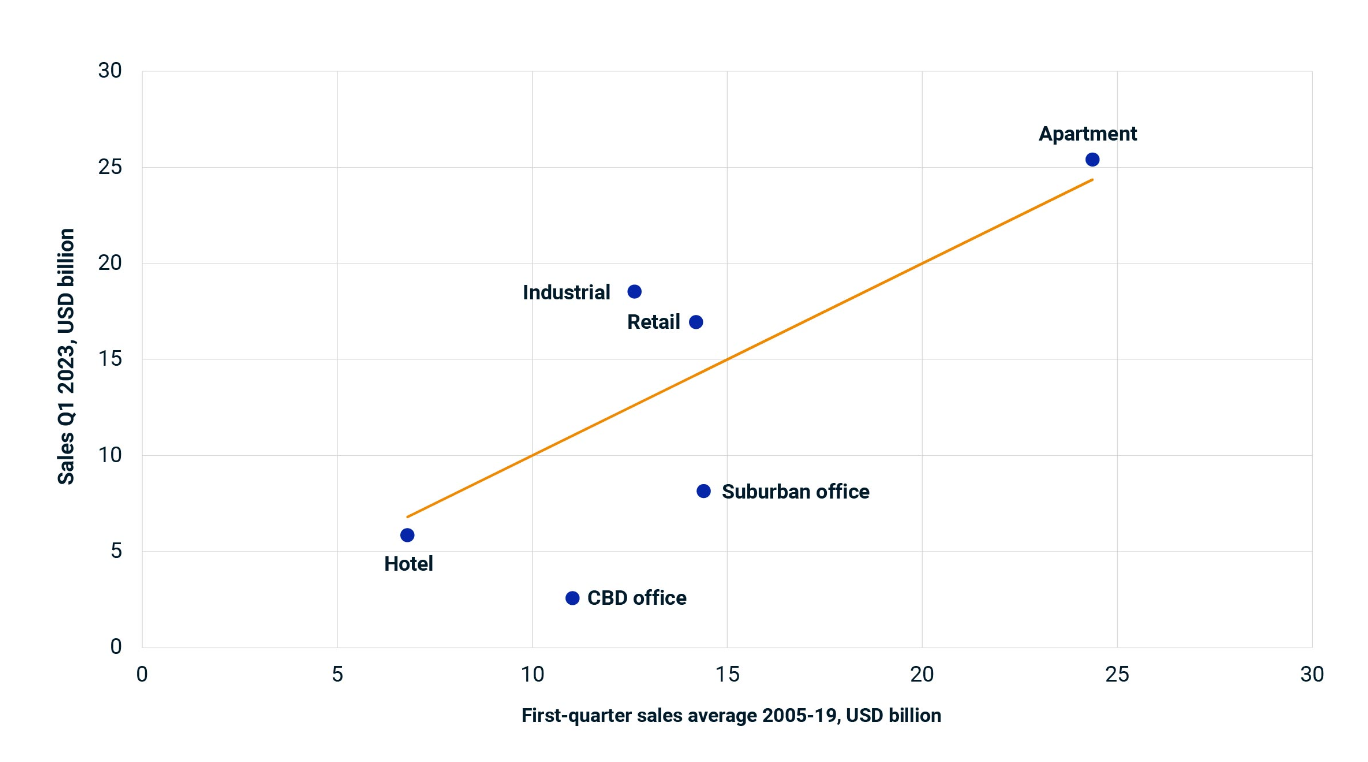
Different Takes on US Commercial-Property Sales in Q1
Deal activity for U.S. commercial property in the first quarter could be viewed as a sign of a calamitous market downturn ahead or a simple return to long-run averages after a period of excess liquidity. One’s viewpoint may differ across property types. Relative to Q1 2022, which was the most active first quarter on record, sales across property types fell 56% to USD 85 billion. The total was broadly in line with long-term pre-pandemic levels: Sale activity averaged USD 88 billion for each first quarter from 2005 to 2019. Office sales in both central business districts (CBD) and suburban locations were well down from the long-term trend, however, as shown in the chart. (Property types below the line saw less deal activity this year than the average first-quarter period over time.) CBD offices fared worse, with deal volume 77% below the average. Retail property sales were 19% higher in the first quarter than the pre-pandemic average, thanks to a one-time entity-level deal. April 21, 2023
Source - read more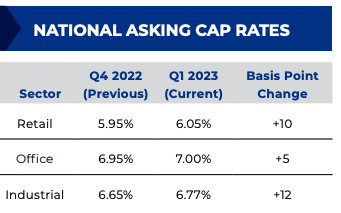
The Boulder Group Q1 23 Net Lease Market Report
Cap rates in the single tenant net lease sector increased for the fourth consecutive quarter within all three sectors in Q1 2023. Single tenant cap rates increased to 6.05% (+10 bps) for retail, 7.00% (+5 bps) for office and 6.77% (+12 bps) for industrial in Q1 2023. Cap rates in Q1 2023 represented the highest levels since Q3 2020 for both the single tenant retail and office sectors. A decrease in transaction volume for the greater real estate market continues to limit 1031 exchange buyers transitioning into net lease properties. Transaction volume in 2022 lagged 2021 and experienced more than a 25% decrease for the net lease sector. Q1, 2023
Source - read more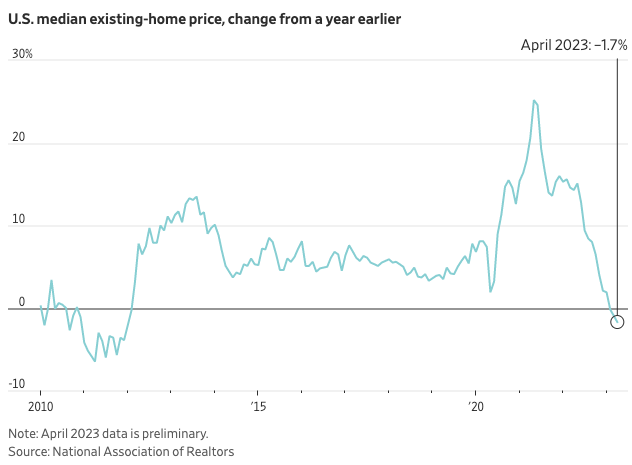
Home Prices Posted Largest Annual Drop in More Than 11 Years in April
Sales of previously owned homes fell in April from the prior month and prices declined from a year earlier by the most in more than 11 years. U.S. existing home sales, which make up most of the housing market, fell 3.4% in April from the prior month to a seasonally adjusted annual rate of 4.28 million, the National Association of Realtors said Thursday. April sales fell 23.2% from a year earlier. The national median existing-home price fell 1.7% in April from a year earlier to $388,800, the biggest year-over-year price decline since January 2012, NAR said. Median prices, which aren’t seasonally adjusted, were down 6% from a record $413,800 in June. Home prices have fallen the most in the western half of the U.S., while prices continue to rise from a year earlier in many eastern markets. May 18, 2023
Source - read more
Existing-Home Sales Surged 14.5% in February, Ending 12-Month Streak of Declines
Existing-home sales jumped 14.5% in February to a seasonally adjusted annual rate of 4.58 million, snapping a 12-month slide and representing the largest monthly percentage increase since July 2020 (+22.4%). Compared to one year ago, however, sales retreated 22.6%. The median existing-home sales price decreased 0.2% from the previous year to $363,000. The inventory of unsold existing homes was unchanged from the prior month at 980,000 at the end of February, or the equivalent of 2.6 months' supply at the current monthly sales pace. March 21, 2023
Source - read more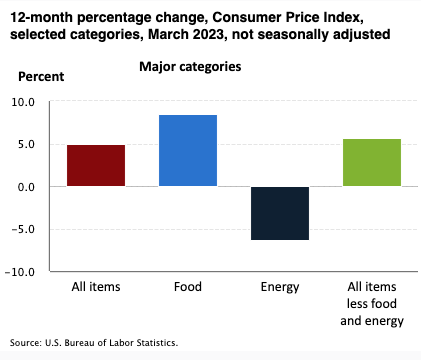
CPI for all items rises 0.1% in March as shelter increases
The Consumer Price Index for All Urban Consumers (CPI-U) rose 0.1 percent in March on a seasonally adjusted basis, after increasing 0.4 percent in February, the U.S. Bureau of Labor Statistics reported today. Over the last 12 months, the all items index increased 5.0 percent before seasonal adjustment. The index for shelter was by far the largest contributor to the monthly all items increase. This more than offset a decline in the energy index, which decreased 3.5 percent over the month as all major energy component indexes declined. The food index was unchanged in March with the food at home index falling 0.3 percent. April 12, 2023
Source - read more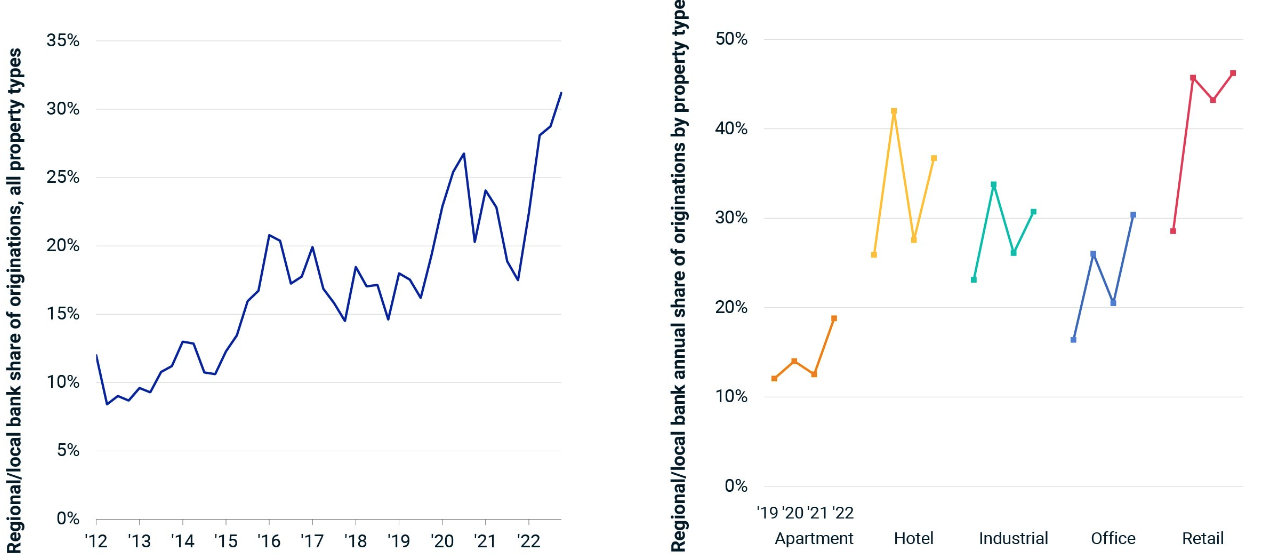
Commercial-Property Debt Not Just a Small Bank Story
Recent industry chatter suggests that smaller banks are behind 70% of all commercial-real-estate lending in the U.S. Such exposure would have worrying implications for commercial real estate’s performance as these financial institutions face new challenges. That figure, however, is likely a misread of Federal Reserve data showing smaller banks are behind roughly 70% of the existing stock of bank loans to commercial real estate.1 The key words here are: “of bank loans.” Banks are not the only source of debt in commercial real estate. Looking at the MSCI Real Capital Analytics database of commercial-mortgage originations for deals priced USD 2.5 million and greater, banks of all scale were behind 40% of all loan originations from 2015 to 2019. Besides banks, lender groups active in commercial real estate include debt funds, life-insurance companies and originators of commercial mortgage-backed securities and collateralized loan obligations. April 12, 2023
Source - read more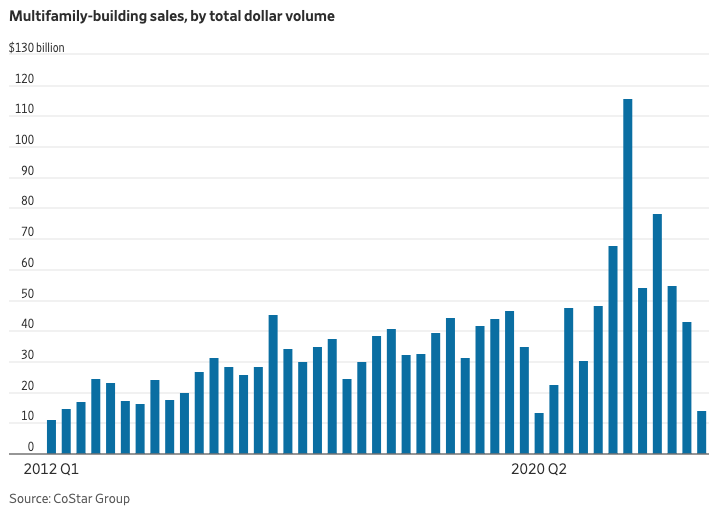
Apartment-Building Sales Drop 74%, the Most in 14 Years
Sales of rental apartment buildings are falling at the fastest rate since the subprime-mortgage crisis, a sign that higher interest rates, regional banking turmoil and slowing rent growth are undercutting demand for these buildings. Investors purchased $14 billion of apartment buildings in the first quarter of 2023, according to a preliminary report by data firm CoStar Group. That represents a 74% decline in sales from the same quarter a year earlier and would be the largest annual sales decline for any quarter going back to a 77% drop in the first quarter of 2009. April 4, 2023
Source - read more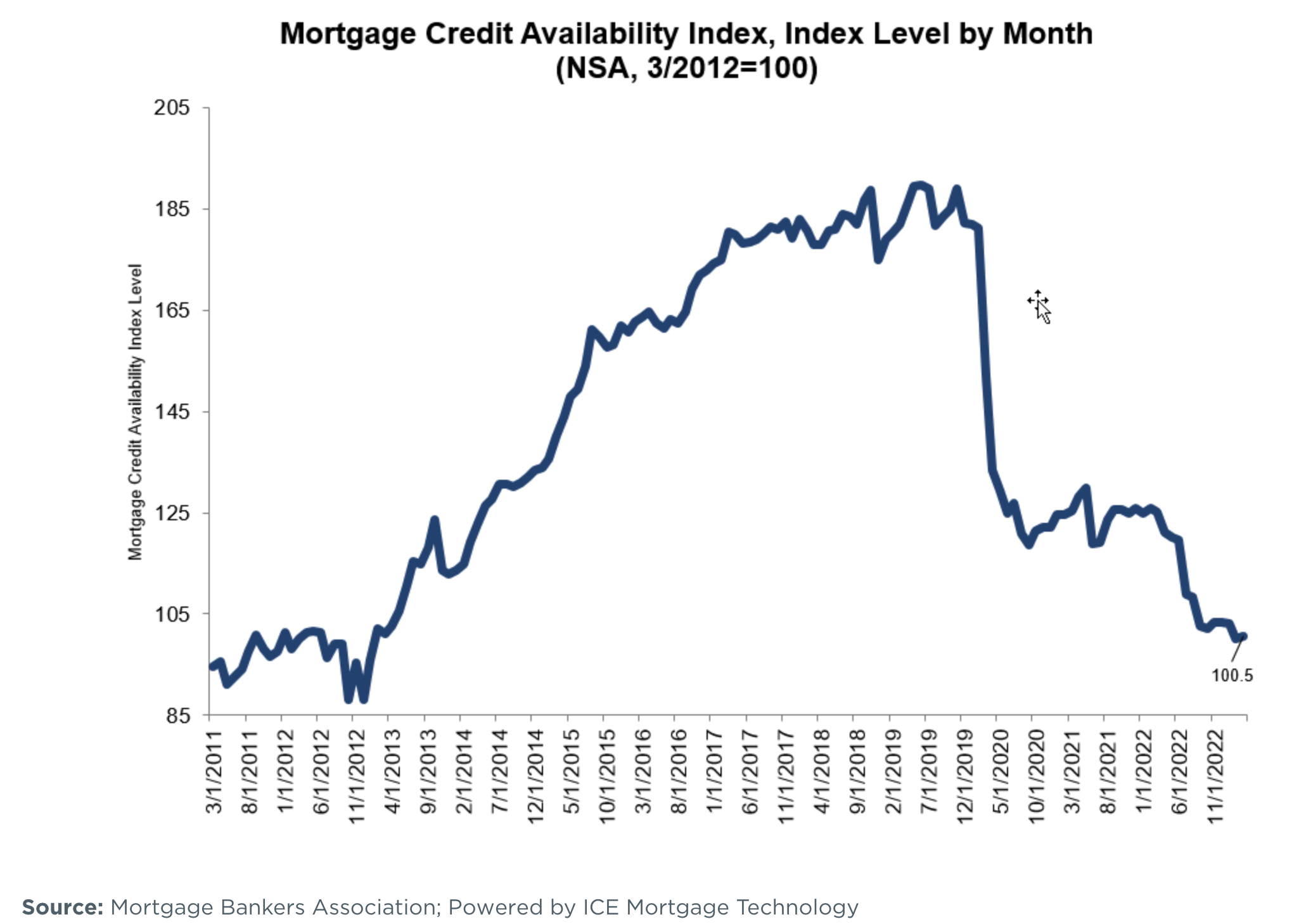
Mortgage Credit Availability Increased in March
Mortgage credit availability increased in March according to the Mortgage Credit Availability Index (MCAI), a report from the Mortgage Bankers Association (MBA) that analyzes data from ICE Mortgage Technology. The MCAI rose by 0.4 percent to 100.5 in March. A decline in the MCAI indicates that lending standards are tightening, while increases in the index are indicative of loosening credit. The index was benchmarked to 100 in March 2012. The Conventional MCAI increased 1.1 percent, while the Government MCAI decreased by 0.2 percent. Of the component indices of the Conventional MCAI, the Jumbo MCAI increased by 1.4 percent, and the Conforming MCAI rose by 0.4 percent. April 11, 2023
Source - read more
Despite Q1 Bump, Industrial Vacancy Rate Remains at Historic Lows
The industrial vacancy rate ticked up for a second consecutive quarter, according to Cushman & Wakefield, but remains historically low – 70 bps below the five-year quarterly average and 170 bps lower than the 10-year average. The Q1 report measures it at 3.6% and many markets still sit below 3%. Deals are still getting done. Jason Tolliver, executive managing director and co-lead of Americas Logistics & Industrial Services at Cushman & Wakefield, said in prepared remarks, “Given the voracious pace of growth the past two years and some timidity tied to a more uncertain economic outlook, deals are taking a bit longer to get done, but they are getting done and I remain upbeat on the outlook. April 11, 2023
Source - read more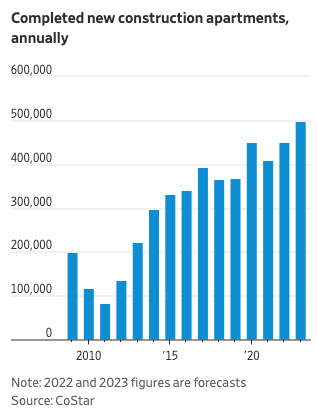
Apartment Rent Growth Set to Keep Slowing This Year
The pandemic-fueled boom for multifamily building owners is fading fast going into 2023. Apartment vacancies are piling up. The biggest wave of new rental buildings in nearly four decades is expected to cut the pace of rent growth across the country. Some in-demand Sunbelt cities are already experiencing rent declines, in part because many tenants and people searching for apartments feel they can’t devote any more of their income to rent. Rising interest rates, meanwhile, make rental-property investments less profitable than one year ago when debt was cheap and hefty rent increases were taken for granted. “We’re necessarily going to get a bit of a pullback,” said Thomas LaSalvia, senior economist at Moody’s Analytics. January 3, 2023
Source - read more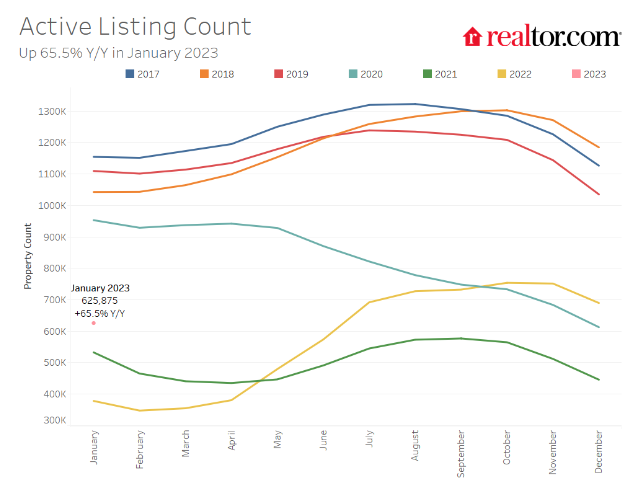
Homebuyers Gain Bargaining Power as Mortgage Rates Fall
The U.S. housing market offered homebuyers greater bargaining power in January, as mortgage rates fell to their lowest level in months, inventory rose, and the growth in the typical asking price continued to slow, according to the latest Realtor.com Monthly Housing Trends Report. Meanwhile, the annual decline in new listings also moderated to single digits in January; new listings remain an important indicator of home selling interest, and a sustained improvement would suggest more sellers are returning to the market in the coming months. February 2, 2023
Source - read more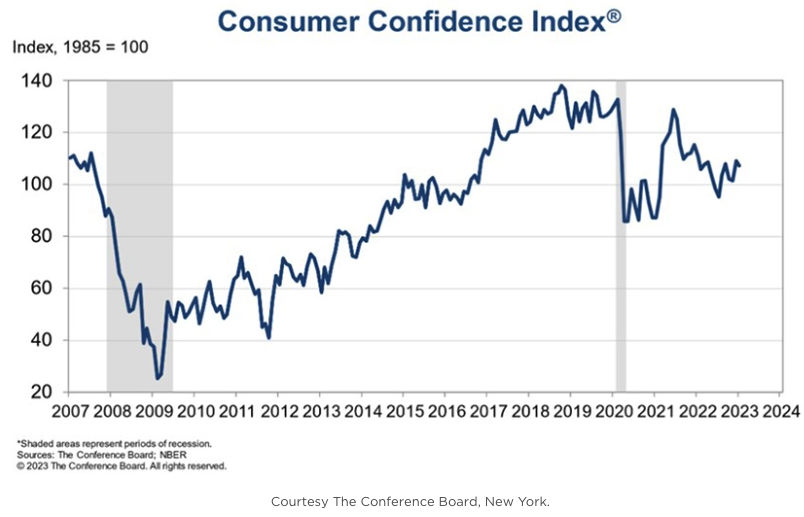
Recession Fears Fuel Dip in Consumer Confidence
The Conference Board, New York, said its Consumer Confidence Index fell in January following an upwardly revised increase in December. The Index now stands at 107.1 (1985=100), down from 109.0 in December. The Present Situation Index—based on consumers’ assessment of current business and labor market conditions—increased to 150.9 from 147.4 last month. The Expectations Index—based on consumers’ short-term outlook for income, business, and labor market conditions—fell to 77.8 from 83.4 partially reversing its December gain. The Expectations Index is below 80, which Conference Board Senior Director Ataman Ozyildirim said often signals a recession within the next year. Both present situation and expectations indexes were revised up slightly in December. January 31, 2023
Source - read more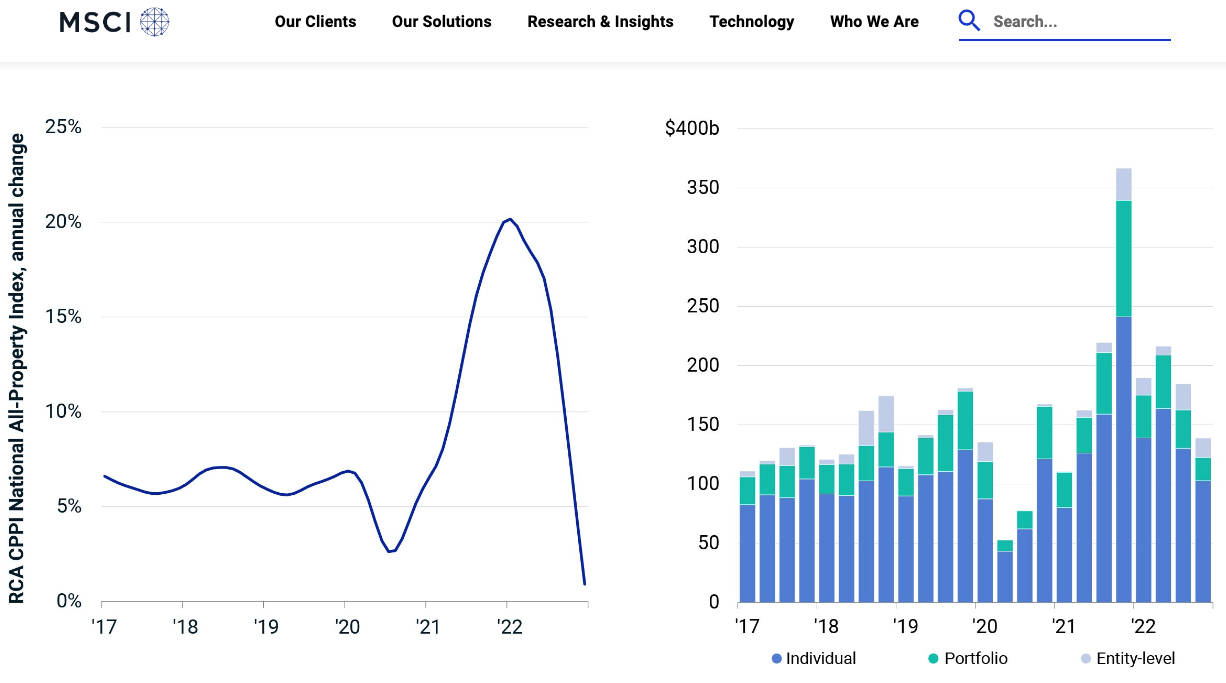
US Property Deals Slumped, Price Growth Withered in Q4
Sales of U.S. commercial property fell 62% from a year prior in the fourth quarter of 2022, and annual price growth decelerated to the slowest rate of gain since 2011. Still, for the year in total, 2022 was the second-strongest year for sales on record, behind 2021. Trading of properties such as offices, apartment buildings and warehouses slowed over 2022 as investment conditions became more uncertain. The surprising leader in investment sales for the year was the retail sector, showing a 4% year-over-year increase. Deal volume in the office sector fell the most across the major property types, dropping 25%. January 19, 2023
Source - read more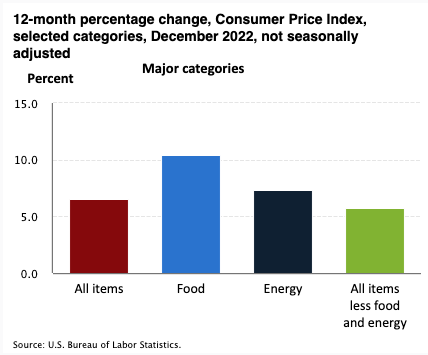
CPI for all items falls 0.1% in December as gasoline decreases
TIn December, the Consumer Price Index for All Urban Consumers decreased 0.1 percent, seasonally adjusted, and rose 6.5 percent over the last 12 months, not seasonally adjusted. The index for all items less food and energy increased 0.3 percent in December (SA); up 5.7 percent over the year (NSA). January 12, 2023
Source - read more
The Cliched Perfect Storm May Be Headed to the Office Market
A new analysis by Trepp and Compstack raises the question of whether the office segment of CRE is facing a now-cliched perfect storm metaphor. The three dangers that could unite are office loan maturities, large lease expirations, and low space demand. Said another way, it comes down to inflation and the end of easy money, worry about corporate financial performance, and the desire of working people to control more of their lives. The report says that by the end of 2424, $40.47 billion in loans — that’s 353 loans backed by 583 office properties — and 56% are floating rate with an average remaining term of over 10 months and all with extension options of 29 months. February 6, 2023
Source - read more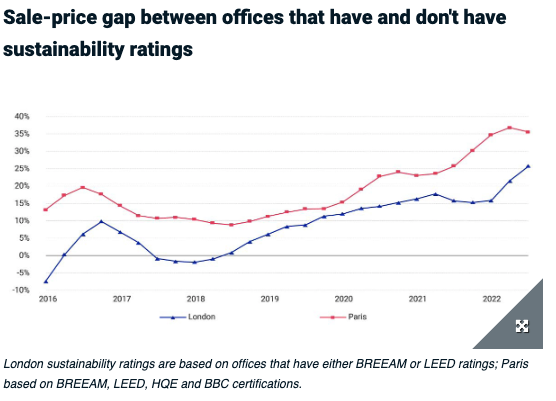
London and Paris Offices: Green Premium Emerges
Analysis of prices paid by investors for offices in London and Paris, Europe’s largest property markets, shows a premium has emerged for buildings that have sustainability ratings from organizations like the Building Research Establishment (BREEAM), U.S. Green Building Council (LEED) and GBC Alliance (HQE), versus those that have not yet achieved these standards. November 23, 2022
Source - read more
Jerome Powell Signals Fed Prepared to Slow Rate-Rise Pace in December
WASHINGTON—Federal Reserve Chair Jerome Powell provided a clear signal that the central bank is on track to raise interest rates by a half percentage point at its next meeting, stepping down from an unprecedented series of four 0.75-point rate rises aimed at combating high inflation. Mr. Powell, in a speech Wednesday, said an overheated labor market needed to cool more for the Fed to be confident that inflation would decline toward its 2% goal. November 30, 2022
Source - read more
Higher Interest Rates Showing Up in Office Sales Numbers
The impact of higher interest rates and uncertainty about office values looks to be weighing on transaction volumes as the end of the year approaches. According to Phil Mobley, national director of office analytics at CoStar Group, that’s what he’s hearing from clients. “This is what we have been expecting,” Mobley said. “It seems that it is finally beginning to show in the numbers.” December 1, 2022
Source - read more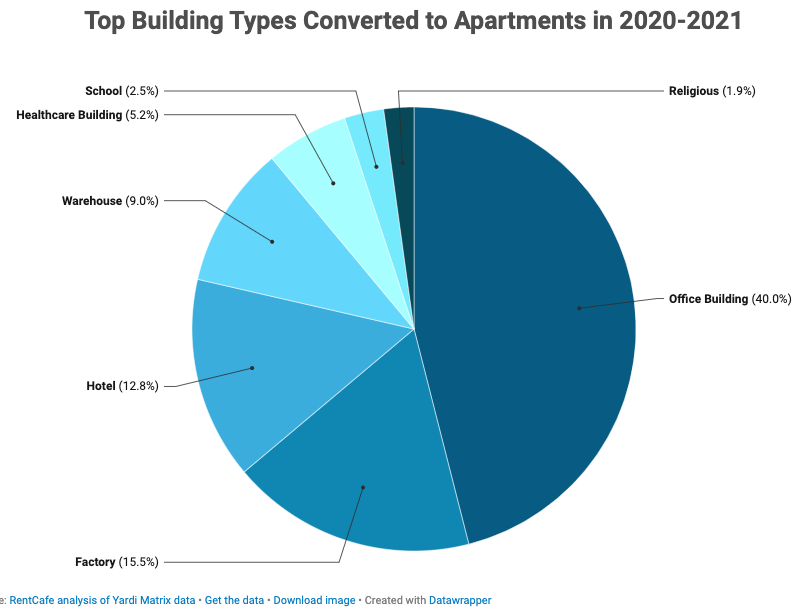
Adaptive Reuse Apartments Up 25% from Pre-Pandemic Numbers, Led by Record Office-to-Apartment Conversions
Adaptive reuse apartments are increasing faster than new apartments, up by 25% in the last 2 years compared to the pre-pandemic period. Conversions from office buildings to apartments are at an all-time high, having made way for 11,000 apartments in just the last 2 years. There are 77,000 apartments under conversion, setting up the stage for a boom in adaptive reuse in the upcoming years. In the last two years, apartment conversions jumped by 25% compared to two years prior. More precisely, this increasingly popular real estate niche brought a total of 28,000 new rentals in 2020-2021, well above the pre-pandemic years of 2018-2019 when 22,300 apartments were brought to life through adaptive reuse. Amid an ever-growing need for housing, adaptive reuse picked up speed in America’s largest cities, according to the latest data from Yardi Matrix. November 14, 2022
Source - read more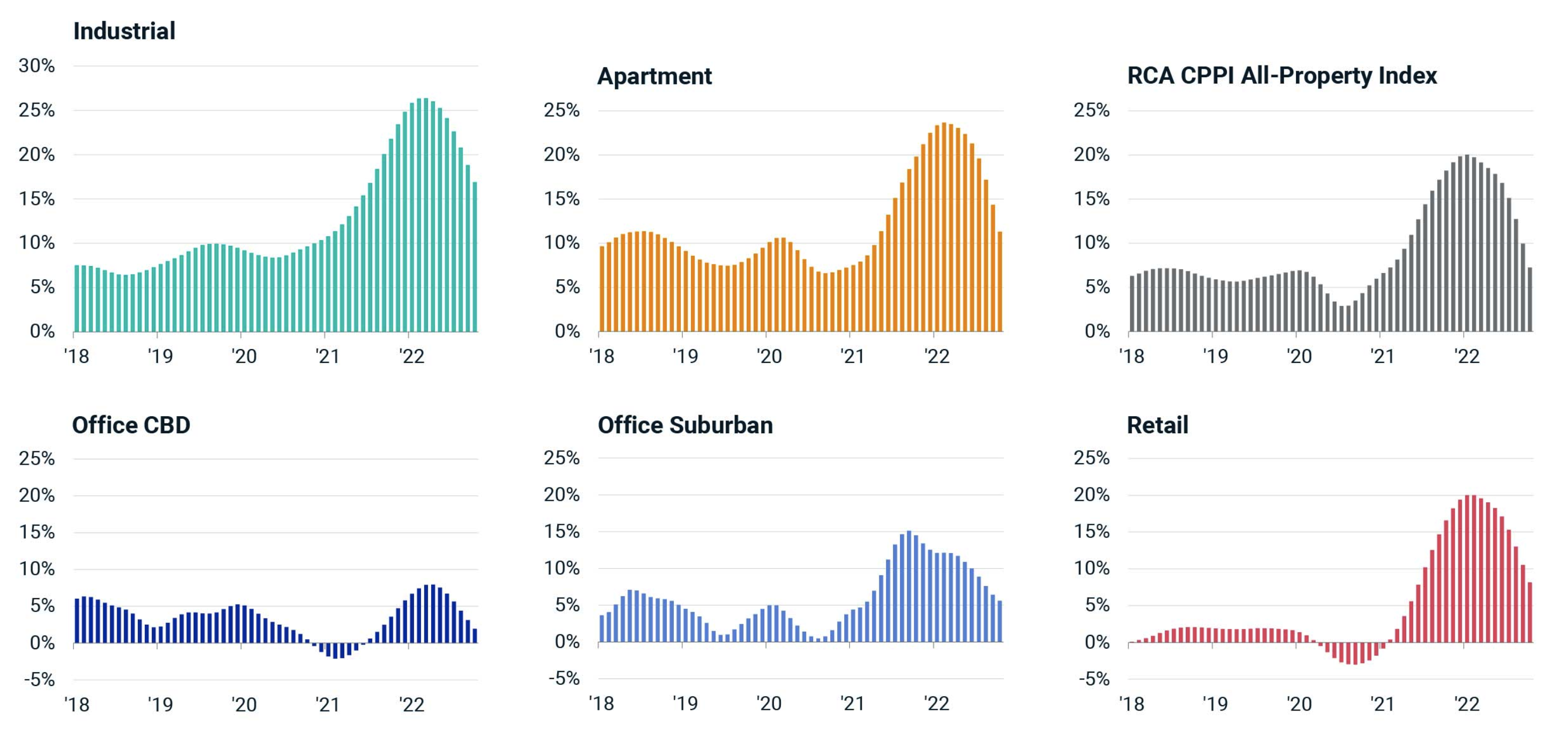
Prices of U.S. commercial property fell in October from September
Prices of U.S. commercial property fell in October from September, though they still increased compared to October of 2021. The RCA CPPI National All-Property Index (opens in a new tab) dropped 0.4% on a monthly basis — which, when annualized, would be a decline of 4.5%. The posted annual change was a 7.3% increase. Most property-type indexes showed monthly declines, and all showed slowing annual growth rates in October. Pricing of commercial property has come under pressure amid a spike in debt costs and a slowdown in deal activity in 2022. November 17, 2022
Source - read more
More 'Don’t Get Optimistic' Warnings from Fed Officials
What’s worse than having to take a dose of nasty medicine midday? Having people coming in repeatedly during the morning reminding you that the unpleasant mixture is waiting patiently for you. Lately, the nagging monitors have been high-level members of the Fed warning that markets shouldn’t hope for a quick end to tougher interest rates—which means ongoing pain for commercial real estate. Esther George— president of the Federal Reserve Bank of Kansas City, 40 years at the Fed, and retiring in January—told the Wall Street Journal that getting inflation down without a recession might not be feasible. November 17, 2022
Source - read more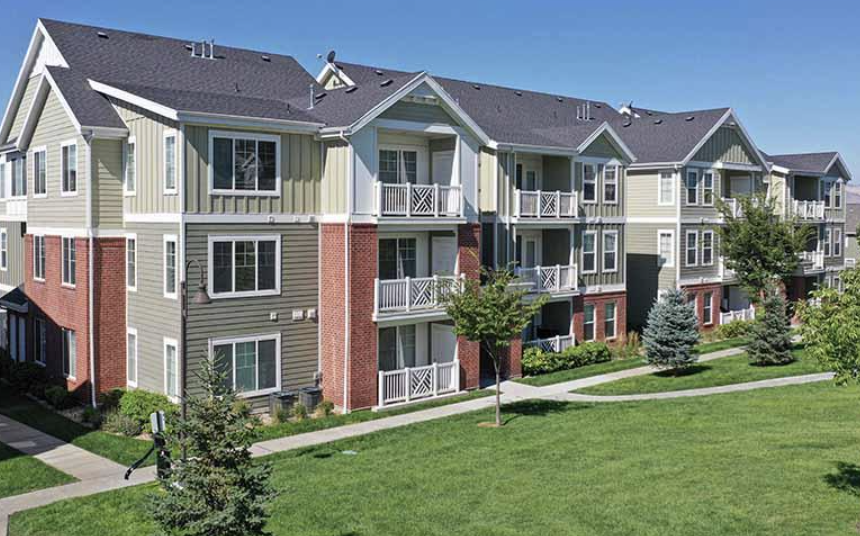
Apartment Loss to Lease is Plunging. Here's What That Means
Last week, Federal Reserve Chair Jerome Powell dove into the debate over rent inflation and suggested that while new lease rent growth is slowing, “there’s still some significant (rent) increases coming” via cheaper lease renewals hiked up to market level. But RealPage data show that’s NOT exactly true for market-rate apartments. U.S. apartments plunged back to the long-term average in “loss to lease” – which means the runway for renewal lease rents will significantly narrow going forward. November 8, 2022
Source - read more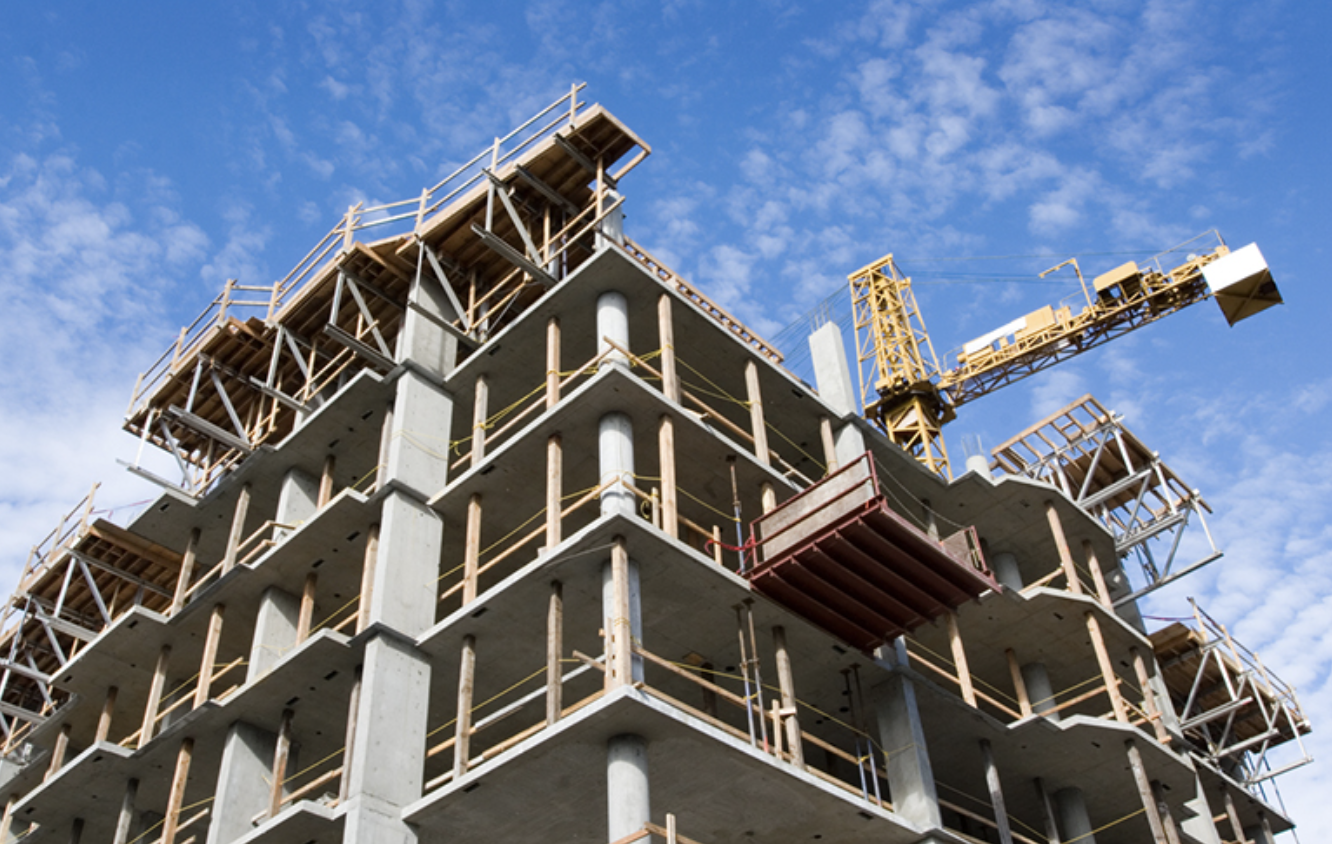
MBA: 3Q Commercial/Multifamily Borrowing Declines 13 Percent
Commercial and multifamily mortgage loan originations decreased 13 percent in the third quarter from a year ago, according to the Mortgage Bankers Association’s Quarterly Survey of Commercial/Multifamily Mortgage Bankers Originations. “After a strong first half of the year, rising interest and capitalization rates began to affect deal volume during the third quarter,” said Jamie Woodwell, MBA Head of Commercial Real Estate Research. “Increasing yields across investment alternatives – including the 10-Year Treasury yield more than doubling during the first nine months of the year – have shifted property financing and values, and it will take time for the market to fully absorb these changes. Volatility has been equally impactful, making the sizing of transactions extremely difficult. The result has been the first of what may be many quarters of depressed borrowing and lending activity.” November 8, 2022
Source - read more
Developers, Project Managers 'Overwhelmingly' Concerned About Inflation
Project managers and developers in the commercial real estate industry are “overwhelmingly” concerned about rising costs as inflation continues to heat up, new research shows. A recent survey by Northspyre reveals that industry insiders are eyeing inflationary pressure, so-called inadequate productivity and uncertain project outcomes as the biggest concerns looming over construction projects heading into 2023. More than half of the 92 project leads surveyed think inflation will have a “moderate-to-major” impact on their roles, with 85% saying they intend to be more careful and strategic in purchasing decisions. And more than 60% of project managers surveyed say the biggest challenges they face include keeping projects on budget amid rising inflation, supply chain disruptions and higher interest rates. November 8, 2022
Source - read more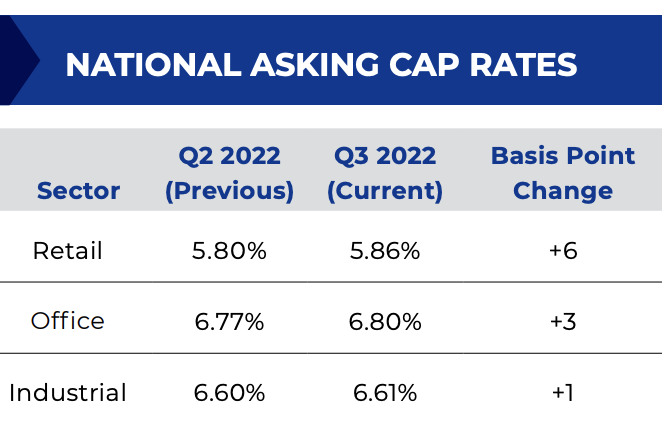
Single Tenant Cap Rates Up - The Boulder Group
Cap rates in the single tenant net lease sector increased slightly for all three sectors in the third quarter of 2022. For the first time in the past two years, cap rates increased for two straight consecutive quarters. Single tenant cap rates increased to 5.86% (+6 bps) for retail, 6.80% (+3 bps) for office and 6.61% (+1 bps) for industrial in the third quarter of 2022. As the Federal Reserve continues to increase rates in attempt to curb inflation, debt costs have increasingly put upward pressure on cap rates for buyers of net lease properties. 3Q 2022
Source - read more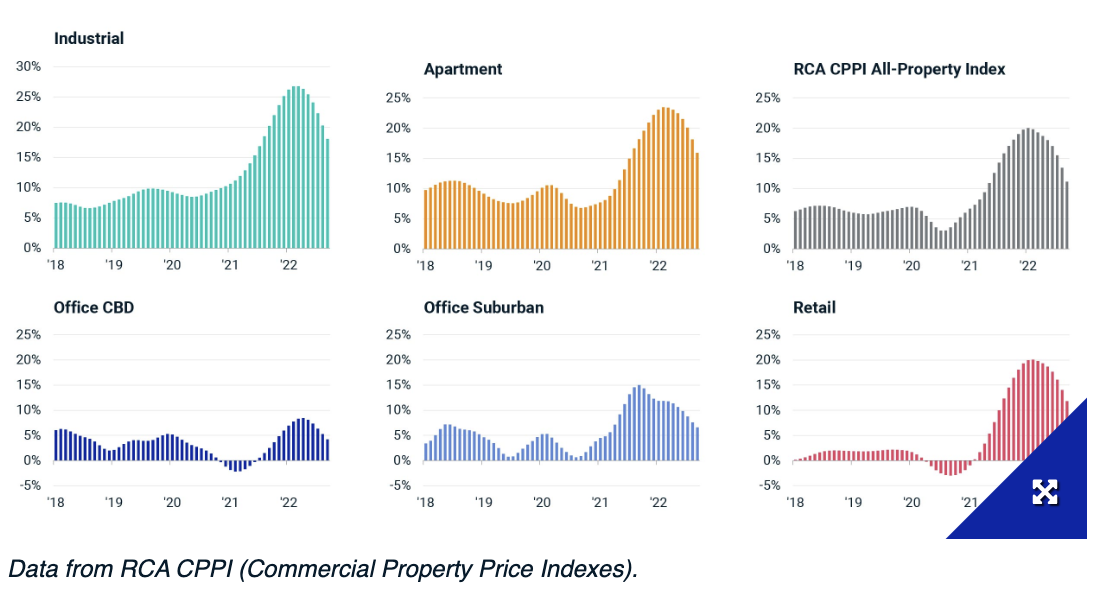
Industrial, apartment and retail decelerated sharply
Price growth for the industrial, apartment and retail sectors also slowed sharply but remained in the double digits. The annual growth rate of the industrial index slowed to 18.1%, the first time this index has registered an increase smaller than 20% since August 2021. The apartment-sector index posted a 15.9% annual pace of growth and the retail price index an 11.8% rate. Both rates have decelerated throughout most of 2022. October 21, 2022
Source - read more
Inflation Tracker: When will prices stop going up?
We all are feeling the punch of surging prices in one way or another. The Journal has put together a price tracker of common items that many Americans buy monthly to see the direction of prices that matter to you. This living page will automatically update with the most recent prices from the CPI as new numbers are released. October 13, 2022
Source - read more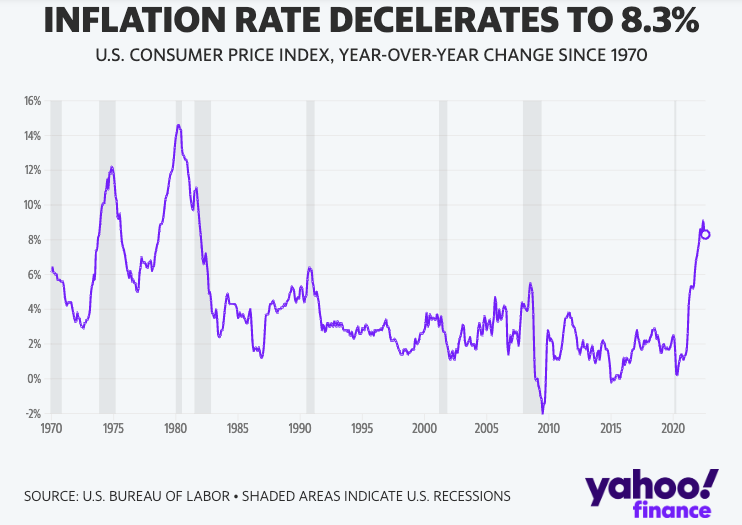
Fed Scores Another 75 Basis Point Interest Rate Hike
As many expected, the Federal Open Market Committee of the Federal Reserve in its scheduled meeting today announced another 75-basis point increase to its benchmark target rate range. That’s the third time this year the Fed has done so, making the overnight rate range at which banks lend to one another now 3% to 3.25%. Not only does that mean higher interest rates everywhere else, and certainly in CRE financing, but the FOMC “anticipates that ongoing increases in the target range will be appropriate.” In other words, expect the process to continue and rates to keep increasing. Spetember 21, 2022
Source - read more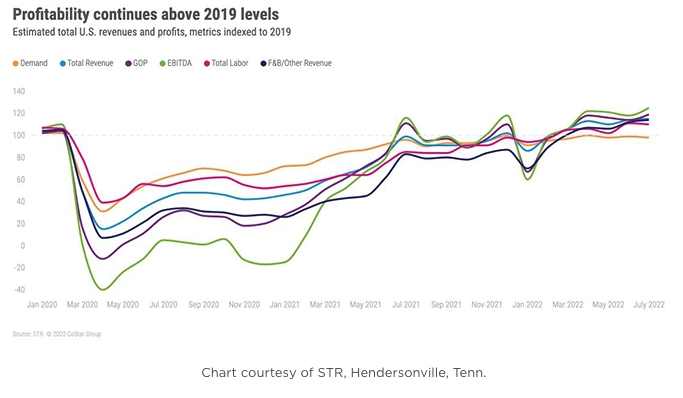
CBRE Raises Hotel Sector Outlook
CBRE, Dallas, raised its forecast for hotel performance based on second-quarter gains and its expectation for slightly positive GDP growth next year. CBRE revised its forecast for second-half 2022 to a 14.7 percent revenue per available room gain year-over-year, up from its previous projection, 13.1 percent year-over-year. The firm said it expects to see a 3.5 percentage point increase in average daily rate growth compared to its previous forecast issued in May, though room demand may fall slightly. CBRE Head of Hotel Research & Data Analytics Rachael Rothman noted the “brisk” demand recovery seen earlier this year has begun to slow. “We are seeing a pullback in average daily rates in select record-setting markets,” she said. “Despite the slowing pace of growth, we expect the continued recovery in travel demand to be driven by incremental group and inbound international travel, followed by a modest uptick in transient business.” September 7, 2022
Source - read more
Study Finds One-Third of U.S. Homes Are Bought With Cash
According to a new report from Redfin, nearly one-third —or 31.4%— of U.S. home purchases were paid for with all cash in July. That’s near the eight-year high reached in February and up from 27.5% a year earlier. The share of all-cash purchases jumped in early 2021 during the pandemic-driven homebuying frenzy and has remained elevated since then. All-cash purchases are prevalent with today’s affluent buyers largely because mortgage rates have doubled from a year ago, reaching 6% in mid-September. Buyers who don’t use loans avoid high interest payments that exacerbate home prices, which remain near record highs even as the housing market slows. September 16, 2022
Source - read more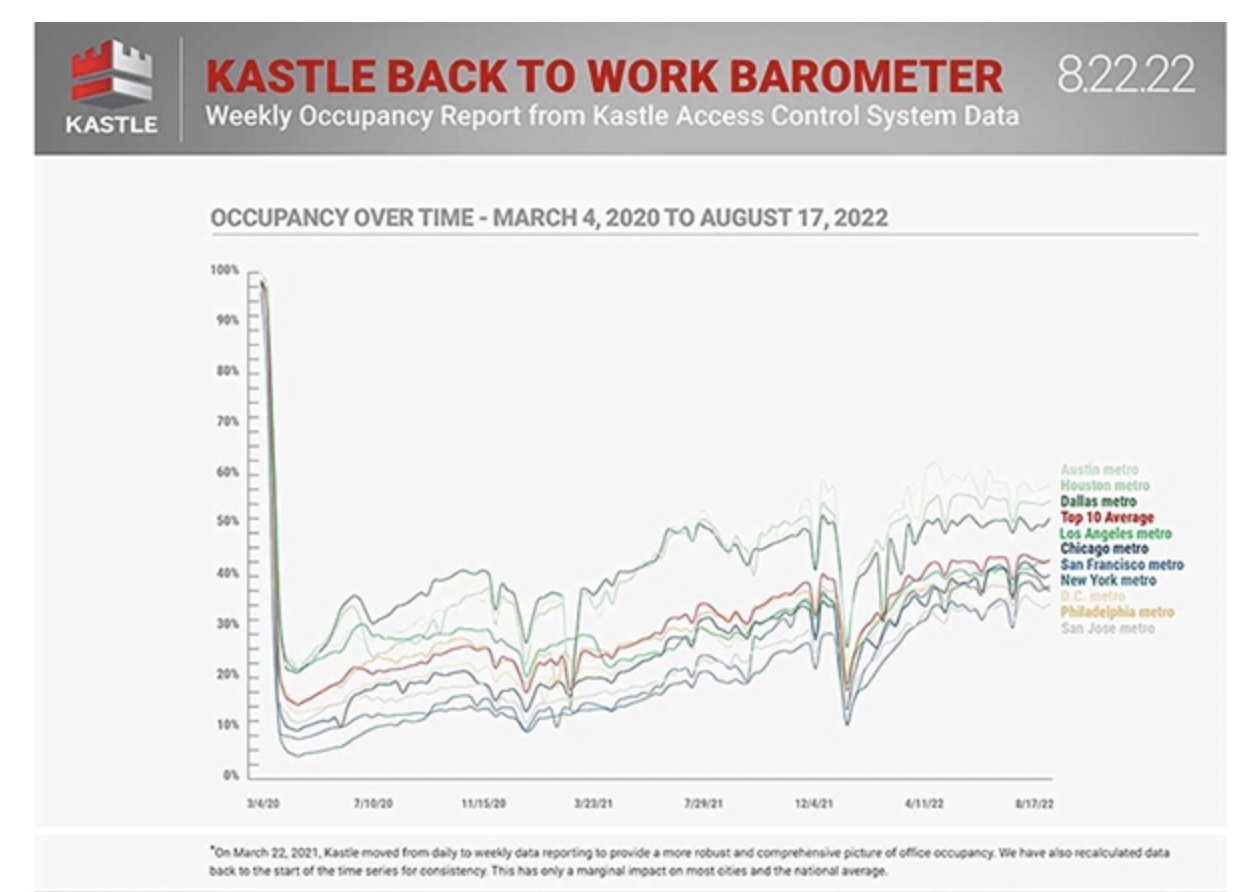
Bright Spots Amid Office Sector Struggles
Office absorption remains negative even though office-using employment increased by 1.9% in the first half of the year, adding 635,000 jobs, reported Cushman & Wakefield, Chicago. The latest C&W Office MarketBeat report found -7.8 million square feet of net absorption across the U.S. in the second quarter, making eight quarters out of the past nine that have been negative nationwide. Net absorption was negative for nine out of 10 and eight out of nine quarters, respectively, after the Dot-Com Recession and the Great Recession, the report said. “Despite this, there have been bright spots across the country,” Cushman said, noting more than one-third of the office markets it tracks were positive in the second quarter. Over the past few quarters, a few U.S. markets saw significant net absorption, led by life sciences markets such as San Jose, San Diego, Boston and northern New Jersey and large Sunbelt markets with strong job growth such as Dallas, Atlanta, Austin and Miami. August 30, 2022
Source - read more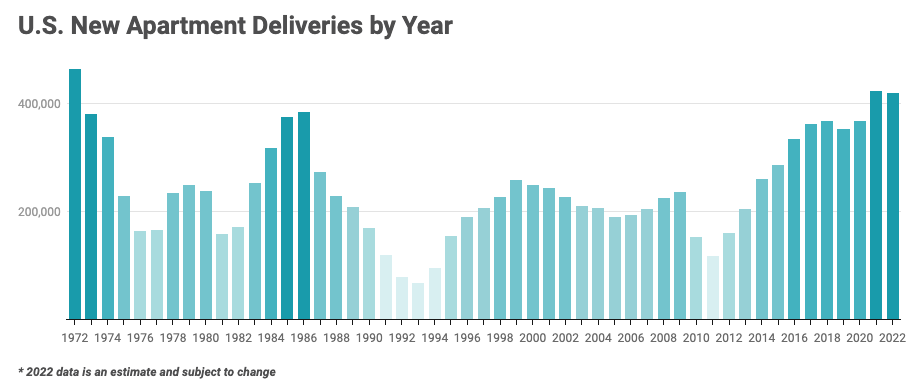
The Best of Times for Apartment Construction in Half a Century: New York Takes the Lead in 2022
This year, 420,000 new apartments are expected nationwide. In fact, multifamily construction in the last two years is at a 50-year high: Apartment completions last surpassed the 400,000 unit mark in 1972. New York is poised to surpass the Dallas-Fort Worth metro area in apartment construction, claiming the top spot for the first time since 2018. Half of the top 20 metro areas are estimated to hit their five-year peaks in apartment deliveries this year, including newcomers Nashville, TN, and Portland, OR. The Miami metro, the nation’s most competitive rental market, made an impressive climb back to the top, surpassing super builders like Houston and Austin, TX. September 8, 2022
Source - read more
Colliers: Capital Markets US Snapshot Q2 2022
Another record-breaking sales quarter is in the books. With $178.8 billion traded, second-quarter volume was up marginally from Q1 and 18% from one year prior. In addition, the past four quarters have seen a combined $905.2 billion in sales. However, it’s important to note that the market is at an inflection point. Buyers and sellers are still adjusting to higher borrowing costs. Once the market settles, investors will be able to price the cost of debt more confidently. Persistent inflation, geopolitical risks, and a slowing U.S. economy are headwinds investors are grappling with today. However, job growth has been resilient, supporting the potential for a soft landing economically. See the pdf August 30, 2022
Source - read more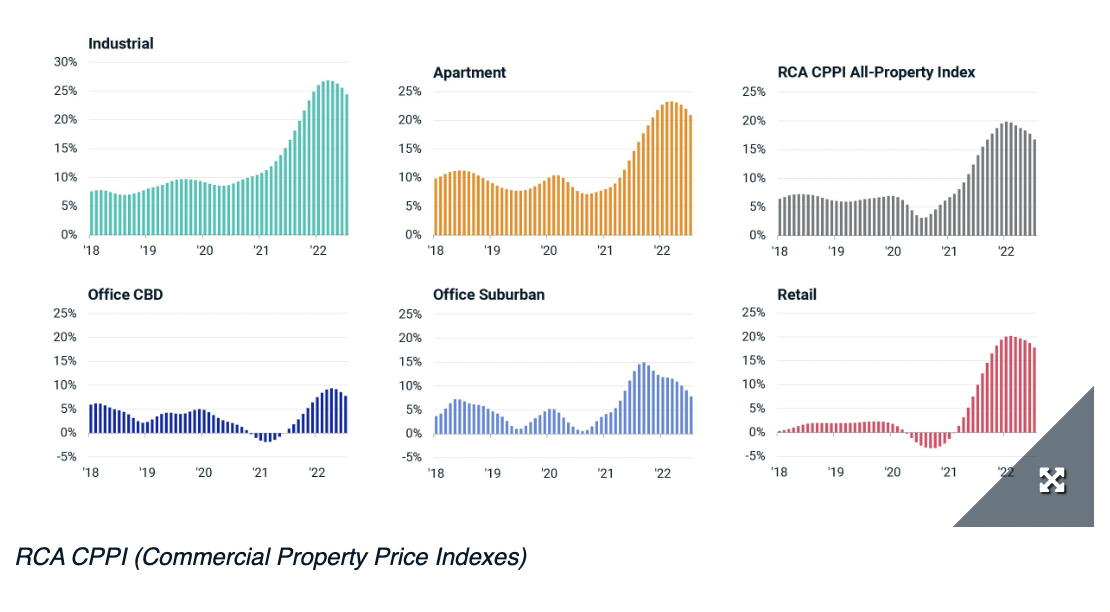
Price Growth in US Property Types Eased in July
The pace of annual price growth across all major U.S. commercial property types faded in July, though most RCA CPPI indexes still showed double-digit gains. The RCA CPPI National All-Property Index rose 16.8% from a year ago, marking a continued slowdown from the record rates seen at the start of 2022. Price growth has eased as investors became more hesitant in the face of challenges such as rising interest and mortgage rates, and concerns over the chances of a recession. Price increases for suburban offices slipped to an annual rate of 7.8% in July, the tenth consecutive month of decelerating growth. Price growth for offices in central business districts (CBDs) eased as well, slowing to a 7.7% annual rate. The 3-month increase for the CBD-office index of 0.4% indicated an even slower pace of yearly growth, at an annualized figure of just 1.7%. August 25, 2022
Source - read more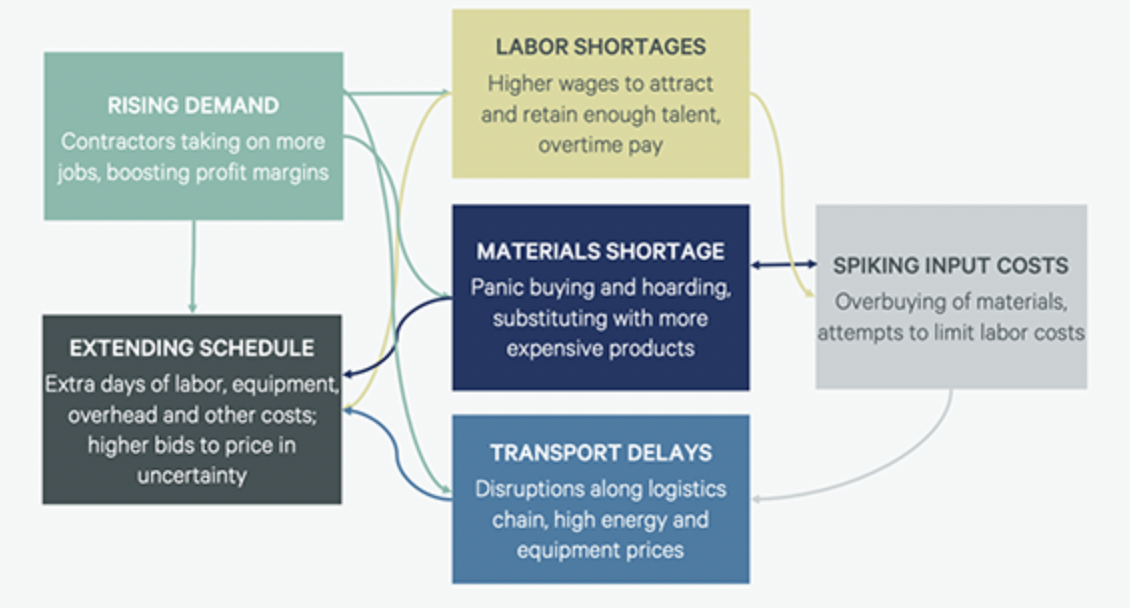
CBRE: Construction Costs Could Jump 14%
CBRE, Dallas, said it expects U.S. construction costs to jump 14.1 percent year-over-year by year-end due to pressures including labor shortages, inflation, supply chain disruptions, pandemic reverberations and the war in Ukraine. “The increase likely will be the largest in several years,” CBRE said in its latest U.S. Construction Cost Trends report. The firm’s projected 2022 increase exceeds last year’s 11.5 percent rise and well outpaces the historical average gain of 2 percent to 4 percent per year. “The anticipated 2022 gain is the largest since CBRE began tracking cost projections in 2007.” August 30, 2022
Source - read more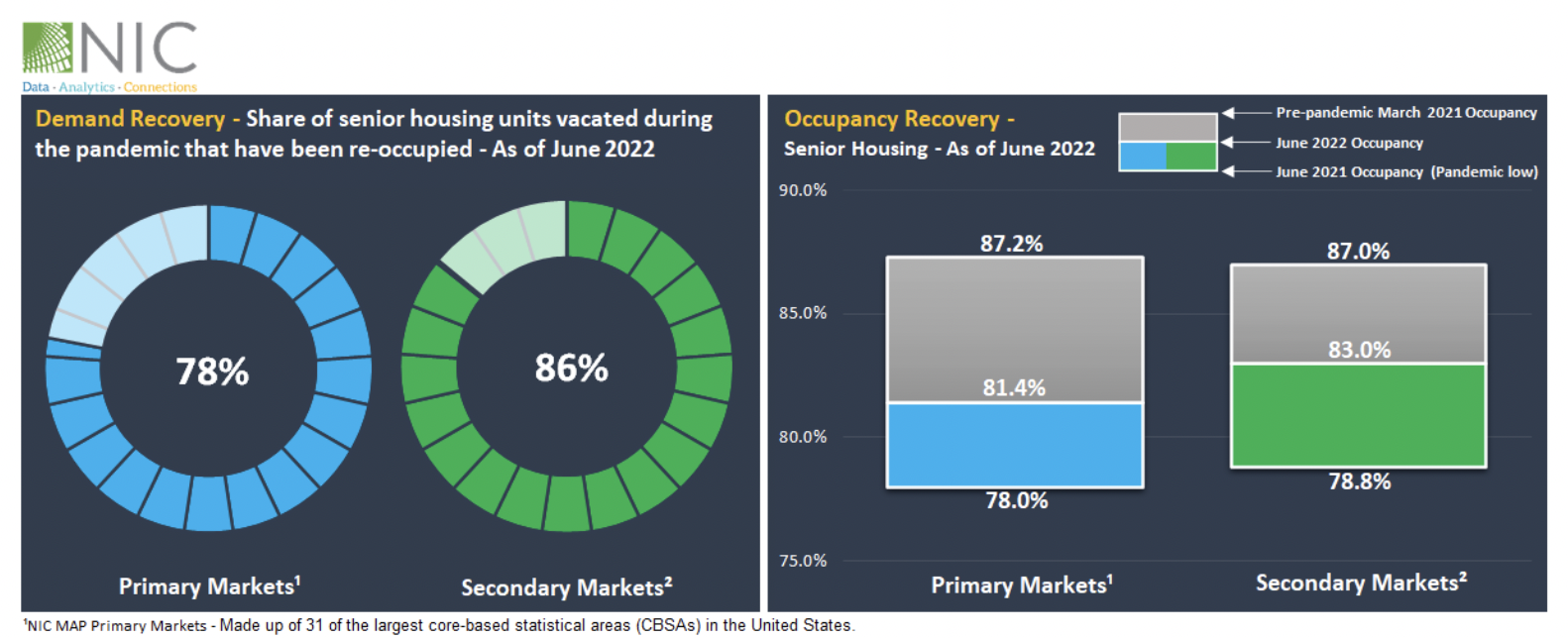
Senior Housing Recovery Regained Pace in Second Quarter 2022
The Senior housing occupied units vacated during the pandemic are on track for full recovery, across both the NIC MAP Primary Markets and the NIC MAP Secondary Markets. Senior housing occupancy bouncing back but remains far below pre-pandemic March 2020 levels. The senior housing market continued to experience a high acuity trend, with occupancy for majority assisted living properties recovering relatively fast compared with majority independent living properties July 8, 2022
Source - read more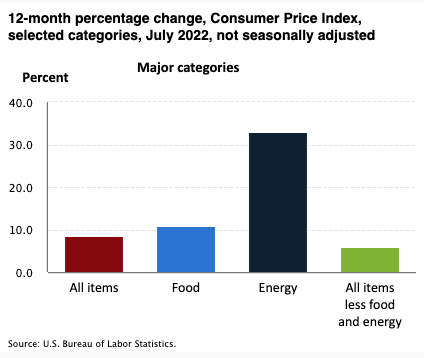
CPI unchanged in July, 8.5% over the last 12 months
The Consumer Price Index for All Urban Consumers (CPI-U) was unchanged in July on a seasonally adjusted basis after rising 1.3 percent in June, the U.S. Bureau of Labor Statistics reported today. Over the last 12 months, the all items index increased 8.5 percent before seasonal adjustment. The gasoline index fell 7.7 percent in July and offset increases in the food and shelter indexes, resulting in the all items index being unchanged over the month. The energy index fell 4.6 percent over the month as the indexes for gasoline and natural gas declined, but the index for electricity increased. The food index continued to rise, increasing 1.1 percent over the month as the food at home index rose 1.3 percent. August 10, 2022
Source - read more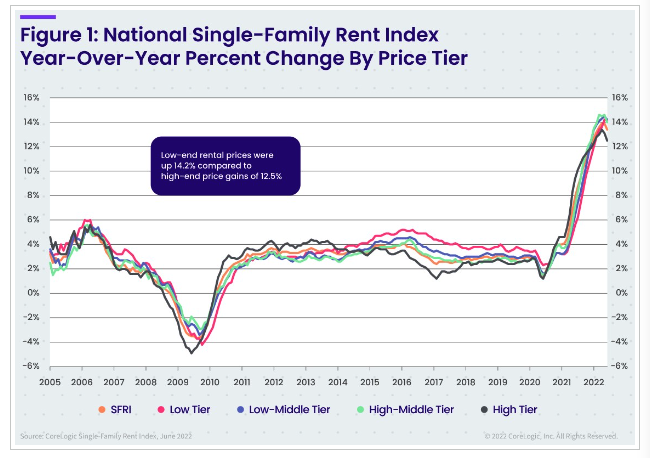
Pumping the Brakes? Some Locations Reporting Rent Price Deceleration
CoreLogic has released its latest Single-Family Rent Index (SFRI) covering the month of June 2022 found that in some areas of the country, the unrelenting pace a which rent growth has been growing slowed a bit, yet continues to post year-over-year double-digit growth. For the month of June, single-family rent prices remain elevated, now up 13.4% year-over-year, but this number is relaxing from data seen in previous months this year. According to CoreLogic, this deceleration, however minor, could partially be due to worries over an “impending” economic slowdown, even in light of strong jobs numbers. August 16, 2022
Source - read more
U.K. Inflation Tops 10%, Underlining Gloomy Outlook for Europe
The U.K.’s annual rate of inflation moved into double digits in July and is set to rise even higher by the end of the year, heaping greater pressure on stretched household budgets and threatening a lengthy economic contraction. That pickup in inflation has been replicated in other parts of Europe, even as consumer prices have started to slow in the U.S. That is because energy prices have continued to accelerate across Europe as Russia withholds supplies of natural gas, with the continent facing a possible crunch this winter. August 17, 2022
Source - read more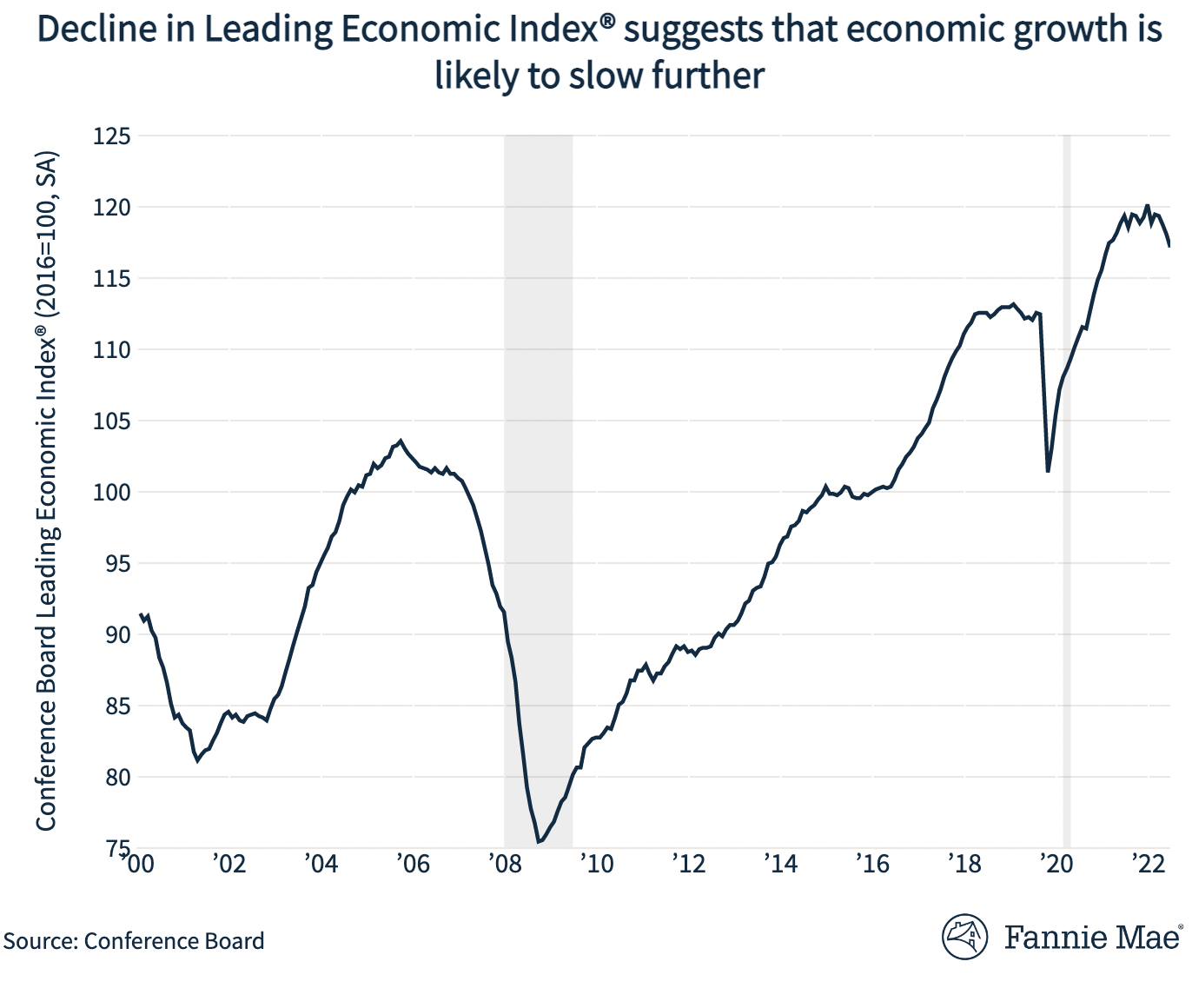
Leading Indicators Point to Stalling Economy as Housing Continues to Slow
The Conference Board Leading Economic Index® (LEI), a gauge of the economic outlook over the next three to six months, fell 0.8 percent in June to 117.1, the fourth consecutive month of decline. According to a Conference Board press release, "Consumer pessimism about future business conditions, moderating labor market conditions, falling stock prices, and weaker manufacturing new orders drove the LEI's decline in June." July 22, 2022
Source - read more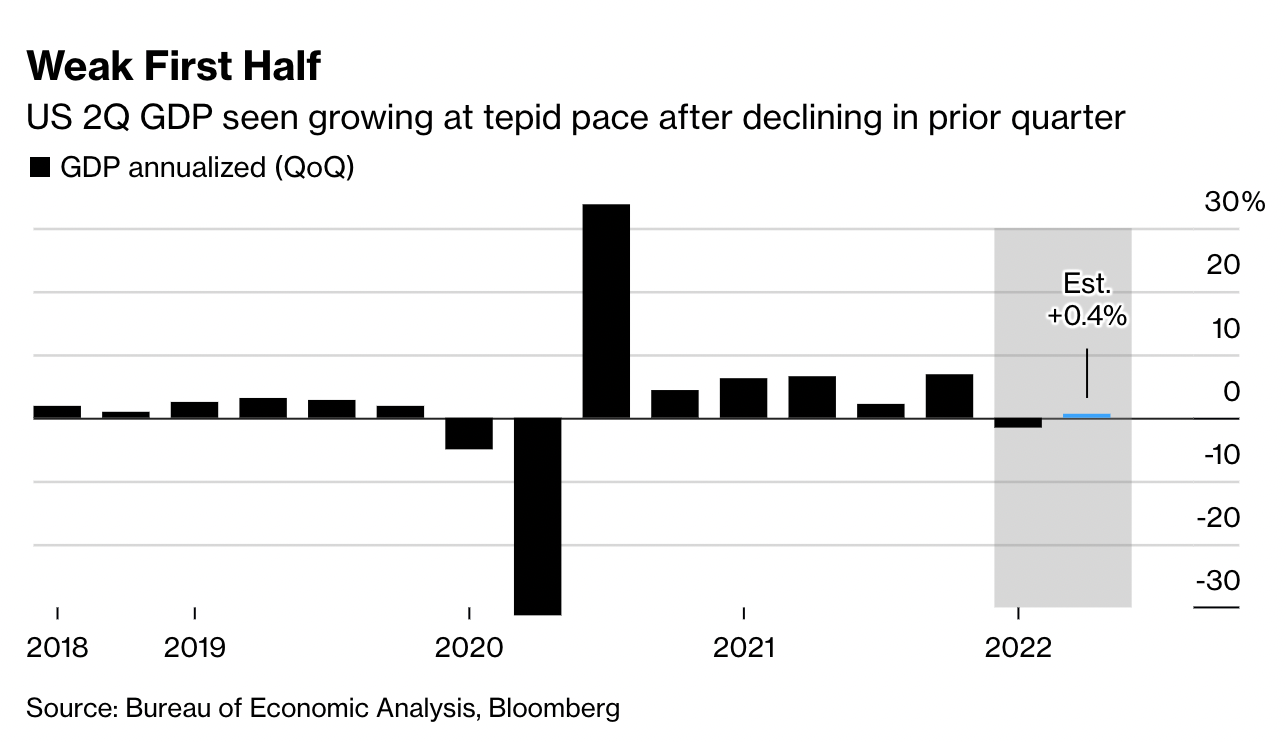
Powell Signals More Hikes Coming, While Markets Detect Pivot
Chair Jerome Powell said the Federal Reserve will press on with the steepest tightening of monetary policy in a generation to curb surging inflation, while handing officials more flexibility on coming moves amid signs of a broadening economic slowdown. Policy makers again raised the benchmark US interest rate 75 basis points on Wednesday to a range of 2.25% to 2.5% and said they anticipate “ongoing increases” will be appropriate. Just how much depends on how the economy performs, the central bank chief said. He stepped away from the specific guidance on the size of upcoming hikes he previously gave, though he didn’t take another jumbo move off the table. July 27, 2022
Source - read more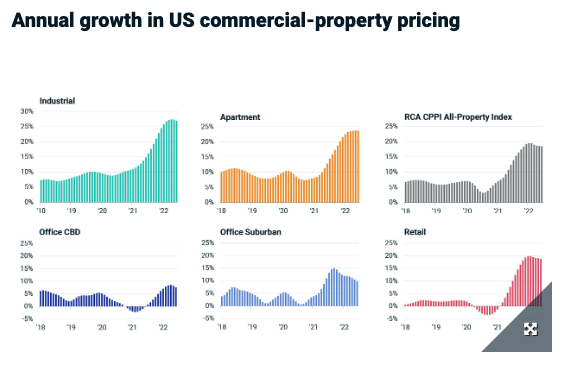
US Commercial Real Estate Prices Climbed 18.5% in June
Prices of U.S. commercial real estate continued to grow at a double-digit rate in June amid sustained demand for the asset type. The RCA CPPI National All-Property Index climbed 18.5% in June from the prior year, close to recent growth rates and just below the record-high pace of 19.5% in January. Price increases in the industrial and apartment sectors were the largest among the property types. The industrial sector outpaced all property sectors with a 26.9% annual gain. The apartment index showed a 23.7% increase from a year ago. July 21, 2022
Source - read more
The Signal for Industrial Property Amid E-Commerce Noise
Demand and pricing for industrial commercial property got a boost from spiking e-commerce demand during the early part of the pandemic. Growth in e-commerce activity has slowed in recent quarters, raising questions about demand for industrial real estate. Longer-terms trends have offered a better signal on the performance of this asset type. E-commerce sales grew at an exponential rate for most of the period from 2002 to 2019, and then got kicked into overdrive by the COVID-19 pandemic.1 As the U.S. moved past the tightest restrictions of the pandemic, however, the pace of growth in e-commerce sales slowed. Some may be tempted to set expectations for the future of e-commerce and industrial property demand and pricing from this recent inversion alone. But the shock of the pandemic continues to reverberate through economic and financial data, and looking past the noise to the longer-term trends may be a better guide. June 7, 2022
Source - read more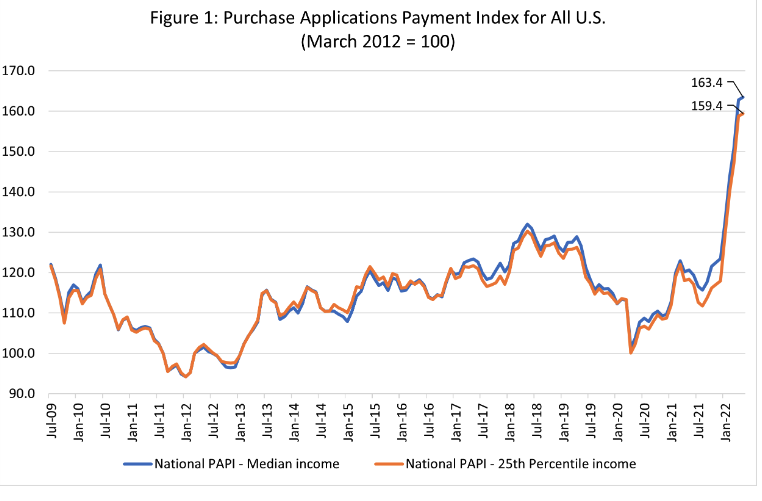
Mortgage Application Payments Rise to $1,897 in May
Homebuyer affordability was mostly unchanged in May, with the national median payment applied for by applicants up slightly to $1,897 from $1,889 in April. This is according to the Mortgage Bankers Association's (MBA) Purchase Applications Payment Index (PAPI), which measures how new monthly mortgage payments vary across time – relative to income – using data from MBA’s Weekly Applications Survey (WAS). June 23, 2022
Source - read more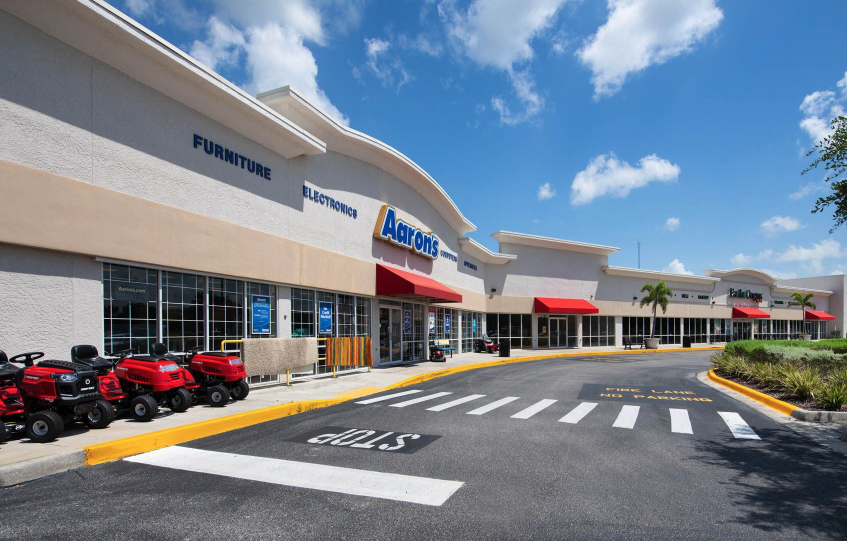
Private Investors Buy Up Retail Real Estate as Bigger Players Remain Cautious
Private investors are snapping up shopping centers and other bricks-and-mortar real estate, a bullish sign for the beleaguered retail property sector as it emerges stronger than expected from the Covid-19 pandemic. While many real-estate investment trusts and other big players remain cautious, retail property sales are increasing to family offices, wealthy individuals and small private investment firms. These buyers, who are more nimble than big companies, were responsible for nearly three-quarters of retail-asset acquisitions in 2021, a 30% increase from the 10-year historical average, according to real-estate services firm JLL. June 14, 2022
Source - read more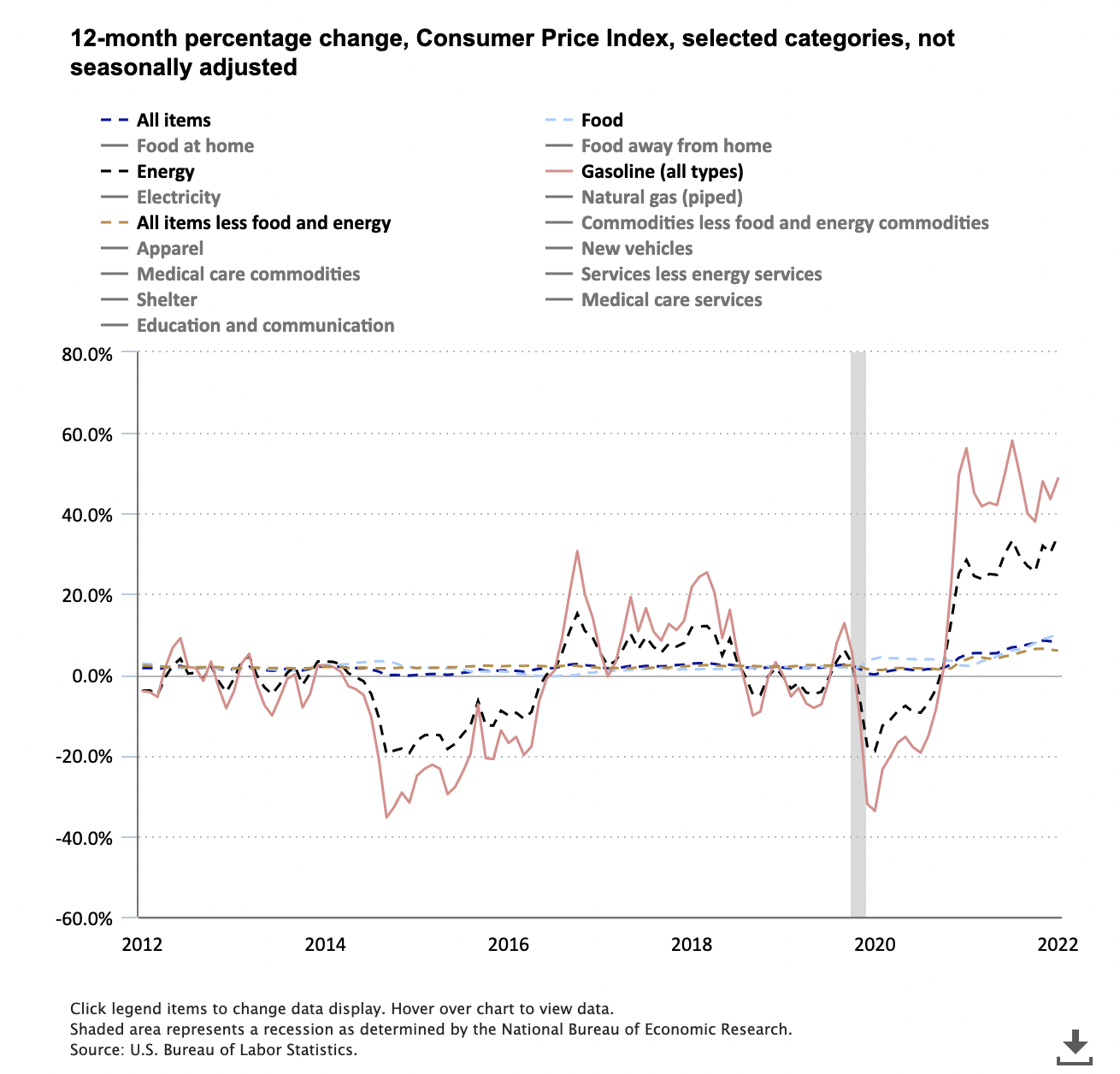
Consumer prices up 8.6 percent over year ended May 2022
From May 2021 to May 2022, the Consumer Price Index for All Urban Consumers increased 8.6 percent, the largest 12-month increase since the period ending December 1981. The all items less food and energy index rose 6.0 percent over the last 12 months. The energy index rose 34.6 percent over the last year, the largest 12-month increase since the period ending September 2005. The food index increased 10.1 percent for the 12-months ending May, the first increase of 10.0 percent or more since the period ending March 1981. Prices for food at home rose 11.9 percent over the last 12 months, the largest 12-month increase since the period ending April 1979. Energy prices rose 34.6 percent over the past 12 months. Gasoline prices increased 48.7 percent over the span. Shelter prices rose 5.5 percent over the last year, the largest 12-month increase since the period ending February 1991. Prices for household furnishings and operations increased 8.9 percent over the last 12 months. Prices for new vehicles rose 12.6 percent and prices for used cars and trucks increased 16.1 percent over the year, while prices for airline fares rose 37.8 percent. May, 2022
Source - read more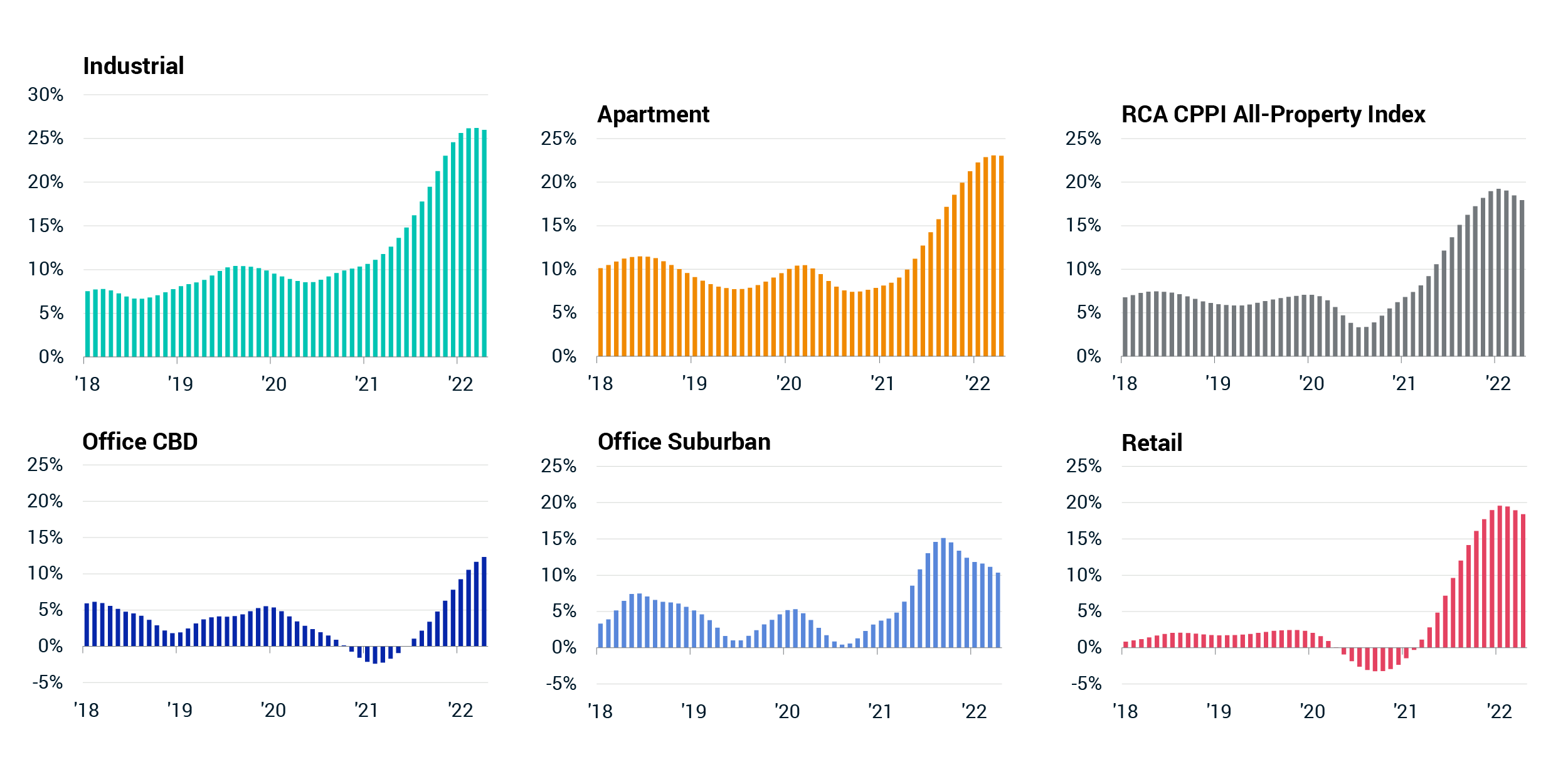
US Commercial Real Estate Price Growth Slipped in April
Annual growth in the price of U.S. commercial properties ebbed again in April, the third consecutive month of decelerating price gains. The RCA CPPI National All-Property Index rose 17.9% from a year ago, a pace still not far from the record rates seen at the start of 2022. Results across the major property types were mixed. The industrial and apartment sectors led annual price gains in April, hovering close to their record highs. Industrial prices rose 26.0% from a year ago, and apartment prices increased 23.0%. Both the industrial and apartment indexes rose 1.3% from March, and this month-over-month change suggests around a 17% annualized rate of growth, slower than the posted pace of yearly change for these indexes. May 26, 2022
Source - read more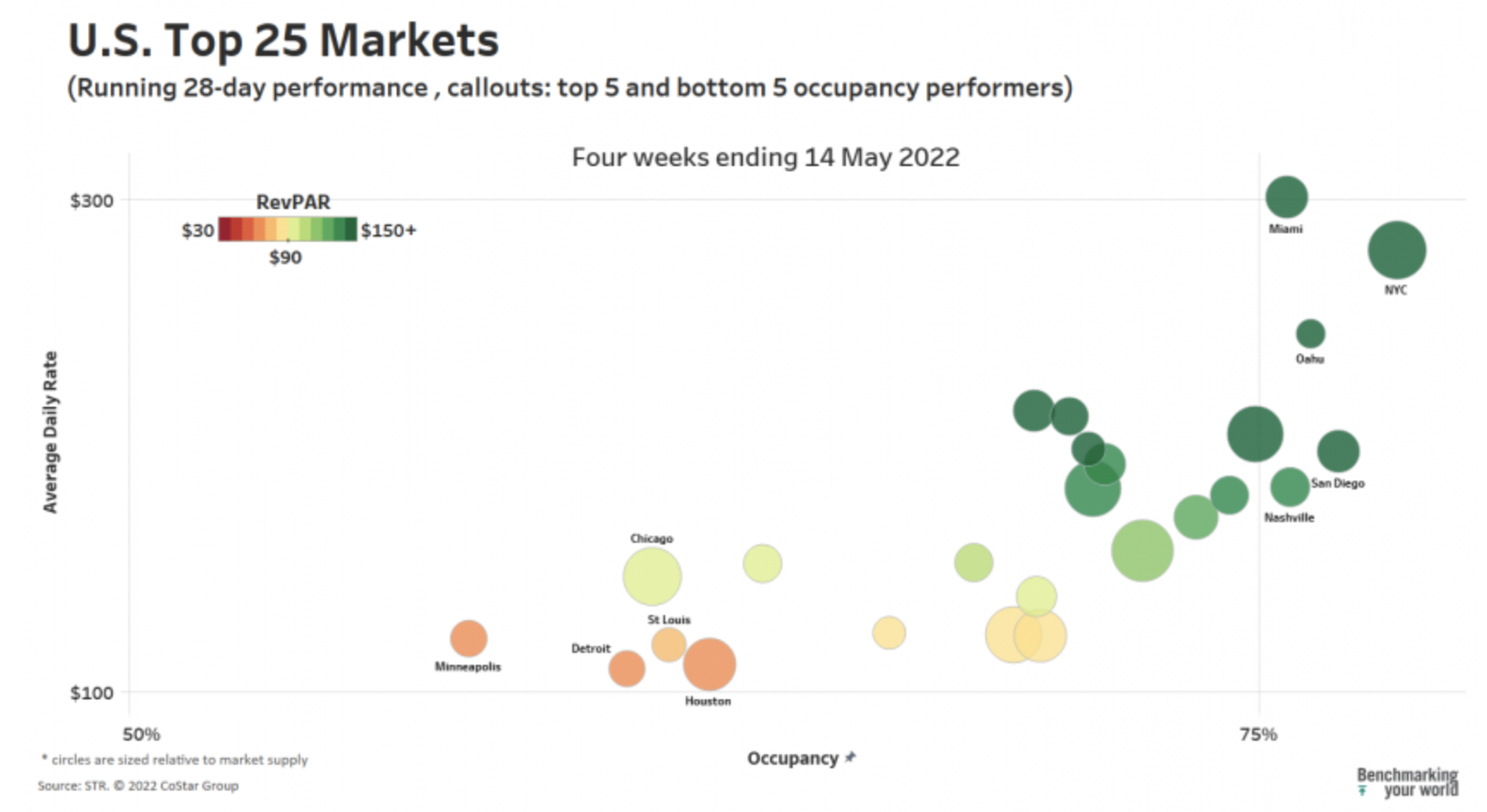
Recent U.S. occupancy leaders appeal to both business and leisure travel
For the four-week period ending 14 May 2022, more than three-quarters of all U.S. hotel markets outperformed their comparable 2019 revenue per available room (RevPAR) on a nominal basis. Of 165 STR-defined U.S. markets, only 38 fell short of their 2019 RevPAR, which was a solid improvement from 52 underperformers in April’s “bubble” blog update. Industry RevPAR looks to be on steady footing; however, a look at RevPAR contribution shows a greater influence from average daily rate (ADR) as opposed to occupancy in many areas. May 23, 2022
Source - read more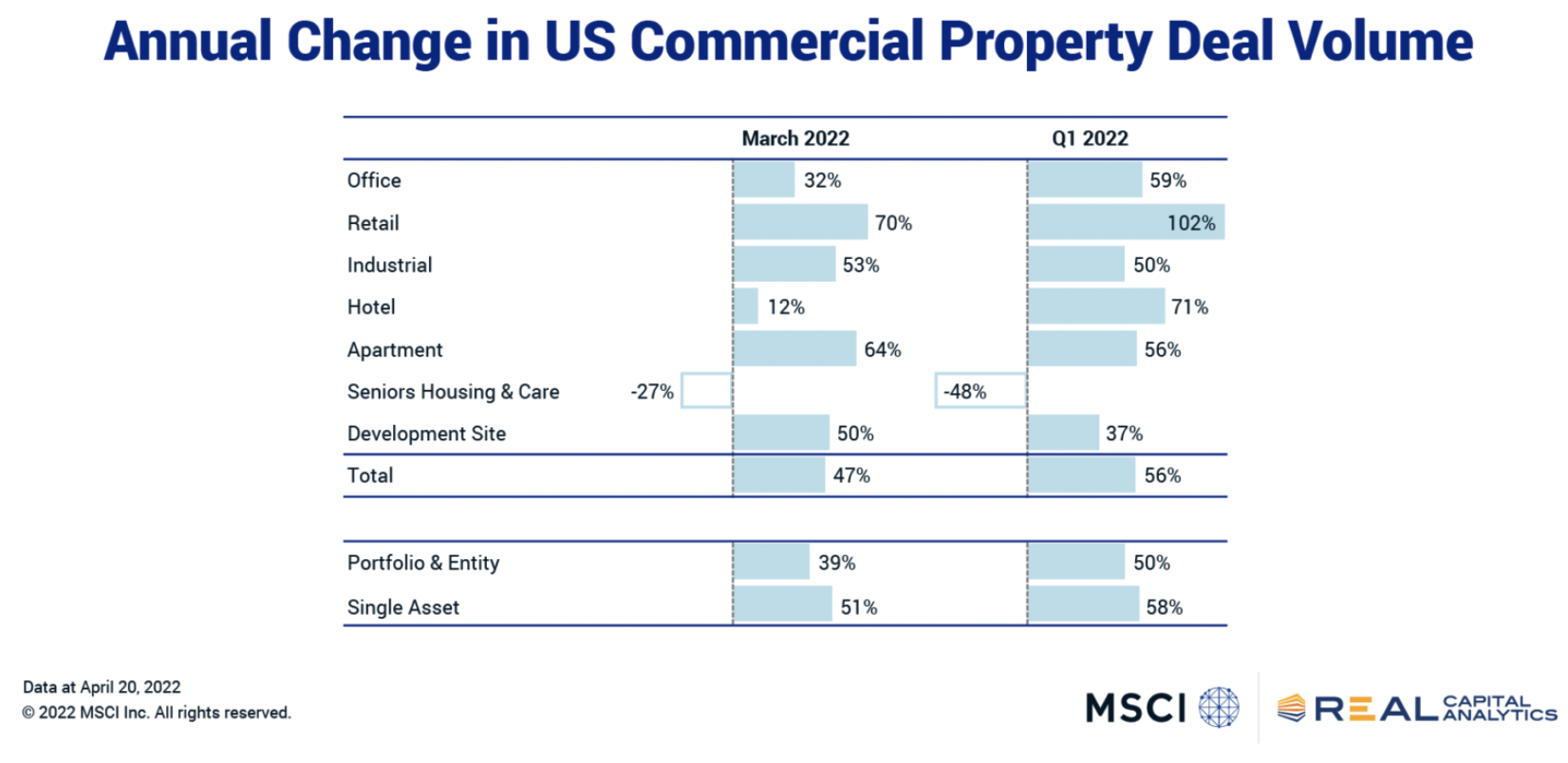
US Commercial Real Estate Sales Motor on in First Quarter
U.S. commercial property sales climbed at double-digit rates from a year ago in Q1 2022 despite the uncertainty around war, interest rates and inflation. Sales activity in the first quarter increased 56% on the same period a year ago and in March activity increased 47% from a year prior, the latest edition of US Capital Trends shows. Closing a commercial property transaction is a process measured in months and weeks however, so the activity through the end of March likely reflects sentiment from the start of the year. The fallout from recent uncertainty, if any, would likely be seen in coming months. Individual asset sales grew at a 58% year-over-year rate in the first quarter, a slightly stronger pace than the market overall. Portfolio and entity-level activity rose because of M&A-type transactions. Entity-level deals totaled $11.8 billion versus none a year earlier. April 22, 2022
Source - read more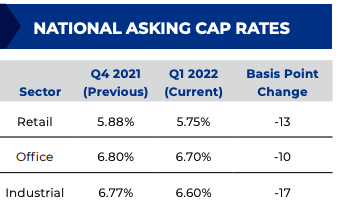
The Boulder Group Net Lease Market Report
Cap rates in the single tenant net lease sector reached historic lows for all three asset classes in the first quarter of 2022. Single tenant cap rates compressed by 13, 10, and 17 basis points for the retail, office and industrial categories respectively. Cap rate compression continues to be derived from the significant demand for net lease properties across all investor classes. Following record transaction volume in 2021, net lease sales velocity continued in the first quarter of 2022. Transaction volume in the first quarter of 2022 exceeded the first quarter of 2021 by more than 10% for the net lease sector. Q1 2022
Source - read more
National warehouse pipeline keeps expanding, but 30% of construction is in 4 markets
The U.S. industrial market is off to a busy start in 2022 as demand remains high for logistics, e-commerce and manufacturing space everywhere. Demand outpaced supply for the sixth consecutive quarter in the first quarter, with the U.S. market absorbing more than 108.7 million square feet of space in the first three months of the year, according to Cushman & Wakefield PLC (NYSE: CWK). That's an increase of 7.8% from Q1 2021. Meanwhile, construction is trying to keep up with record-level demand, with 546.1 million square feet underway at the end of Q1, Newmark Group Inc. (NYSE: NMRK) recently found. In Q1, 81.1 million square feet delivered nationally. And while seemingly every major U.S. metro area, and the tertiary areas around it, is seeing a big run-up in industrial construction, there are a few key markets where new warehouse space is dominating. Newmark found nearly one-third of all new industrial supply underway now is in Dallas, Phoenix, California's Inland Empire and Chicago. April 25, 2022
Source - read more
Inflation and Russia’s Invasion of Ukraine Expected to Take Toll on U.S. Economy and Housing Sector
WASHINGTON, DC – The Russian invasion of Ukraine, and its implications for the global economy, has added to growing inflation pressures and ongoing supply chain difficulties as monetary policy tightening begins, according to the March 2022 commentary from the Fannie Mae (FNMA/OTCQB) Economic and Strategic Research (ESR) Group. The ESR Group now projects full-year 2022 real GDP growth of 2.3 percent, down from last month’s projected 2.8 percent, but acknowledges that many of its forecast’s base assumptions, including a near-term resolution to the acute global economic effects of the Russian invasion of Ukraine, represent substantial downside risks to both the macroeconomic and housing outlooks. March 17, 2022
Source - read more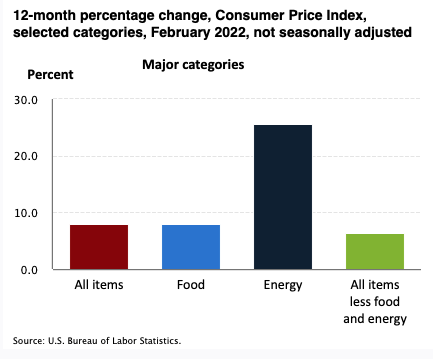
CPI up...again
The Consumer Price Index rose 7.9 percent from February 2021 to February 2022, following a 12-month increase of 7.5 percent in January 2022. Food prices increased 7.9 percent for the year ended February 2022, the largest 12-month advance since July 1981. Energy prices rose 25.6 percent from February 2021 to February 2022, while prices for all items less food and energy rose 6.4 percent. March 10, 2022
Source - read more
Mortgage Applications Decrease in Latest MBA Weekly Survey
WASHINGTON, D.C. (March 30, 2022) - Mortgage applications decreased 6.8 percent from one week earlier, according to data from the Mortgage Bankers Association's (MBA) Weekly Mortgage Applications Survey for the week ending March 25, 2022. The Market Composite Index, a measure of mortgage loan application volume, decreased 6.8 percent on a seasonally adjusted basis from one week earlier. On an unadjusted basis, the Index decreased 6 percent compared with the previous week. The Refinance Index decreased 15 percent from the previous week and was 60 percent lower than the same week one year ago. The seasonally adjusted Purchase Index increased 1 percent from one week earlier. The unadjusted Purchase Index increased 1 percent compared with the previous week and was 10 percent lower than the same week one year ago. March 30, 2022
Source - read more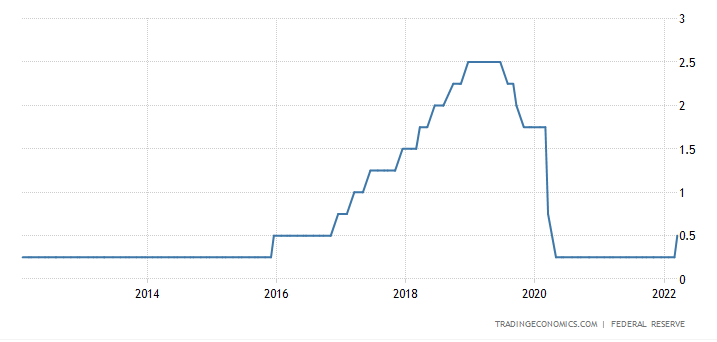
Fed will raise rates more aggressively, if needed, Powell says
March 21 (Reuters) - Federal Reserve Chair Jerome Powell on Monday delivered his most muscular message to date on his battle with too-high inflation, saying the central bank must move "expeditiously" to raise rates and possibly "more aggressively" to keep an upward price spiral from getting entrenched. In remarks that sent financial markets scrambling to recalibrate for a higher probability of the Fed lifting interest rates by a half-percentage point at one or more of its remaining meetings this year, Powell signaled an urgency to the central bank's inflation challenge that was less visible than just a week ago, when the Fed delivered its first rate hike in three years. March 21, 2022
Source - read more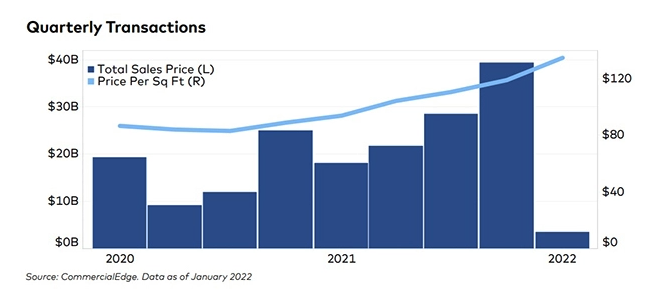
Industrial Transactions Surge
The first quarter is traditionally relatively quiet for commercial real estate transactions, but the industrial sector missed that memo this year. Real estate data platform CommercialEdge, Santa Barbara, Calif., said at least $3.6 billion in industrial transactions closed in January alone as more than 400 properties changed hands.“The average sale price of industrial buildings has increased for five consecutive quarters, and 2022 looks to continue that trend,” CommercialEdge said in its February National Industrial Report. The average sales price of an industrial property increased to $135 per foot in January from $119 per foot in the fourth quarter. March 15, 2022
Source - read more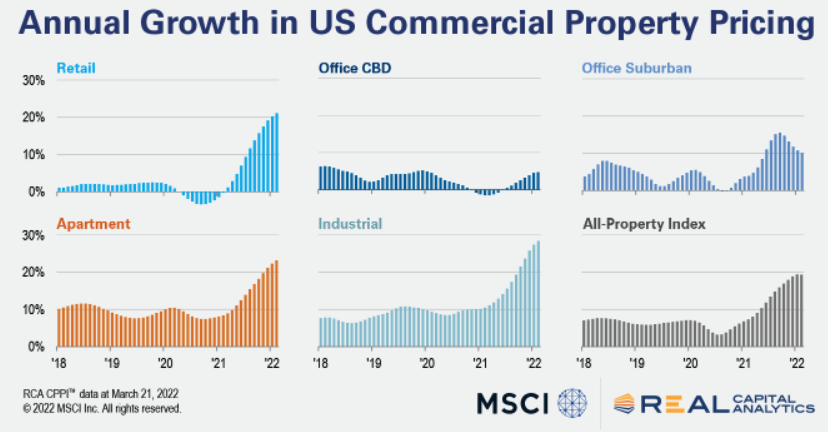
US Commercial Real Estate Prices Advance in February
U.S. commercial property price growth continued apace in February as all four major property types posted double-digit annual price growth. The US National All-Property Index rose 19.4% from a year ago and 0.8% from January, the latest RCA CPPI: US report shows. Industrial prices climbed 28.5% from a year prior, the fastest annual rate among the major property sectors in February and a record for any property type since the inception of the RCA CPPI. In June 2021 industrial price growth surpassed its previous high, seen prior to the Global Financial Crisis, and growth has accelerated every month since. March 24, 2022
Source - read more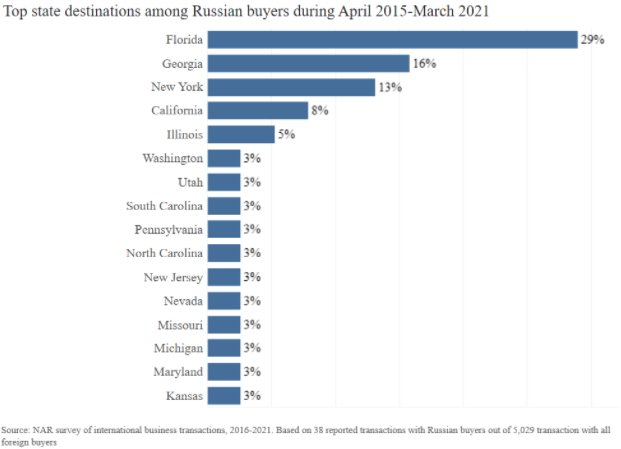
What Impact Could Russia Sanctions Have on the Housing Market?
Russia has been in the headlines a lot lately and for good reason—whether you call it a “conflict” or “military offensive” an “invasion” or “war,” Russia’s recent actions are having global consequences. Seemingly every hour, news comes out about another government or company that is closing up operations in Russia as a show of solidarity with Ukraine. Knowing this, the National Association of Realtors (NAR) rehashed it’s 2021 International Transactions in U.S. Residential Real Estate Report (originally released in July 2021) to find out the impact of Russian buyers and investors on the U.S. real estate market as a whole. March 9, 2022
Source - read more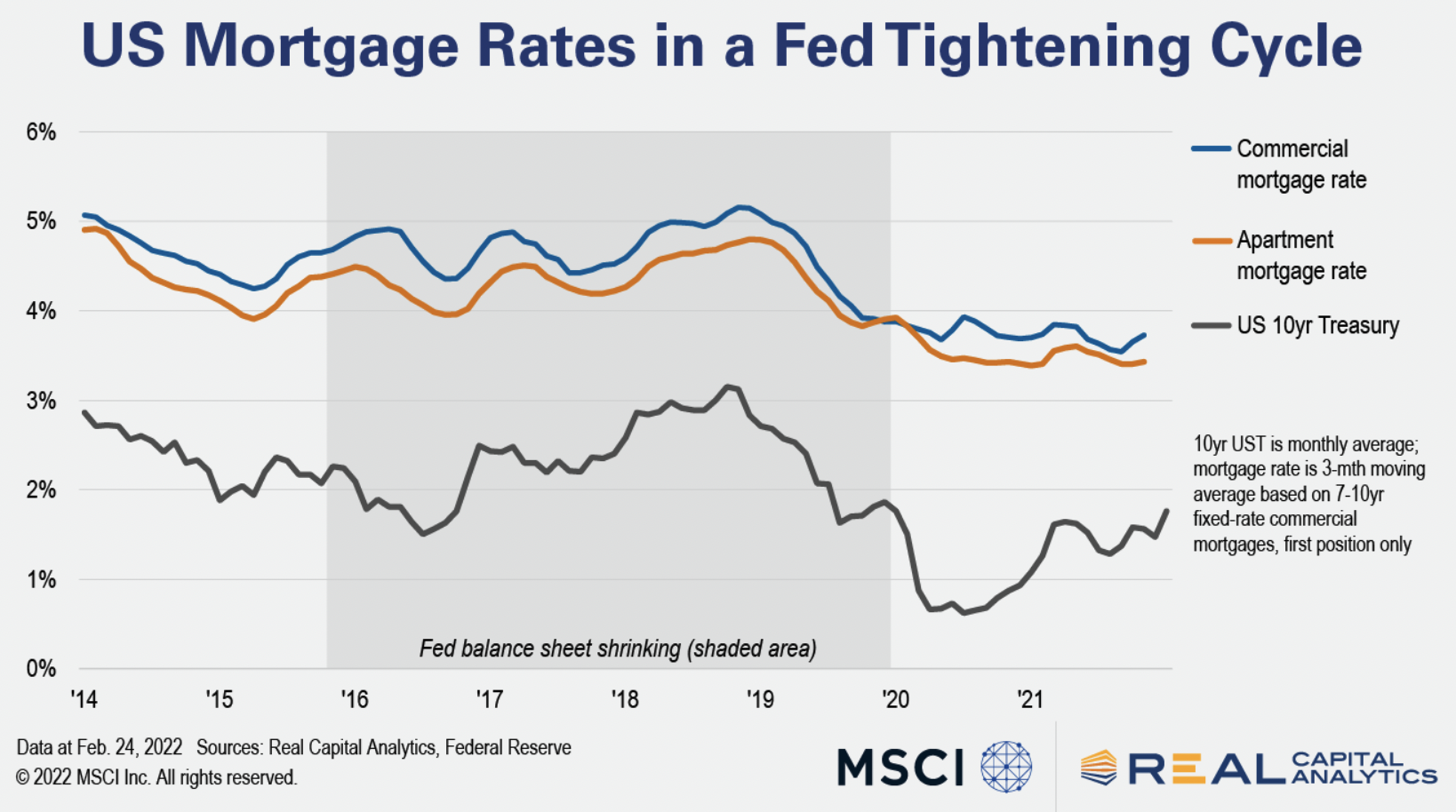
The US Mortgage Market in a Rising Rate Environment
Less than a month ago, thousands of real estate industry professionals gathered in San Diego for the Mortgage Bankers Association CREF22 conference which was, for many, the first in-person event since the onset of the pandemic. Participants were optimistic coming off a frenetic pace of mortgage originations in 2021, but there was an undercurrent of concern over future moves by the Federal Reserve and the impact on mortgage rates. At the time, the tensions between Ukraine and Russia were only a side conversation. Much has changed since then. Russia’s invasion of its sovereign neighbor on February 24 has forced market participants to recalibrate their expectations for inflation, policy changes at the Fed, and trends in economic growth. Despite the uncertainty that is present, market participants need to remain active and make decisions. March 8, 2022
Source - read more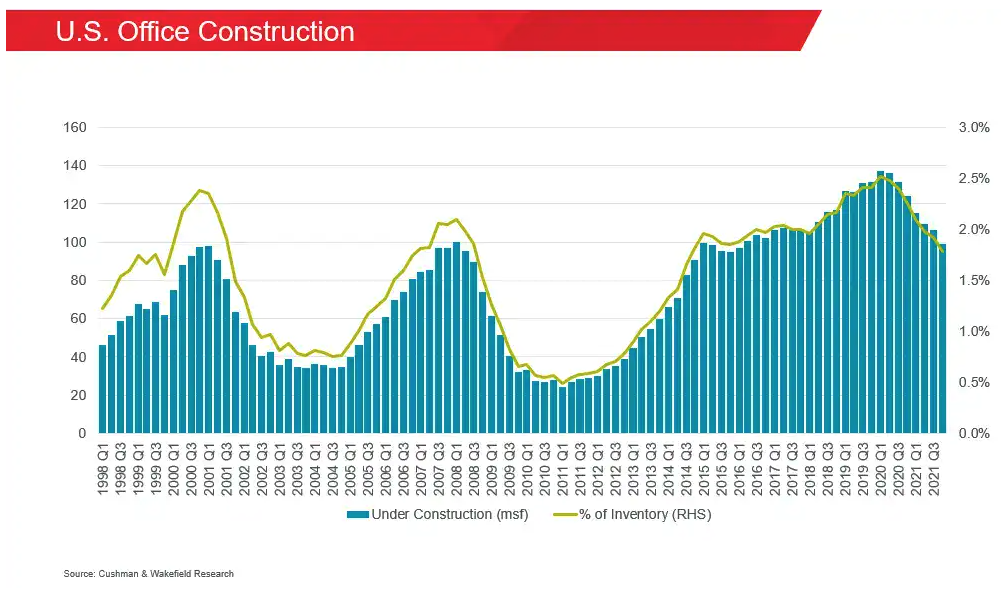
Office Construction Pipeline Remains Above Historic Average
Cushman & Wakefield (NYSE: CWK), a leading global real estate services firm, today released a construction report, surveying 24 select office projects currently under construction in 12 major U.S. markets and Toronto. The report finds that new construction is commanding a significant rent premium of 64% over average Class A submarket rents, and 20% over existing top-tier trophy assets. “Tenants are demonstrating a strong bias for the highest quality, newly constructed office projects across major US and Canadian markets – they are looking for a fundamentally different, elevated, office experience,” said Rebecca Rockey, Cushman & Wakefield’s Global Head of Economic Analysis & Forecasting. February 16, 2022
Source - read more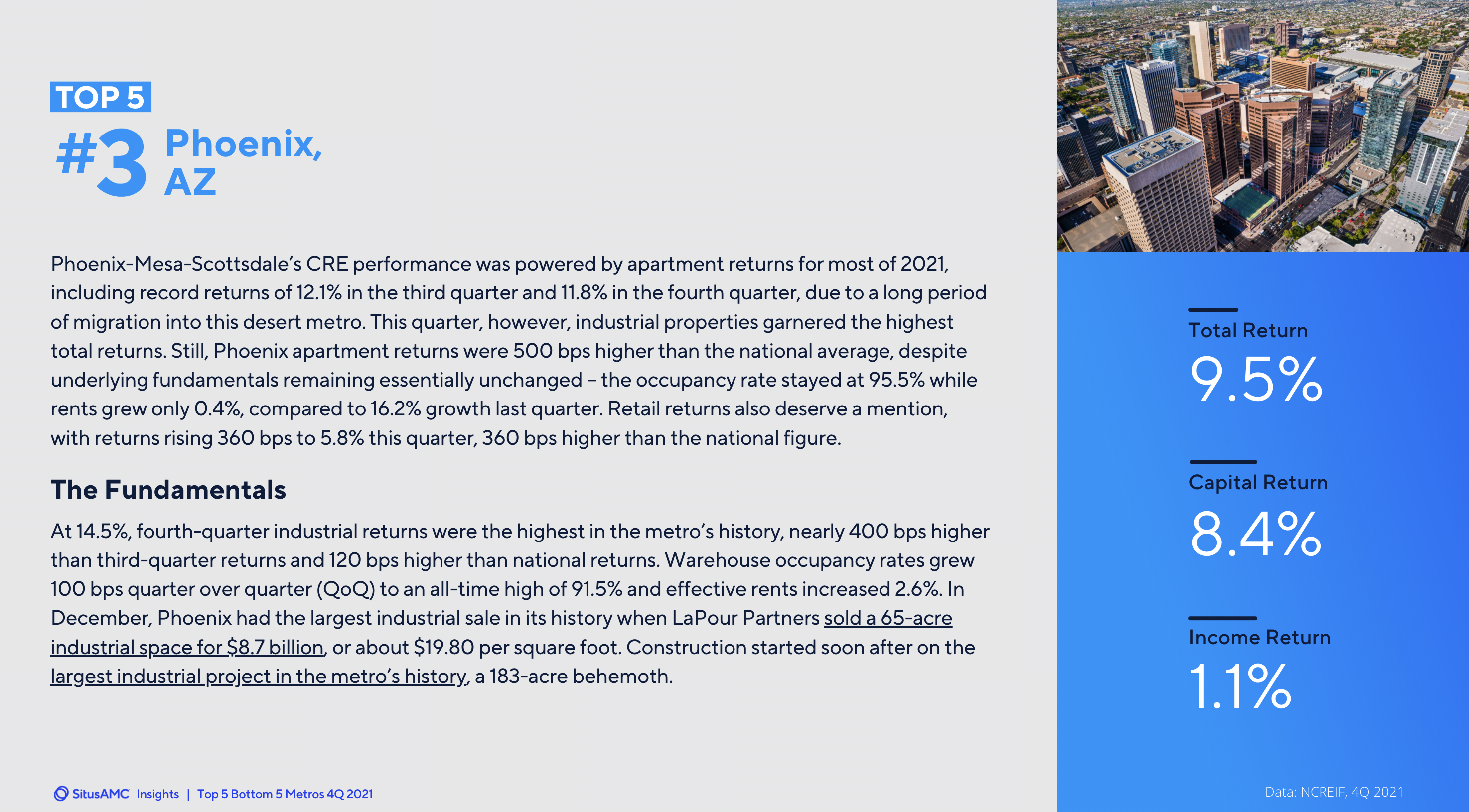
Investors Rank the Best and Worst Commercial Real Estate Sectors, 4Q 2021
SitusAMC Insights recently asked institutional commercial real estate firms and regional companies to rank what they believe will be the best-performing and worst-performing property sectors over the next year. Click through our 4Q 2021 slideshow to see the latest expectations for office, apartment, industrial, retail and hotel properties in 2022, and the key trends driving investor interest. March 1, 2022
Source - read more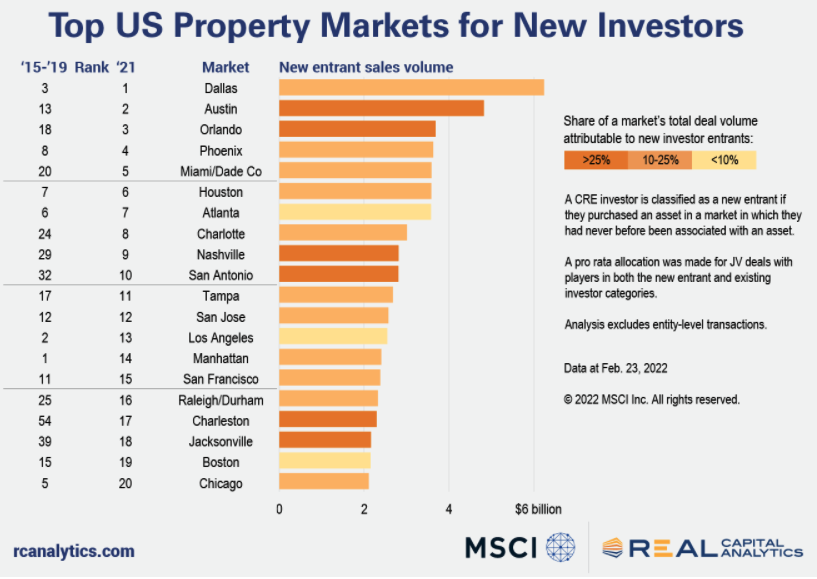
Top US Property Markets for New Investor Entrants
There is a first time for everything, and such was the motto of some investors in the U.S. as they made their first purchases outside of their traditional geographic footprint in 2021. A list of the top markets for new entrants provides some insight as to where investors headed and what factors lured them there. For some first-time market participants, the decision to expand their geographic horizons had less to do with geography and more to do with access to a specific asset class. In 2021, investor appetite for apartment product was seemingly insatiable, so much so that many investors chose to enter new markets for deals. All but four of the top 20 markets for new entrants sourced more capital from apartment purchases than any other asset class. March 1, 2022
Source - read more
Seven Must Reads for the CRE Industry Today
Many companies, including American Express, Meta and Wells Fargo, are planning large-scale returns to the office in March, reports The Wall Street Journal. W.P. Carey struck a $2.7 billion deal to acquire Corporate Property Associates 18—Global Inc., according to Commercial Property Executive. These are among today’s must reads from around the commercial real estate industry. March 2, 2022
Source - read more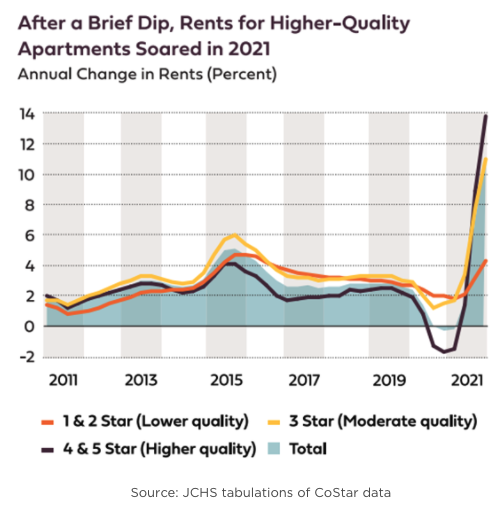
Harvard: Surging Rental Market Divided by Race, Income
Rental housing demand roared back in the pandemic’s second year, reducing vacancy rates and driving up rents, the Harvard Joint Center for Housing Studies reported Friday. In America’s Rental Housing 2022, the JCHS noted some of the rental rebound comes from an inventory shortage in the for-sale market, which has kept many higher-income renters from buying homes. “At the same time, however, many lower-income households, and especially lower-income households of color, still struggle to pay the rent,” the report said. As rental housing markets heated up in 2021, the overall rental vacancy rate dropped to just 5.8 percent–its lowest reading since the mid-1980s, the report said. Strong demand also pushed rents upward; asking rents spiked in the third quarter, led by a 13.8 percent jump for units in higher-quality buildings. January 23, 2022
Source - read more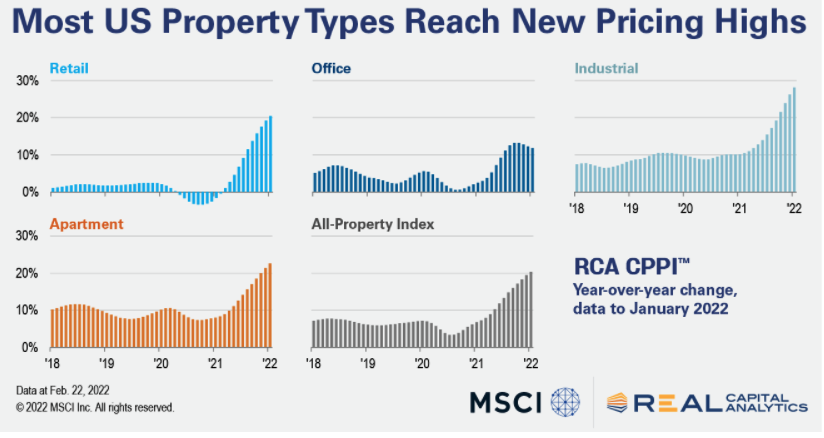
US Commercial Property Prices Touch New Highs; Office Lags
The headline rate of U.S. commercial property price growth extended a rally of accelerating double-digit price growth in January. The RCA CPPI National All-Property Index climbed 20.3% from a year earlier and 1.6% from December, the latest RCA CPPI: US report shows. The price index for industrial properties rose a record 28.1% from a year ago, the fastest annual rate among the major property sectors. The index for retail properties increased 20.4% year-over-year, a record for this sector according to the latest data. Apartment sector prices posted an annual gain of 22.5%, the ninth consecutive month of double-digit price growth. Apartment property prices in January were 136% higher than the peak set ahead of the Global Financial Crisis, far outpacing industrial, the next highest sector index. Price gains for the office sector lagged in January. The office index rose 11.8% year-over-year, a fourth successive month of ebbing annual growth. While CBD office price gains are creeping higher, suburban office price growth has lost steam in recent months. February 25, 2022
Source - read more
Real House Prices Increased 21.7% YoY in December
First American Financial Corporation has released its latest iteration of their Real House Price Index (RHPI) for December 2021, which measures the price changes of single-family properties across national, state, and metropolitan areas, which are adjusted based on income, interest rates, and home-buying power. The ultimate goal of this is to provide a clearer picture of housing affordability. According to First American, the three key points of the First American RHPI are income, mortgage rates and an unadjusted house price index. Incomes and mortgage rates are used to inflate or deflate unadjusted house prices in order to better reflect consumers' purchasing power and capture the true cost of housing. for the month of December, First American found that real house prices increased by 21.7% year-over-year or 1.9% from November 2021. This represents the highest annual growth rate seen since 2014. It also found that the average house now costs $476,980 up $1,800 from $475,180 in November while the average household income is $70,344, up by $537 from $69,807. February 28, 2022
Source - read more
Russia Invades Ukraine: The Picture for Commercial Property
The grim news of Russia’s invasion of Ukraine means Western-backed sanctions on Russia are poised to reach unprecedented levels. For global real estate, the immediate and direct impact from these measures will likely be negligible. Russian capital has very little presence in global commercial property markets: outbound flows have averaged just $330 million per year in the last five years and known Russian ownership of commercial assets in the world’s largest property markets is sparse. Additionally, Ukraine’s institutional property market is small and domestic, therefore, international exposure is minimal. The impact on commercial real estate will likely be indirect, as the effects of the conflict feed through into commodity prices, inflation, bond yields and ultimately perhaps economic growth. The main mechanism is likely to be through higher energy prices, which add to the inflationary forces already being felt across most European economies. Brent crude prices breached $100 a barrel for the first time since 2014 and European natural gas prices spiked in the hours immediately after the invasion of February 24th. February 24, 2022
Source - read more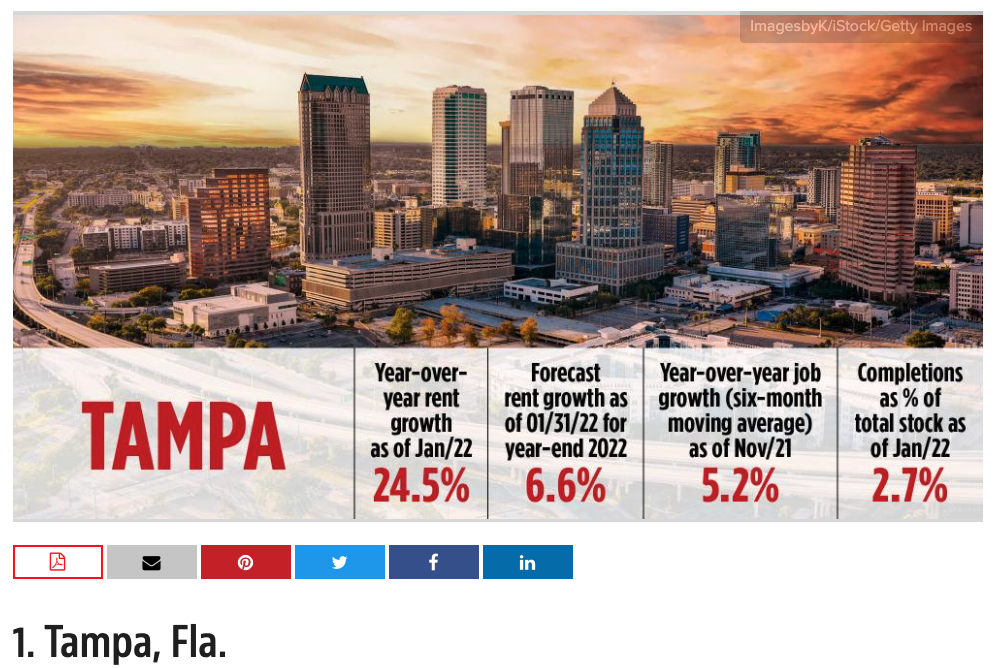
Top 25 Markets for Forecasted Multifamily Rent Growth in 2022
January brought another double-digit increase in multifamily asking rents. Which markets are likely to continue to see outsized growth in 2022? Continuing a trend that has been seen for most of last year, multifamily rents nationwide registered an increase in January 2022, according to a new report from real estate data firm Yardi Matrix. Average asking rents rose by 13.9 percent on a year-over-year basis, to $1,604 a month. Yardi Matrix researchers point out that January is historically a month when multifamily rent growth tends to be weaker and last month’s growth, which amounted to an average of $8 per month, was indeed below the $22 per month increase registered between March and October of 2021. But they add that the rent increases seen in January point to strong fundamentals in the multifamily sector, with unit absorption last year doubling from 2020, to 460,000. February 14, 2022
Source - read more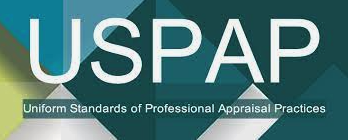
NCUA, CFPB, HUD, FHFA, more call out TAF appraisal bias standards
The NCUA, CFPB, and several other agencies including the Office of the Comptroller of the Currency (OCC), Federal Deposit Insurance Corporation (FDIC), Department of Housing and Urban Development (HUD), Federal Housing Finance Agency (FHFA), and Federal Reserve Board (FRB) Friday wrote to The Appraisal Foundation (TAF), a private non-governmental entity with the sole power to set professional standards for appraisers, regarding appraisal discrimination. The agencies called out TAF for failing to “include clear warnings about the requirements of federal law in the standards it sets, and in the training it provides for appraisers.” The agencies provided specific feedback on TAF’s proposed changes for the 2023 Edition of the Uniform Standards of Professional Appraisal Practice (USPAP). The agencies commented on a provision under the USPAP which states that an “appraiser may not rely on unsupported conclusions relating to characteristics such as race, color, religion, national origin, sex, sexual orientation, gender, marital status, familiar status, age, receipt of public assistance income, disability or an unsupported conclusion that homogeneity of such characteristics is necessary to maximize value.” February 7, 2022
Source - read more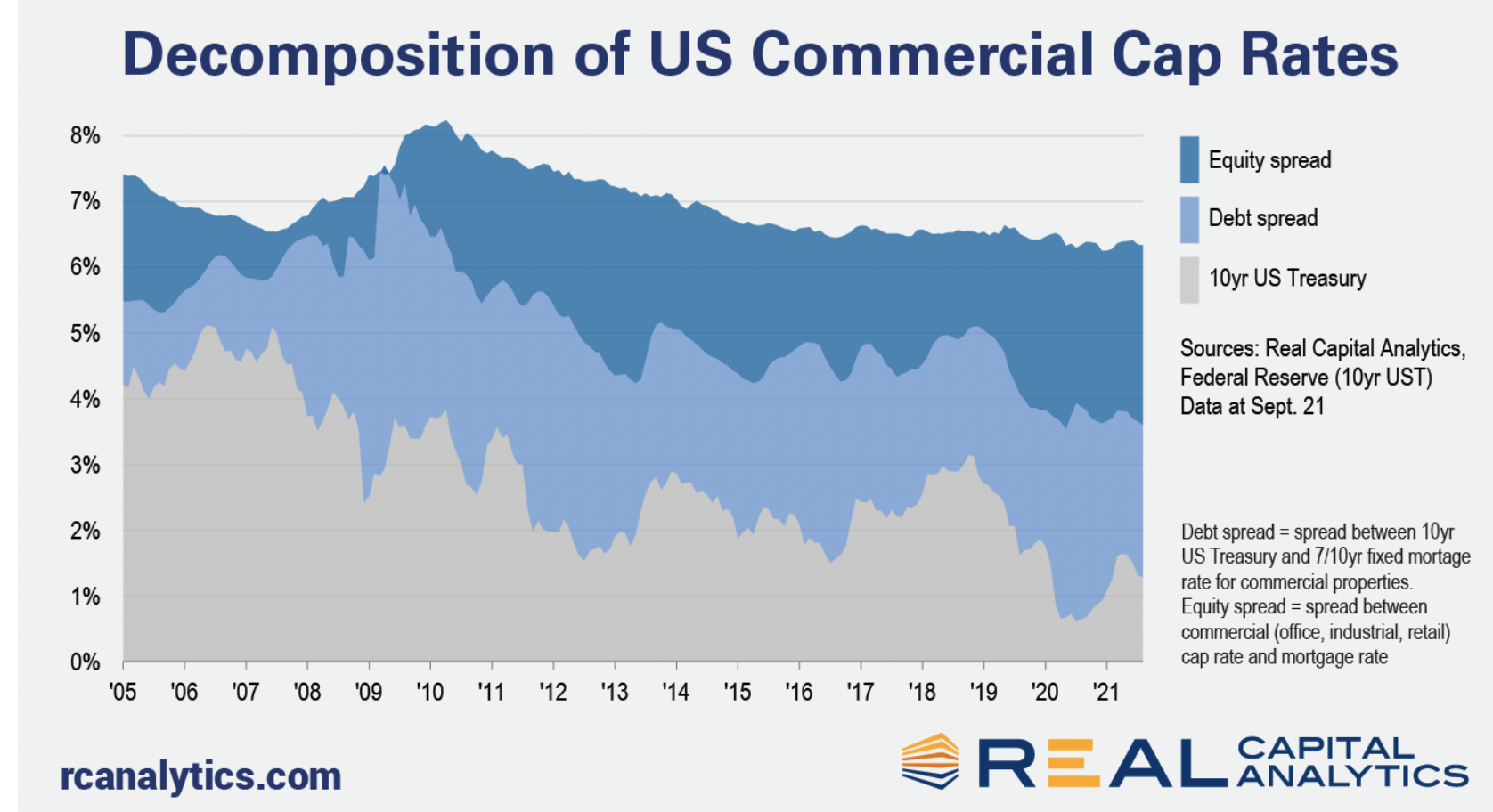
The Fed Will Eventually Taper. What Happens to Cap Rates?
The infamous dot plot from the Federal Reserve meeting last week suggests an expectation of a 2022 liftoff for U.S. interest rates. But who knows, forecasting interest rates is not like forecasting commercial property market trends: a lot can happen quickly. Still, seeing that chart, market professionals are asking if cap rates will go up if that expectation comes to pass in 2022. My question is, why should cap rates start responding to interest rates now all of a sudden? There are a number of ways to unpack cap rates, what drives them, and how investors should set expectations around them. The simplest and most pervasive approach I see is one where investors look at expectations on trends for the 10yr US Treasury, add the current spread to cap rates to that future expectation, and assume that cap rates move up in tandem. This approach never works as there has never been a one-to-one correlation between cap rates and interest rates. This is not to say that these measures are not linked. If the 10yr UST goes up to, say 19%, the commercial real estate industry is going to have a bad time. All rate instruments are linked, but are not in lockstep. Think of the variation in term across the yield curve. The slope of that curve changes over time with short- and long-term rates moving up and down based on the different risk expectations investors have for each of the time frames. Investors in different portions of the capital stack for commercial property likewise can have varying expectations on risk. Sept 29, 2021
Source - read more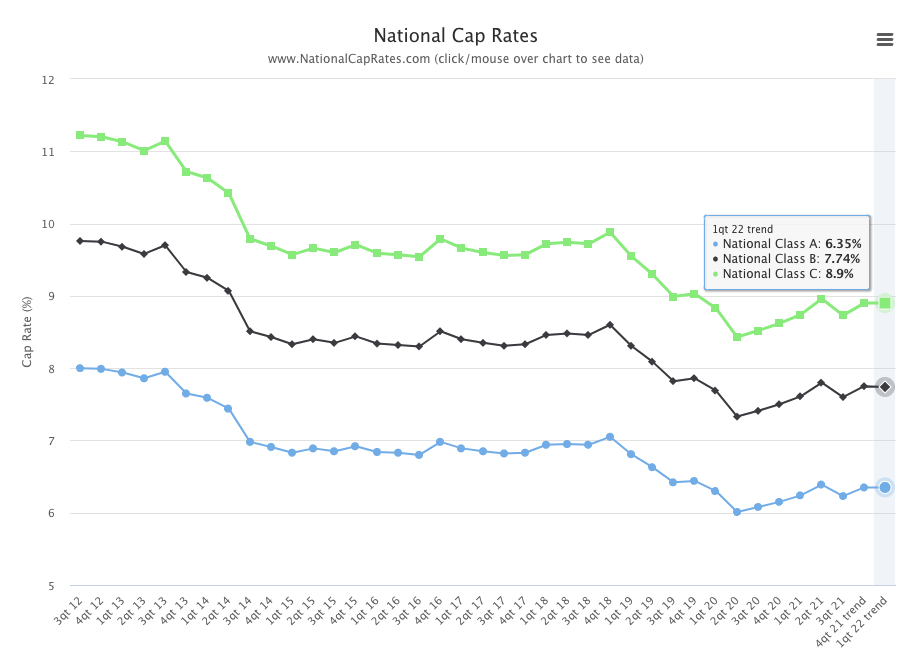
Cap Rates remain generally stable
Nationally the average cap rate (Class B property) is expected to remain generally stable for the next quarter with a slight up-tick from 7.6% to 7.74%. The Class A rate is projected to rise 12 bp to 6.35% by the 2Q 2022. When comparing broad sectors (Class A) MF is currently the lowest at 5.63% while restaurants (6.91%), self-storage (6.64%) and retail (6.4%) are on the high end. While no major melt down in distressed asset sales occurred in 2021, changes is work behavior, with so many working from home, has put a dent in the office sector, but probably buoyed up the franchise restaurant and industrial (think factory to home delivery) markets. The housing crunch, with rents rising 20% or more in some markets, has created a hot MF sector. The FED's pressure on keeping interest rates low has helped in keeping cap rates lower than expected with the anticipated easing of interest rates likely to increase risk factor and put pressure on slightly higher rates my mid-2022. While the correlation between interest rates and cap rates is more indirect than direct, they are linked, kind like being connected by a rubber band instead of a metal bracket. Too much pressure on one will likely move the other. Overall I expect a cap rates to remain generally stable at least through mid 2022. This could all change if investor perceived risk such as hyper-inflation, political tumoral or natural disasters change consumer behavior. January 4, 2022
Source - read more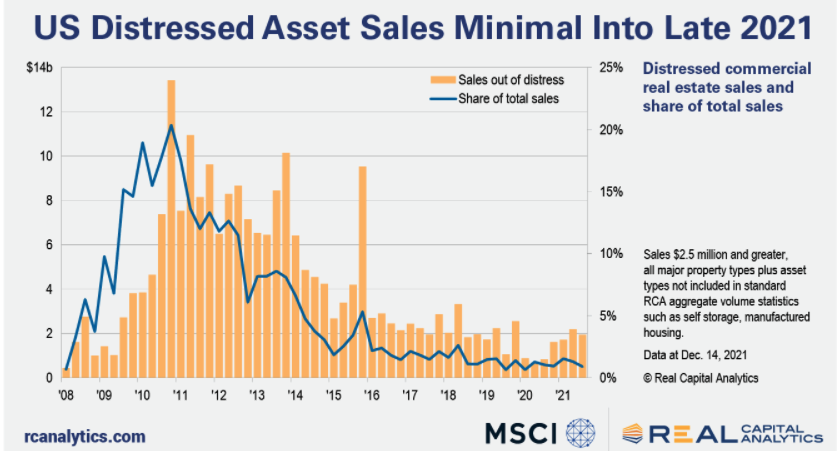
The Commercial Property Crisis That Wasn’t
People tend to fight the last war. This truism applies to many aspects of life where people assess problems by interpreting them in light of previous bad experiences. The Covid-19 crisis and the resulting recovery in investment activity into 2021 makes a great case for never following this simple behavior. The Covid-19 crisis led to a flurry of fund announcements where investors planned to use the distressed investment playbook that worked so well after the Global Financial Crisis (GFC). These fund managers raised money on a mistaken belief that this downturn would be the same as the last. To date, distressed asset sales have been minimal as the nature of the crisis was uniquely different from previous downturns. Distressed asset sales are still few and far between late into 2021, representing a smaller share of the market than at this point after the onset of the GFC. That crisis started in December of 2007 and six quarters into the downturn distressed asset sales were behind 7% of the market, on the way to a 20% share of total. In Q3 2021, roughly the same lag after the start of the GFC, such sales represented less than 1% of total sales. Dec 14, 2021
Source - read more
Nearly 1M Renters Priced Out of Home Ownership
Many first-time buyers continue to struggle to move into homeownership amid sustained price growth and competition from all-cash buyers. The share of first-time buyers fell to 26% in November, according to the November REALTORS Confidence Index Survey. This is the lowest level since January 2014, which was also 26%, and since NAR started tracking the share of first-time buyers on a monthly basis in October 2008. NAR also found that nearly 1 million renter households got priced out of the market due to the price increase in 2021. During January-November 2021, the median existing-home sales price averaged $345,442, a 16.4% year-over-year increase from the median sales price of $296,700 in 2020. At this price, the income a household needs to pay the mortgage affordably such that the monthly mortgage payment and interest payment don’t exceed 25% of income rose to $62,872, up from $55,186. Article originally posted on Globe St. on January 3, 2022
Source - read more
A Quarter of LA’s Office Space Is Available for Lease
Although everyone was hoping for a recovery in 2021, office leasing activity in Los Angeles still pales in comparison to pre-pandemic levels. A new report from Savills estimates that L.A. added about 2.4 million square feet in the past year, and leased about 3.6 million square feet in the fourth quarter of 2021, which is a quarterly high since the pandemic hit. But, with 11.9 million square feet of office space leased last year, 2021 saw 34 percent less than the 18 million square feet that was gobbled up in 2019. Savills also estimates that the L.A.’s total available office space — or the sum of vacant and soon-to-be vacant space — is up to its highest level in more than a decade at 24.4 percent, showing how soft the office market is right now. “A more robust office market recovery continues to depend on the path of the coronavirus as many workers remain at home, especially in light of the recent omicron variant at year-end,” according to Savills’ report. January 3, 2022
Source - read more
Where Inflation Is Highest in U.S.
U.S. inflation rose at the fastest pace in three decades in October, with prices increasing more in some parts of the country than in others. Consumer prices were up 7.3% last month in the region that encompasses Iowa, Kansas, Minnesota, Missouri, Nebraska, North Dakota and South Dakota. Mid-Atlantic states, however, saw prices rise less, by 5.4% from a year ago. Midwesterners saw relatively higher housing costs in October, with rent, natural gas and home furnishings all rising at a brisker clip than in other regions. Rental prices in Northeastern states, by contrast, grew at a much slower pace than elsewhere last month. The overall jump in inflation has been driven, in part, by surging transportation costs. Gasoline prices in October jumped nearly 50% from a year ago. The 9.8% leap in new vehicle prices marked the sharpest increase since 1975. November 10, 2021
Source - read more
Lenders Foresee Return to a More ‘Normal’ Housing Market in 2022
WASHINGTON, DC – For the fifth consecutive quarter, a plurality of mortgage lenders expect near-term profitability to decrease, according to Fannie Mae's (FNMA/OTCQB) Q4 2021 Mortgage Lender Sentiment Survey® (MLSS). In fact, according to the survey, 65% of mortgage lenders believe profit margins will decrease in the next three months, up from 46% in the prior quarter, while 31% believe profits will remain the same and 3% believe profits will increase. Competition from other lenders and market trend changes were once again the top reasons cited for the profitability expectations. Additionally, across all loan types, more lenders this quarter reported reduced consumer demand over the previous three months for both purchase and refinance mortgages. Looking ahead, again across all loan types, lenders on net expect purchase mortgage demand to remain largely stable, while refinance demand is expected to decrease substantially. December 15, 2021
Source - read more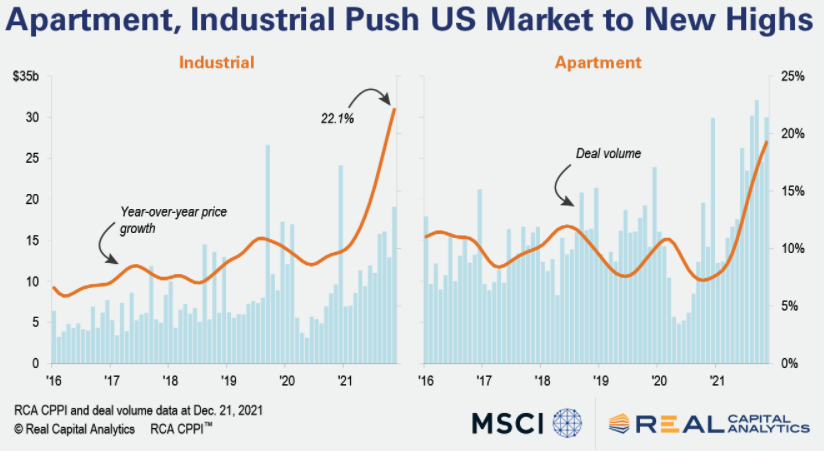
US Commercial Real Estate Sales, Pricing Hit Record Levels
U.S. commercial real estate sales and pricing reached record levels in November, driven by the apartment and industrial sectors. Investment volume for the first 11 months of the year has already made 2021 a record year, even without deal activity in December which is normally the busiest month. The headline rate of U.S. price growth also touched a new high. In both the apartment and industrial sectors, deal volume has already exceeded previous annual highs on the strength of year-to-date activity, as shown in the new edition of US Capital Trends. The apartment and industrial sectors also posted the fastest annual growth in prices in November, the latest RCA CPPI: US report shows. The apartment index rose 19.2% year-over-year, a record for the sector, eclipsed only by the industrial index which climbed 22.1%, which is the fastest pace for this series. The RCA CPPI US National All-Property Index accelerated to an 18.4% annual growth rate, another record. December 23 2021
Source - read more
CoStar Predicts: Office Vacancy Lingers in Major Markets
The country’s top-tier cities have lost some of their pre-pandemic luster as many grapple with higher office vacancy rates and softer leasing in the global health crisis. San Francisco, New York, Boston and Los Angeles are among the cities facing steep challenges in regaining leasing momentum and increased occupancy, both of which eroded in the pandemic. While the outlook for new leases nationally appears to be improving, more uncertainty about tenant demand has created a murkier picture for these gateway markets. Similar to other elements in the global pandemic recovery, the national commercial real estate market probably faces a bifurcated effort to return to pre-COVID levels of growth. In cities throughout the Sun Belt, for example, office leasing has largely returned to normal levels and markets haven’t been weighed down by an onslaught of new developments or space. But in premier gateway markets — many of which have a higher share of remote-capable jobs, denser environments and a greater reliance on public transit — the slower return of leasing and a higher share of new construction moving through the development pipeline probably mean vacancy rates will remain at or near record highs throughout 2022. December 28, 2021
Source - read more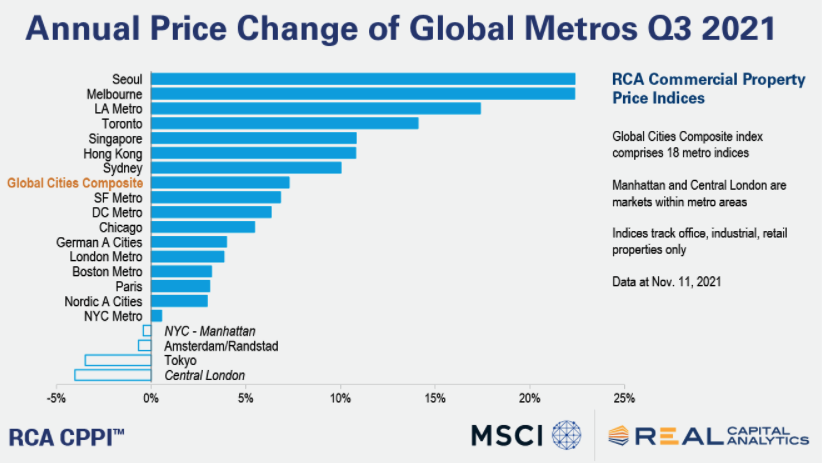
Global Commercial Property Price Growth Accelerates in Q3
Global commercial real estate price growth accelerated in the third quarter of 2021, with the Asia Pacific region leading price gains, the latest RCA CPPI Global Cities report shows. The RCA CPPI Global Cities Composite Index climbed 7.3% in the third quarter from a year ago, up from the 6.1% year-over-year pace seen the prior quarter and the 2.5% rate seen in the third quarter of 2020 amid the pandemic’s challenges. The headline composite index for Asia Pacific rose 11.6% from a year ago, reflecting in part the dip in the region’s prices seen a year ago. Seoul led price growth, a shade ahead of Melbourne. In the Americas, the composite index for the region rose 7.4% year-over-year. Commercial prices in the Los Angeles metro area were the fastest growing among the seven North American metros tracked. November 11, 2021
Source - read more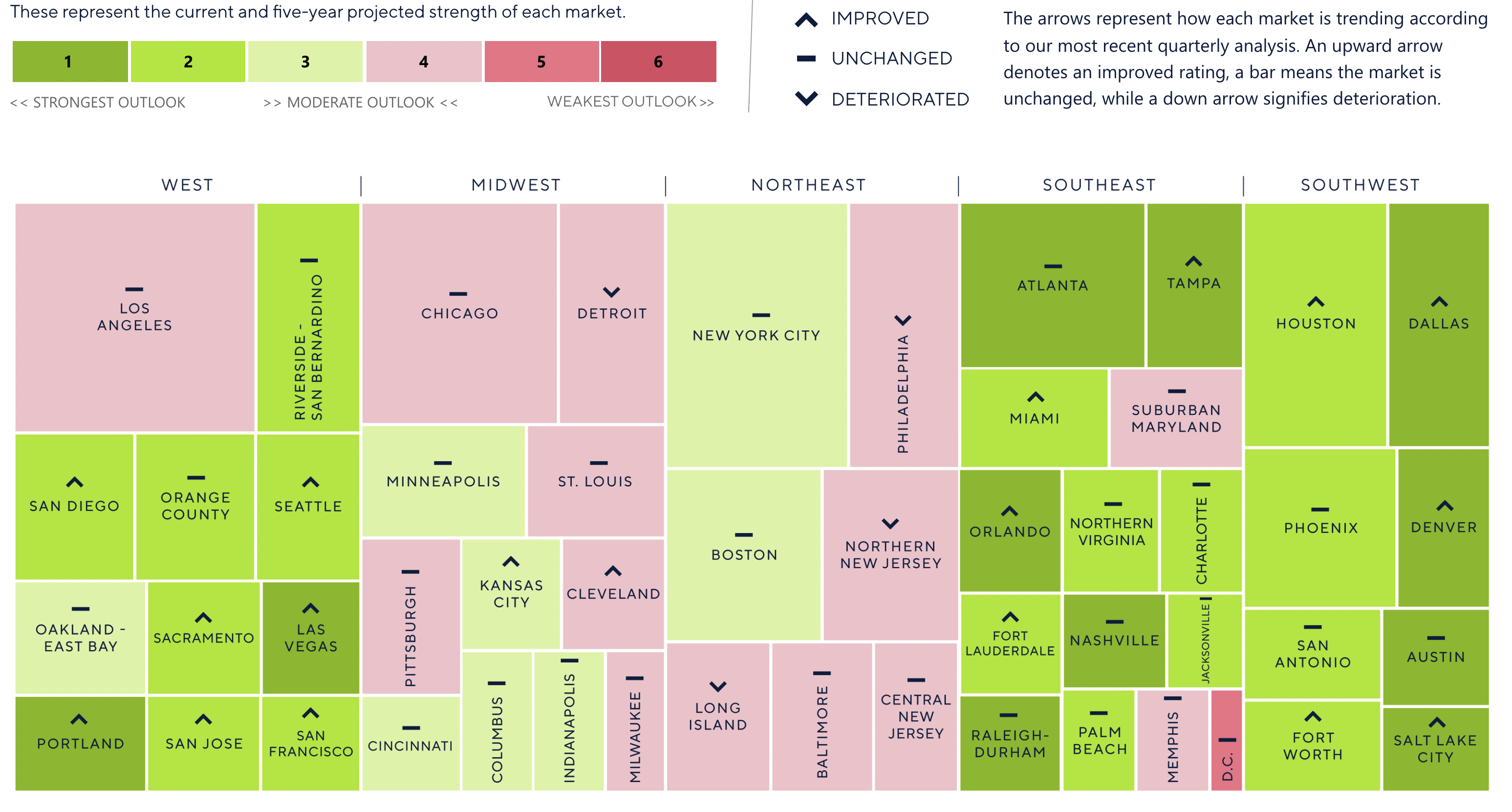
SitusAMC Momentum Heat Map
Our quarterly Heat Map analysis found the economic rebound to be regional, with the West looking more like the booming Southeast and Southwest than the slower Northeast and Midwest. The overall Current Momentum rating – an average of all markets that gauges current and forecasted near-term growth – improved from 2.8 to 2.5 (on a scale of 1 indicating robust conditions and 6 signaling a weak economy), meaning that overall growth has continued to improve. After jumping out of the pandemic slowdown gate in the previous quarter, when 40 of the 50 top markets improved and only one worsened, the latest Current Momentum showed 18 markets improving, while four markets worsened. There was a notable trend of the strong becoming stronger, with 16 of the 18 improved ratings graduating from either a 3 to a 2 or a 2 to a 1. Of the four that dropped in rating, all went from a 3 to a 4. Another trend connecting improving markets is that, outside of the Sun Belt, each region’s largest markets either were stagnant or worsened. 3 Qt 2021
Source - read more
Redfin Reports 10 Housing Records Set in 2021
The coronavirus pandemic and the resulting surge in remote work have changed where, when, why and how people buy homes, according to a new report from Redfin (redfin.com), the technology-powered real estate brokerage. This past year, home-sale prices hit the highest median of all time, the number of homes for sale fell to an all-time low, and there was record demand for second homes. 10 records from 2021. Record #1: The typical U.S. home sold for nearly $400,000 Record #2: Home supply dropped to its lowest level in history Record #3: The typical home sold in just 15 days Record #4: Over 60% of homes went off the market in two weeks Record #5: More than half of homes sold above list price Record #6: Mortgage rates dropped to 2.65% Record #7: Investors purchased nearly 1 in 5 of all homes bought in the U.S. Record #8: Demand for second homes nearly doubled from before the pandemic Record #9: Nearly one-third of Americans looked to move to a different metro area Record #10: The typical luxury home sold for 25% more than the year before December 13, 2021
Source - read more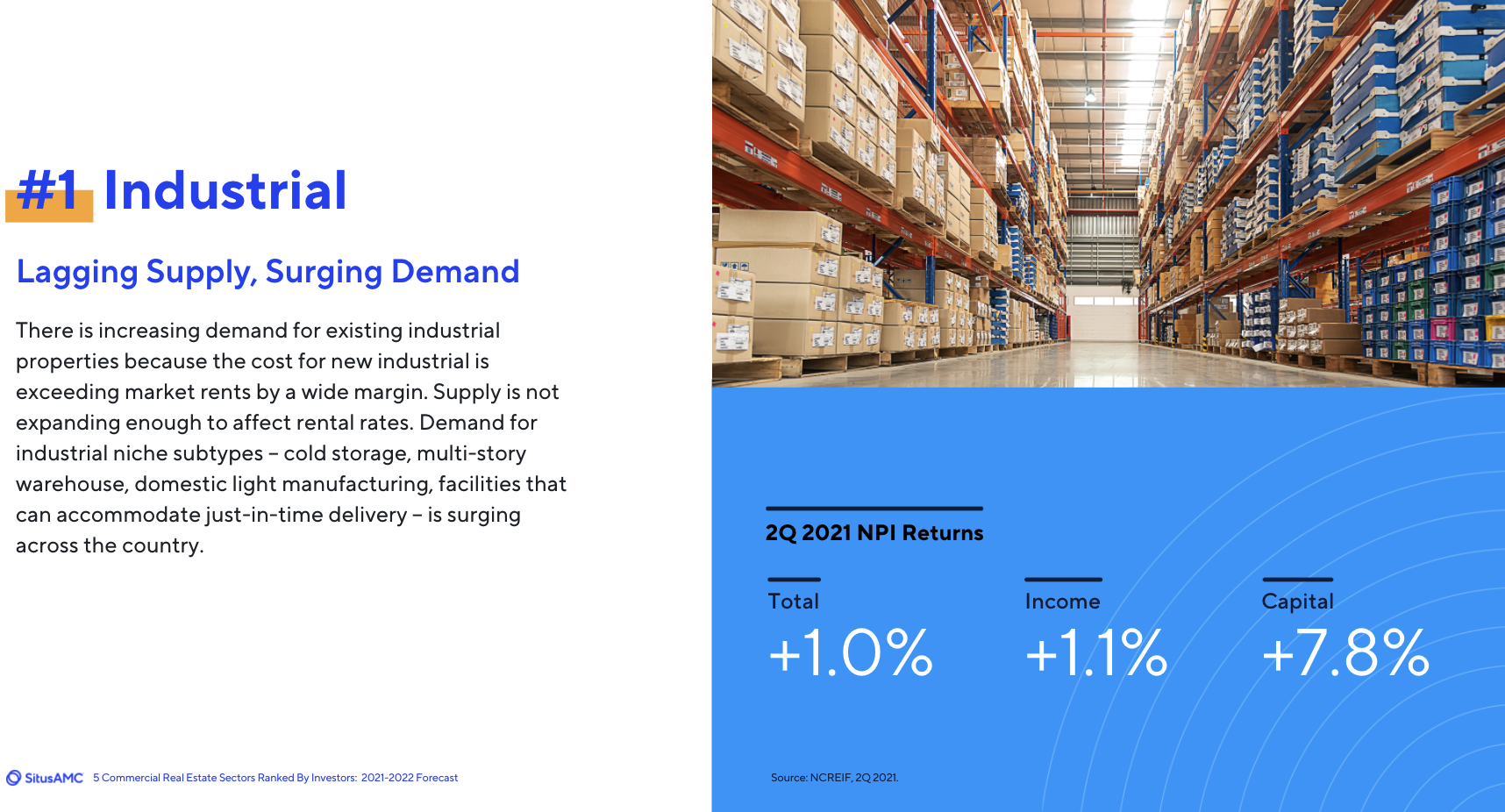
5 Investor Ranked Commercial Real Estate Sectors
In a recent survey, SitusAMC Insights ask professionals in institutional real estate firms and regional companies what they believe will be the best-preforming property sectors on the next year, and which should be avoided. Sept 15, 2021
Source - read more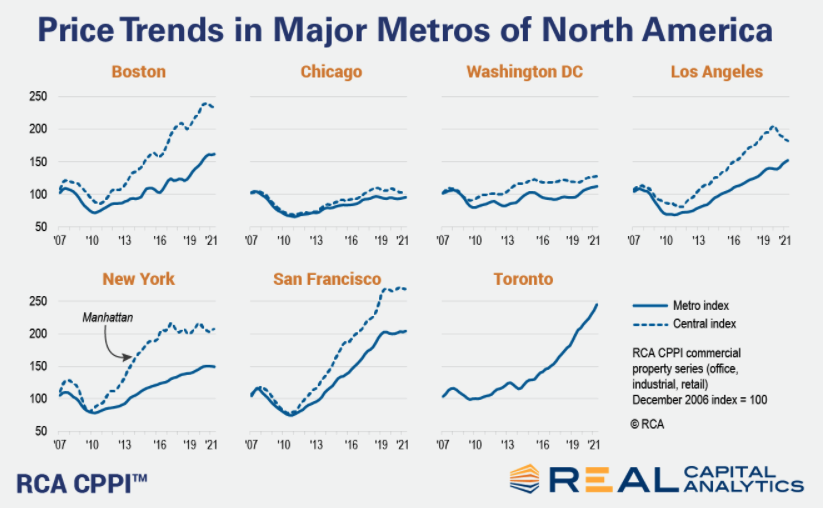
Property Price Trends in Boston, Chicago, Washington DC, LA, NY, SF, Toronto
With the real estate market experiencing surging prices, scant inventories, and a backlog of new home construction, many consumers are wondering if what’s gone up must come back down — in other words, are we headed for another housing market crash? Let’s take a closer look. Sept 10, 2021
Source - read more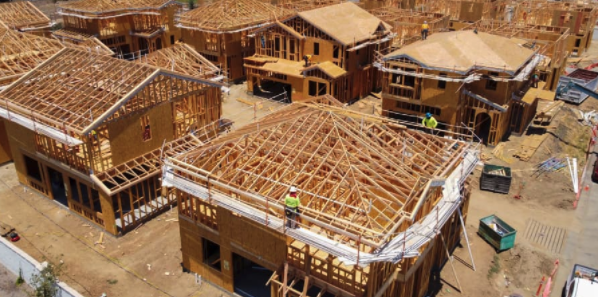
America is Short More Than 5 Million Homes, and Builders Can’t Make up the Difference
Anyone searching for a home today knows full well the pickings are slim. The supply of U.S. homes for sale is near a record low, and the gap between supply and demand is widening. The U.S. is short 5.24 million homes, an increase of 1.4 million from the 2019 gap of 3.84 million, according to new research from Realtor.com. The U.S. Census found that 12.3 million American households were formed from January 2012 to June 2021, but just 7 million new single-family homes were built during that time. September 17, 2021
Source - read more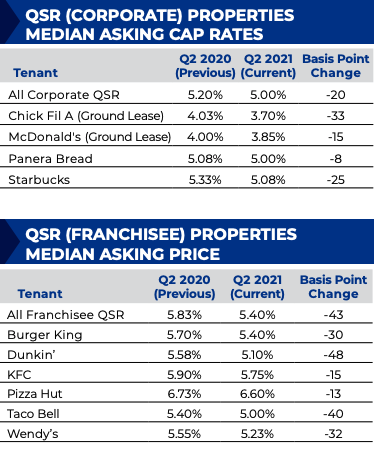
Cap rates in quick-service franchise sector go low
Cap rates in the net lease quick-service sector reached a historic low of 5.26% during the second quarter, down 39 basis points from last year, according to the Q2 2021 Net Lease QSR Market Report released Sept. 1 by The Boulder Group. Cap rates for corporate-leased QSR properties dropped 20 basis points to 5%, while properties leased to franchisees dropped 43 basis points to 5.4%. Sept 8, 2021
Source - read more
DC Hotel Revenue is down 87%
2021 is proving to be an even worse year for hotels than 2020. The hotel industry is poised to see a decrease of more than $59 billion nationally in 2021, due to the lack of business travel revenue, according to a new report by the American Hotel & Lodging Association and Kalibri Labs. This follows a year that saw losses of approximately $49 billion. The Washington, D.C., region has been one of the markets impacted most, dropping a whopping 86.5 percent in business travel revenue since 2019, with total revenue of just $371.2 million compared to $2.7 billion pre-pandemic. Sept 17, 2021
Source - read more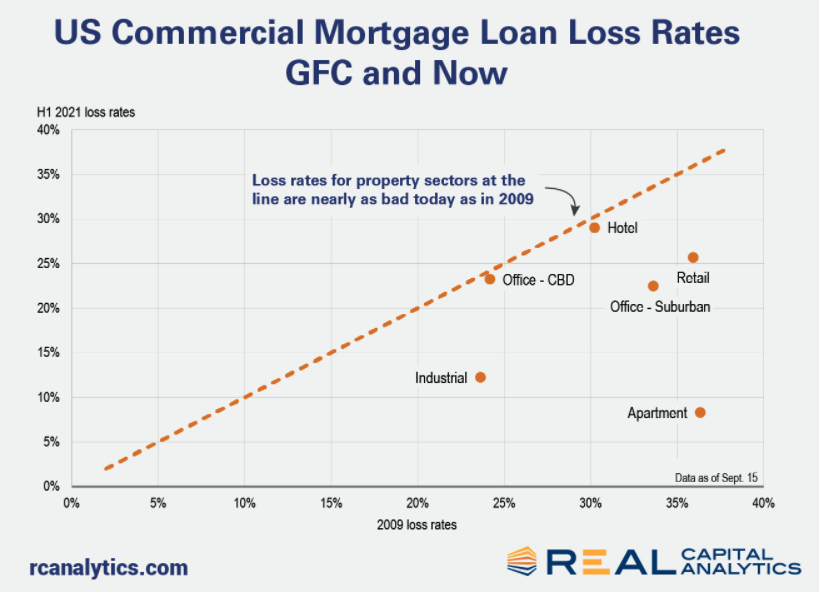
US Commercial Mortgage Loan Losss in the Covid Crisis
A year and a half into the Covid-19 pandemic and loss rates for U.S. commercial real estate loans are not looking that bad. With the exception of the hotel and CBD office sectors, loss rates so far are well below the pace set through this stage of the Global Financial Crisis. The macroeconomic factors driving loan performance were simply different in this downturn. September 16, 2021
Source - read more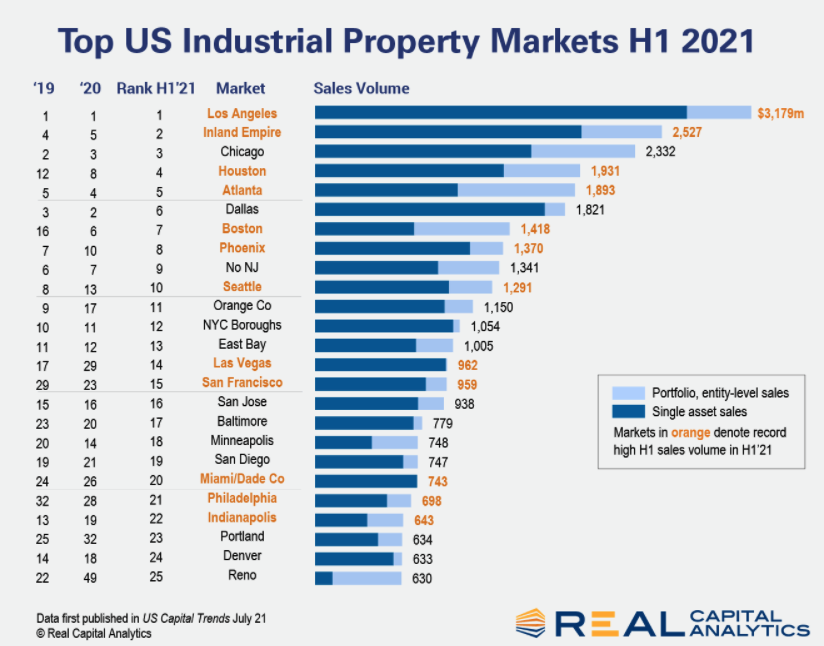
Top US Industrial Property Market of 2021 So Far
The U.S. industrial sector is booming. The market has shaken off the challenges of the Covid-19 pandemic and even benefited from some of the changes wrought by the crisis. In the chart below we show the top markets for industrial commercial property sales in H1 2021. Of the top 25 markets, 12 achieved a record high level of transaction activity for the first six months of a year, as highlighted in orange. August 10, 2021
Source - read more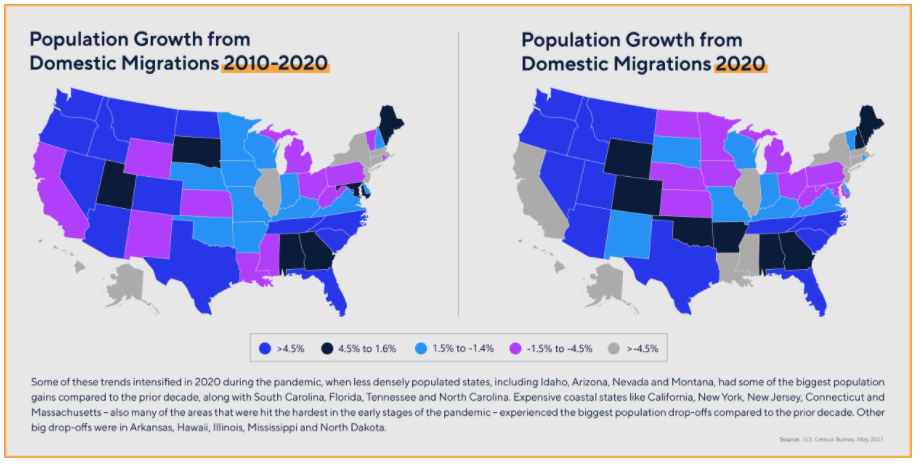
Even During a Pandemic, Demographics is Destiny
Despite widespread assumptions to the contrary, the pandemic did not start an urban exodus. That net outflow has been happening for a long time, but the pandemic accelerated the trends. In most cases, people have been moving fairly short distances – from cities to nearby suburbs – and a high a percentage of the moves have been temporary, often to existing vacation residences or temporary rentals in the exurbs of the large urban areas. And as a high degree of city dwellers are vaccinated, this transient exodus is already reversing. The trend of people moving from cities to suburbs dates to immediately after World War II. Americans were looking for space and affordability; both had become difficult to find in city centers, along with job growth and lower taxes. From about 2000 to 2006 or 2007, however, the net outflow slowed. This was not a “rebirth of the cities.” It was merely the slowdown of the longtime trend as the attractiveness of cities increased amid falling crime and increased appreciation for the sorts of amenities in which cities excel. Aug, 2021
Source - read more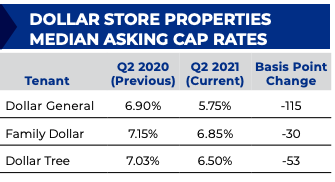
Dollar Store Report - Cap Rates at historic lows The Boulder Group reports
Cap rates within the single tenant net lease dollar store sector compressed to a new historic low for Dollar General (5.75%) and Dollar Tree (6.50%) properties in the second quarter of 2021. Cap rates for all three of the major dollar store brands (Dollar General, Family Dollar and Dollar Tree) compressed during the second quarter to an aggregate level of 6.11%. This represented an 87 basis point decline in cap rates year over year for the dollar store sector. August 4, 2021
Source - read more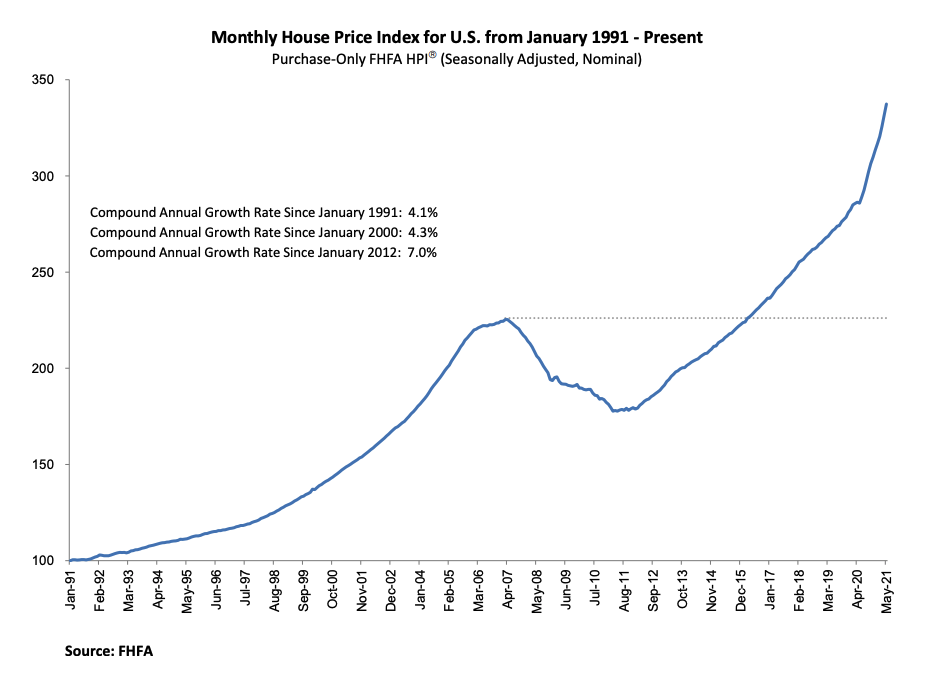
US Housing Prices up 1.7% in July
House prices rose nationwide in May, up 1.7 percent from the previous month, according to the latest Federal Housing Finance Agency House Price Index (FHFA HPI®). House prices rose 18.0 percent from May 2020 to May 2021. The previously reported 1.8 percent price change for April 2021 was unrevised. For the nine census divisions, seasonally adjusted monthly house price changes from April 2021 to May 2021 ranged from +1.0 percent in the Middle Atlantic division to +2.4 percent in the Pacific division. The 12-month changes ranged from +15.4 percent in the West South Central division to +23.2 percent in the Mountain division. July 27, 2021
Source - read more
Is a housing market crash on the way is 2021? 4 factors to consider
With the real estate market experiencing surging prices, scant inventories, and a backlog of new home construction, many consumers are wondering if what’s gone up must come back down — in other words, are we headed for another housing market crash? Let’s take a closer look. Aug 18, 2021
Source - read more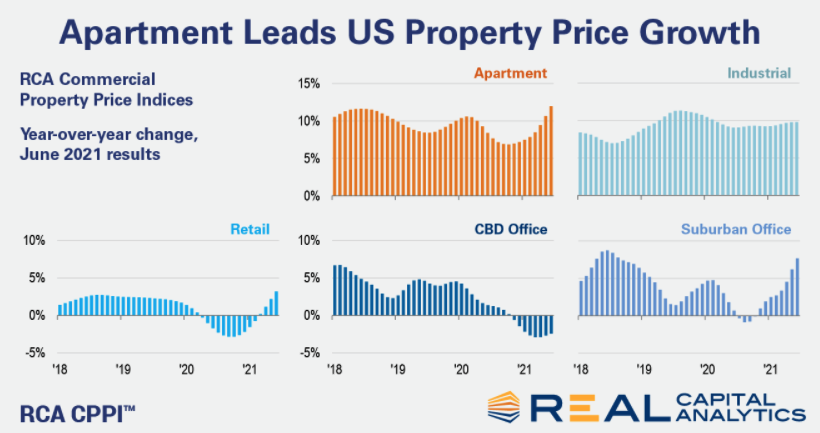
US Price Growth Moves Higher in June, Led by Apartments
The headline gauge of U.S. commercial property price growth shifted higher in June, led by the apartment sector. The US National All-Property Index grew 9.8% from a year ago, the fastest annual growth rate since 2015, and 0.8% from May. Apartment sector price growth, which had dipped as low as 6.9% during 2020, accelerated to 12.0%. Deal activity in this sector has gone beyond the recovery phase and in Q2 2021 was at a record high level for any second quarter period, as shown in the latest edition of US Capital Trends, also released this week. July 22, 2021
Source - read more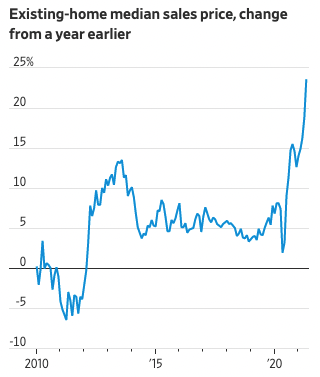
US Existing Home Prices Hit Record High in May
The WSJ reports that U.S. home prices in May experienced their biggest annual increase in more than two decades, as a shortage of properties and low borrowing rates fueled demand. The median existing-home sales price in May topped $350,000 for the first time, the National Association of Realtors said Tuesday. The figure was nearly 24% higher than a year ago, the biggest year-over-year price increase NAR has recorded in data going back to 1999. Sales prices have been climbing sharply since last summer, when lockdowns related to the Covid-19 pandemic eased across the country and many people rushed to find more space and bigger homes. Others working remotely seized on the chance to move to a less expensive city. June 22, 2021
Source - read more
Top and Botton Metros in Q1 2021
Key metro areas in the U.S. are rebounding quickly from the COVID-19 pandemic, although some market shifts from the last year persist, according to SitusAMC Insights Top 5 Bottom 5 Metro ranking for Q1 2021. This proprietary quantitative and qualitative analysis ranks the top investment opportunities for each of the major property types from a relative value vs. price perspective, using the weighted average of NPI-NCREIF total returns across commercial real estate sectors (apartment, industrial, retail, office). Rebounding tourism and business travel in Q1 helped the Miami metro area bounce out of its previous spot in the Bottom 5, replaced by New York City, which faces challenges in its office and multifamily sectors. Explore all of the winners and losers in our slideshow below. To learn more about SitusAMC’s research and data offerings, contact Peter Muoio, PhD, Senior Director of SitusAMC Insights at petermuoio@situsamc.com. June 16, 2021
Source - read more
As lumber prices fall, the threat of inflation loses its bite
From sawmills to store shelves to your own hammer swings, lumber can tell you a lot about what is going on in the economy right now. Lumber prices soared over the last year, frustrating would-be pandemic do-it-yourselfers, jacking up the costs of new homes and serving as a compelling talking point in the debate over whether government stimulus efforts risked the return of 1970s-style inflation. The housing-and-renovation boom drove insatiable demand for lumber, even as the pandemic idled mills that had already been slowed by an anemic construction sector since the 2008 financial crisis. Lumber futures surged to unprecedented heights, peaking at more than $1,600 per thousand board feet in early May. But since then, the prices of those same plywood sheets and pressure-treated planks have tumbled as mills restarted or ramped up production and some customers put off their purchases until prices came down. June 21, 2021
Source - read more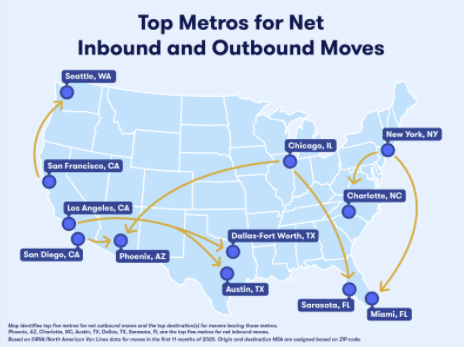
Phoenix, Charlotte and Austin top highest net move-ins
The pandemic has upended the meaning of home, and prompted many of us to rethink how and where we want to live. A new Zillow survey of inbound moves and outbound moves finds more than 1 in 10 Americans (11%) say they have already moved in the past year — by choice or by circumstance — contributing to the Great Reshuffling, and millions of additional households could enter the real estate market as a result of the pandemic. June 16, 2021
Source - read more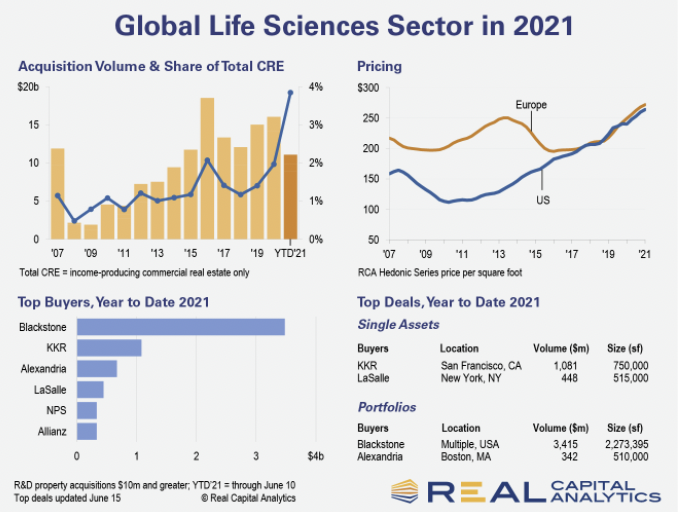
"You can't do chemistry from home"
Investor interest in the life sciences sector has exploded. While the shadow of remote working has undermined office property demand, R&D-type properties have proved immune. As one commentator put it: you can’t do chemistry from home. Just over $11 billion has been spent on R&D properties globally so far in 2021, compared with $16 billion in the whole of 2020, which was the second strongest year on record. (RCA records life sciences properties under the R&D feature of buildings). The surge is reflected in client questions to the Real Capital Analytics team of analysts: the group has fielded more data queries so far this year than in all of 2020. June 14, 2021
Source - read more
Cap Rates Facing Downward Pressure for many types of CRE
Cap rates are facing significant downward pressure for many types of commercial real estate from apartments to self-storage facilities to hotels and industrial properties, says Marcus & Millichap SVP and director of Research Services John Chang in the latest installment of his video briefings. Speaking to apartments, Chang says part of the buzz of large investors at the recent National Multifamily Housing Council strategy conference was that cap rates for larger properties 100 units and up have been pushed down to the 5% range in smaller markets. June 16, 2021
Source - read more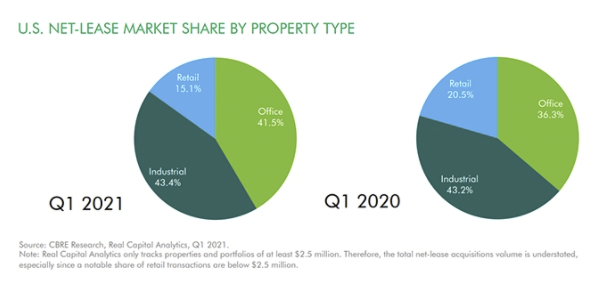
Net-Lease Investment Approaches Pre-Pandemic Level
Investment in U.S. net-lease properties approached pre-pandemic levels in the first quarter, reported CBRE, Dallas. The firm’s U.S. Net-Lease Investment Report said “robust” institutional acquisition activity, increased interest in office assets as return-to-the-workplace plans gain momentum and resilient foreign investment currently drive the sector. Net-lease investment activity comprising office, industrial and retail properties increased 10 percent from the pre-pandemic first-quarter 2019, the report said. June 8, 2021
Source - read more
Student Housing Outpreforming Other Asset Classes Post-COVID
Call it another benefit of education. Dedicated off-campus student housing is exiting the pandemic as a potentially more profitable, long-term commercial real estate asset than malls, hotels and offices. Part of that is what the pandemic did to those other assets. Malls were already struggling with e-commerce when the pandemic slashed foot traffic to near zero and kept it there for months; hotels shuttered by the thousands amid plunges in tourism and business travel; and companies kept their employees out of the office for months. Still, even with a post-COVID reopening for offices and malls — and a travel bounce for hotels — student housing appears to be a more sure bet for commercial real estate investors. Net operating income in student housing is expected to grow nearly 2 percent after 2025 — or about the same as profitability in self-storage and senior housing — according to commercial real estate intelligence firm Green Street. For office, lodging and malls, the profitability growth projections are all 1.3 percent or less. June 8, 2021
Source - read more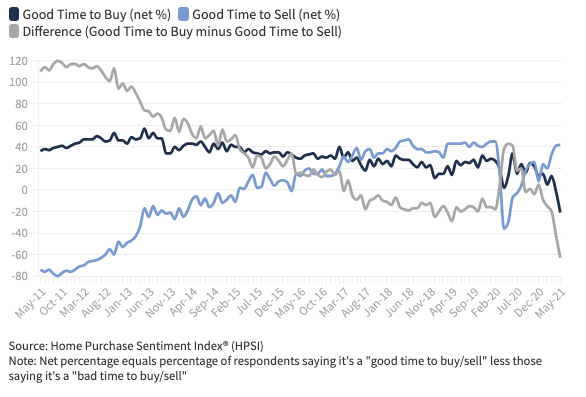
Consumer Perception of Homebuying Conditions Worsens as Affordability and Supply Issues Persist
Only 35 Percent of Consumers Believe It’s a Good Time to Buy a Home, Despite Improved Sense of Household Finances. WASHINGTON, DC – The Fannie Mae (FNMA/OTCQB) Home Purchase Sentiment Index® (HPSI) remained relatively flat in May, increasing by 1.0 points to 80.0. Four of the HPSI’s six components increased month over month, most notably the components related to personal finance, as consumers reported a much greater sense of job security and improved household income compared to the same time last year. However, for the second consecutive month, consumers also reported a significantly more pessimistic view of homebuying conditions; on net, that component fell to an all-time survey low, with only 35% of respondents believing it’s a good time to buy a home, down from 53% in March. Year over year, the HPSI is up 12.5 points. June 7, 2021
Source - read more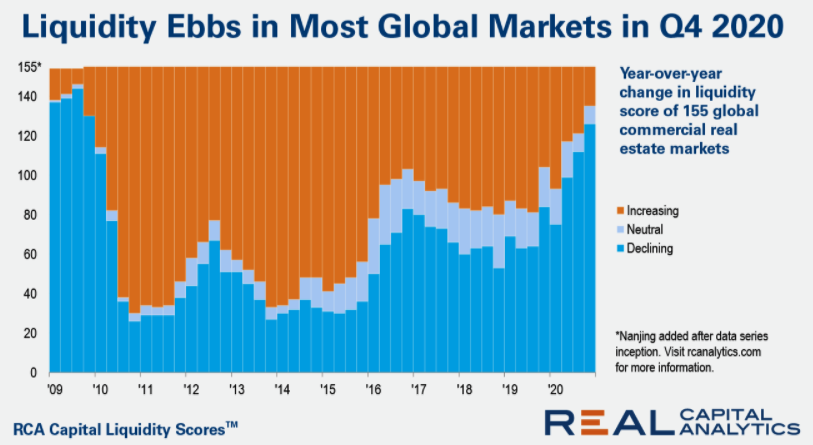
Global Liquidity Shrinks but Some Positive Signs in Q4 2020
Commercial property market liquidity at the end of 2020 was below the levels from a year prior in 126 out of 155 markets worldwide, the latest update of the RCA Capital Liquidity Scores shows. The count of markets with scores falling on an annual basis was the highest since the end of 2009, during the Global Financial Crisis. However, there are signs of optimism. Firstly, in 35 of the global markets tracked the scores improved from the third into the final quarter of the year. Secondly, while liquidity has shrunk in 2020, levels are still well above those seen during the GFC. This relative resilience is reflected it the pricing for commercial assets, which appreciated across the majority of global metros in 2020. March 4, 2021
Source - read more
FHFA Extends Foreclosure and REO Eviction Moratoriums and COVID Forbearance Period
Today, the Federal Housing Finance Agency (FHFA) announced that Fannie Mae and Freddie Mac (the Enterprises) are extending the moratoriums on single-family foreclosures and real estate owned (REO) evictions until March 31, 2021. The foreclosure moratorium applies to Enterprise-backed, single-family mortgages only. The REO eviction moratorium applies to properties that have been acquired by an Enterprise through foreclosure or deed-in-lieu of foreclosure transactions. The current moratoriums were set to expire on February 28, 2021. FHFA also announced that borrowers with a mortgage backed by Fannie Mae or Freddie Mac may be eligible for an additional forbearance extension of up to three months. Eligibility for the extension is limited to borrowers who are on a COVID-19 forbearance plan as of February 28, 2021, and other limits may apply. Further, COVID-19 Payment Deferral for borrowers with an Enterprise-backed mortgage can now cover up to 15 months of missed payments. COVID-19 Payment Deferral allows those borrowers to repay their missed payments at the time the home is sold, refinanced, or at mortgage maturity. February 9, 2021
Source - read more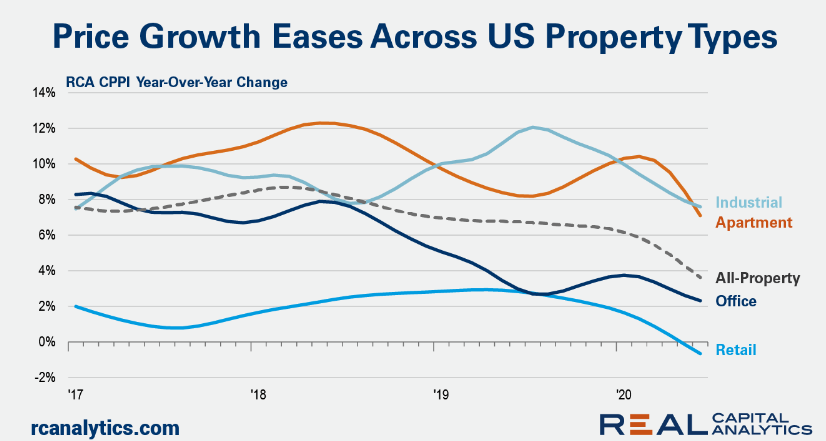
US CRE Price Growth Accelerates in January
The pace of U.S. commercial property price growth accelerated in January, climbing back near the growth rates seen before Covid-19 struck, the latest RCA CPPI: US summary report shows. The US National All-Property Index rose 6.9% from a year ago and 1.2% from December. The acceleration in price growth comes even as deal volume slumped again in January following December’s record haul, as shown in US Capital Trends, also released this week. Office prices rebounded into the new year, up 3.3% from January 2020. As recently as August this index was posting no annual growth. Suburban offices drove the increase in January. February 25, 2021
Source - read more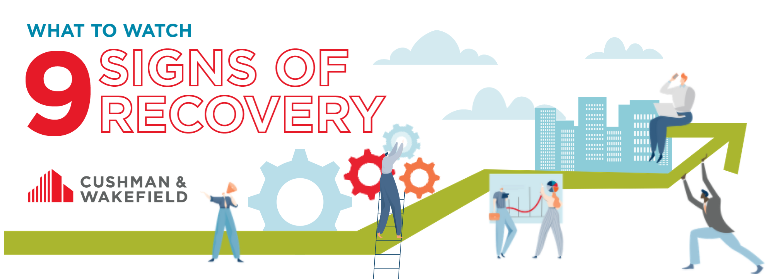
What to Watch in 2021: 9 signs of Recovery in RE
After months of an unrelenting global health crisis, ongoing uncertainty, economic damage and disruptions across nearly all facets of life, the reality of an effective vaccine—and the prospect of widespread vaccinations—has sparked hopes for 2021 and speculation about recovery. While pinpointing the timing of local recoveries may not be possible, Cushman & Wakefield Research has identified nine signs to watch—signals that could indicate the CRE market and the economy in cities across the globe are transitioning to a recovery phase. January 8, 2021
Source - read more
Top 5 Self-storage Investment Markets in 2020
Multi-Housing News (MHN), a media brand specializing in residential real estate news and analysis, has published a list of the top five U.S. self-storage markets based on investment volume in 2020. The list was compiled using data from Yardi Matrix, the self-storage data-services platform offered by management-software provider Yardi Systems Inc. The recognized markets, in order of rank, were New York City (NYC); Atlanta; Tampa, Fla.; San Diego and Phoenix. Together, those metropolitan areas accounted for more than 25 percent of total activity. More than $3.6 billion in self-storage transactions closed nationwide during the year, which is a slight decline from the nearly $4 billion in deals logged in 2019. Though overall investment activity was down year over year, some markets experienced pent-up demand as a result of the coronavirus pandemic and drew increased interest from investors, MHN reported. March 3, 2021
Source - read more
US retail sales in 2021 to rise 6.5% to 8.2% amid vaccine rollout, says NFR
Retail sales in the U.S. this year are expected to total more than $4.33 trillion as more individuals receive the COVID vaccine and the economy reopens. That’s according to the National Retail Federation’s just-released annual forecast, which estimates that 2021 retail sales will grow between 6.5% to 8.2% over last, totaling between $4.33 trillion and $4.4 trillion. Online sales, which are included in the total, are expected to grow between 18% and 23%, to between $1.14 trillion and $1.19 trillion. February 24, 2021
Source - read more
The looming danger facing affordable housing
The economic hardships wrought by the coronavirus pandemic will be long-term, and millions of renters and homeowners alike could take a serious hit in the upcoming months, affordable housing experts said on a recent webinar hosted by Freddie Mac. Despite economists’ more optimistic housing predictions for the year ahead, one panelist felt that the worst may still be yet to come. “We’re going to be starting off 2021 in a very difficult place when it comes to a potential wave of evictions as well as a current growing forbearance pipeline and delinquencies,” said Alanna McCargo, Vice President of Housing Finance at the Urban Institute. “Both of those dynamics are going to be sort of the things that are front and center. December 18, 2020
Source - read more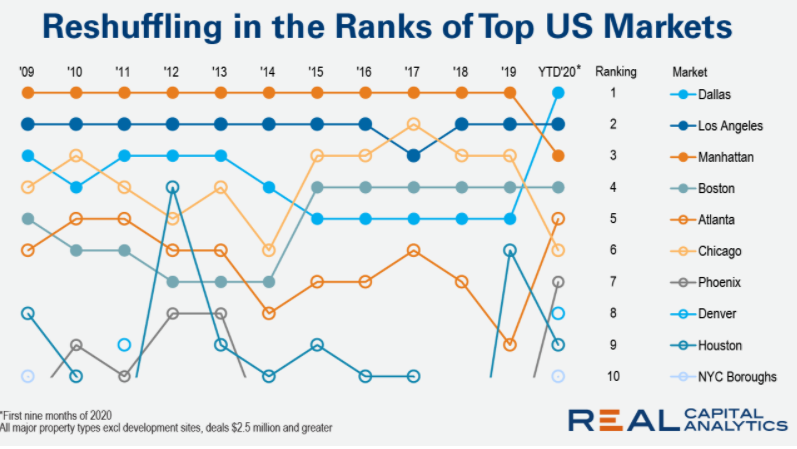
Top 10 Most Active US Markets Since 2009
Dallas sits atop U.S. leader board for commercial property deal volume in the first nine months of 2020. Normally Manhattan would occupy the #1 position. Los Angeles has sometimes taken the top spot for shorter periods during times of market disruption in Manhattan, but Dallas has never topped the rankings for an extended period until 2020. Granted, deal activity for the year to date across all the top U.S. markets has fallen amidst the Covid-19 tumult. Dallas simply fell less than the other heavyweight markets. November 23, 2020
Source - read more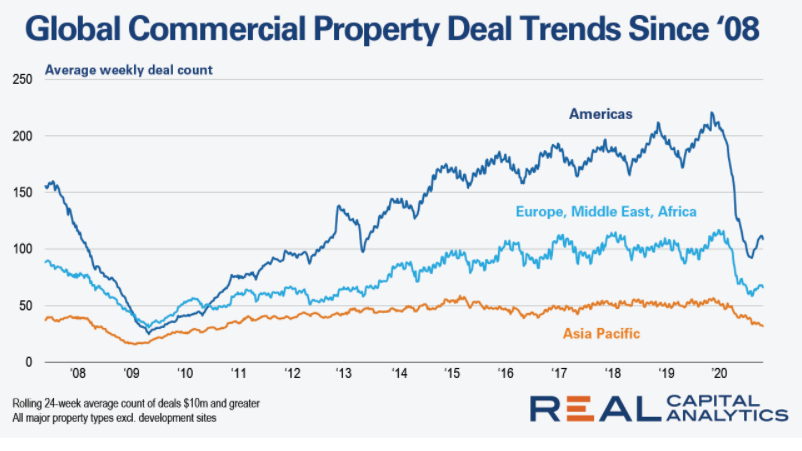
US Commercial Real Estate Sales Tumble Again in Q3
In July, after the first full quarter when we saw the global impact of the Covid-19 maelstrom, we studied the drop in global commercial real estate activity with a historical perspective going back to the Global Financial Crisis (GFC). Today, the chart plotting the average weekly deal count for the three global zones reveals more about the decline caused by an extraordinary crisis. For the Americas, the fall in average deal flow maintained its pace until a low point of 92 deals per week in late September, some six months after the first sweeping lockdown measures in the U.S. This was a level nearly 60% lower than the highest deal count figure at the close of January. December 21, 2020
Source - read more
ULI Forecast Sees Potential Rebound in 2021-2022
The Urban Land Institute, Washington, D.C., said a consensus of real estate economists surveyed expect a short-lived recession and above-average GDP growth in 2021 and 2022. The ULI semi-annual Real Estate Economic Forecast survey of 43 economists and analysts at 37 real estate organizations said the recovery will likely start next year and be even more positive in 2022, though growth will likely vary by sector. Real estate market conditions and values should hold up much better than was expected six months ago, with industrial real estate and single-family housing expected to perform best. November 11, 2020
Source - read more
Moody’s Analytics Forecasts Resilient Outlook for US Industrial Property Rents
Moody’s Analytics today announced new forecasts for commercial real estate (CRE) rents and vacancies, covering eight property types and more than 3,000 submarkets across the United States. The forecasts reflect the latest Q3 data on US CRE markets collected and curated by the Moody's Analytics CRE Solutions group. Throughout 2020, industrial properties such as warehouses used for storage and distribution of goods have likely benefited from an acceleration of e-commerce sales, even as brick-and-mortar retail floundered amid the coronavirus pandemic. The sector will likely not remain unscathed over the next year as a surge in COVID-19 cases forces further shutdowns and a fall in international trade volumes weighs on the manufacturing industry. Industrial property vacancy rates are expected to rise to 11.8% in 2021, and the sector is predicted to incur its biggest drop in effective rents in 10 years, down 4.5% in 2021. November 11, 2020
Source - read more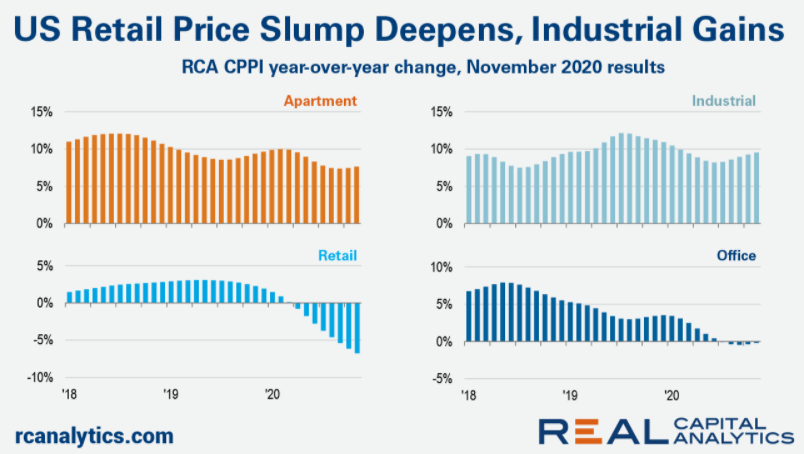
Industrial, Apartment Drive US Price Gains; Retail Sinks
The U.S. national rate of commercial property price growth rose in November at the fastest annual clip since the beginning of the pandemic on the back of continued strong industrial and apartment price gains. The US National All-Property Index increased 5.7% from a year ago, the latest RCA CPPI: US summary report shows. In the retail sector meanwhile, the slump in prices deepened. Industrial prices nearly broke back into a double-digit year-over-year growth range, climbing 9.5% in November. Although deal volume has fallen in the logistics sector this year, there is still an appetite for these properties and that demand has driven price growth in the sector. December 17, 2020
Source - read more
Wells Fargo Securities: Pandemic Could Accelerate Retail Sector Trends
The economy has improved from a few months ago, “[but] the same cannot be said of the retail sector,” said Wells Fargo Securities, Charlotte, N.C. Vacancy rates rose to 4.8 percent in the second quarter, the highest since 2016. Similarly, asking rents registered their first contraction since 2013, falling 0.3 percent over the quarter. “Retail’s struggles have continued into the fall, even as broader economic activity has improved, and leasing activity is still running at about half of its pre-pandemic pace,” Wells Fargo Securities said in a new report, Retail After the Pandemic. “Furthermore, occupancy limits and the reluctance of consumers to spend a meaningful amount of time shopping inside physical stores have pushed a growing list of retailers into bankruptcy.” October 13, 2020
Source - read more
Powell: Economic Outlook Remains Uncertain, Depends on Controlling Spread of Coronavirus
The U.S. economic outlook remains highly uncertain and depends on controlling the spread of the coronavirus pandemic, Federal Reserve Chairman Jerome Powell said today during the National Association for Business Economics virtual annual meeting. While the recovery “has progressed more quickly than generally expected,” there is a risk that any initial gains from reopening may transition to “a longer than expected slog back to full recovery as some segments struggle with the pandemic’s continued fallout,” Powell said. October 6, 2020
Source - read more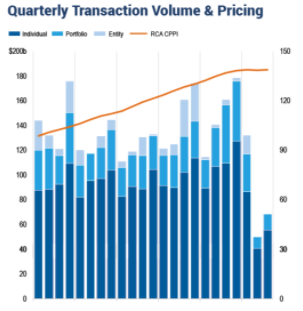
US Commercial Real Estate Sales Tumble Again in Q3
U.S. commercial real estate activity tumbled again in the third quarter of 2020 compared to deal levels of a year ago, though there were glimmers of improvement in recent trends, according to the latest edition of US Capital Trends. The dollar volume of properties changing hands in Q3 2020 dropped 57% from a year prior, but rose 37% on Q2 2020 levels, a bigger increase than seasonal activity patterns would normally present. The apartment sector was the largest component of U.S. commercial real estate in the quarter, even with sales down 51% from a year earlier. October 21, 2020
Source - read more
Hospitality, retail real estate show ‘atrocious’ value loss in appraisals
More than six months into the coronavirus pandemic, assessing damage in the commercial real estate market is now more feasible in a broader economic context. And it’s not pretty, according to recent appraisals of commercial mortgage-backed securities. With a surge in defaults on payments and special servicing of commercial loans, appraisals on the value of these properties are coming down sharply. Wells Fargo conducted an analysis of 116 properties that have been sent to special servicing since April 1, Financial Times reported this week. More than half the properties were assessed in the last month. Among those assessed, 101 were in hospitality or retail. The appraisals on these properties have averaged about a 27% drop in value from when the loans were originated. That’s massive and concerning for both sectors. October 1, 2020
Source - read more
CMBS Delinquencies Continue to Drop: Trepp
The Trepp CMBS delinquency rate declined to 8.92 percent in September, marking the third month in a row that the rate fell. The September decline was welcome but modest, at only 10 basis points from the August figure, while the overall national CMBS delinquency rate rose 641 basis points year-over-year. Further, Trepp cautioned that “with relief windows ending for some loans, an uptick in delinquencies in the future is possible.” Other indicators in the October report trended a little less favorably. Loans with a special servicer were up 44 basis points to 10.48 percent. Loans on the servicers’ watchlist were up from 19.9 percent in August to 20.7 percent in September. But loans considered seriously delinquent (60 or more days delinquent, in foreclosure, REO or nonperforming balloons) decreased by 29 basis points from August to September. The context—and contrast —for Trepp’s relatively good news was that the delinquency rate had jumped in May and June, to a near record. The all-time high of 10.34 percent was registered in July 2012. The remarkable pandemic-related increase caused Trepp to ponder, in a report at the time, whether the rate might have reached “terminal delinquency velocity.” October 5, 2020
Source - read more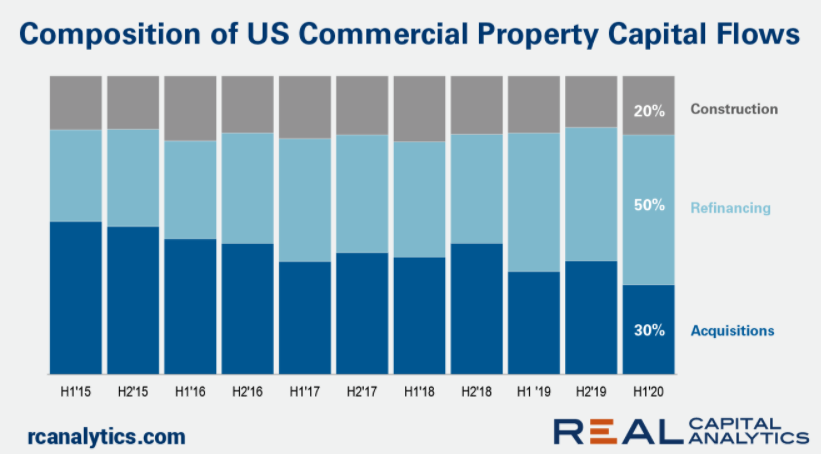
Refinancing Pulls in Greater Share of US Capital Flows in H1
U.S. commercial real estate deal volume has fallen sharply in 2020 but there is still capital flowing into the sector, which supports asset pricing. More capital flowed to refinancing activity than into new acquisitions in the first half of 2020, the latest edition of US Capital Trends shows. Refinancing accounted for 50% of all capital flows to commercial property, well above the 30% share represented by new acquisitions. The inability to refinance cash-flowing properties was a critical problem during the 2008-09 downturn. In this Covid-19 recession, however, the ability to refinance rather than sell has led to sticky prices. Construction activity has been a constant at around 20% of all capital flows in recent periods. Multifamily construction has been the leader for construction in this business cycle. However, except for pockets of supply in a few coastal markets, the industry is not overbuilding today. October 7, 2020
Source - read more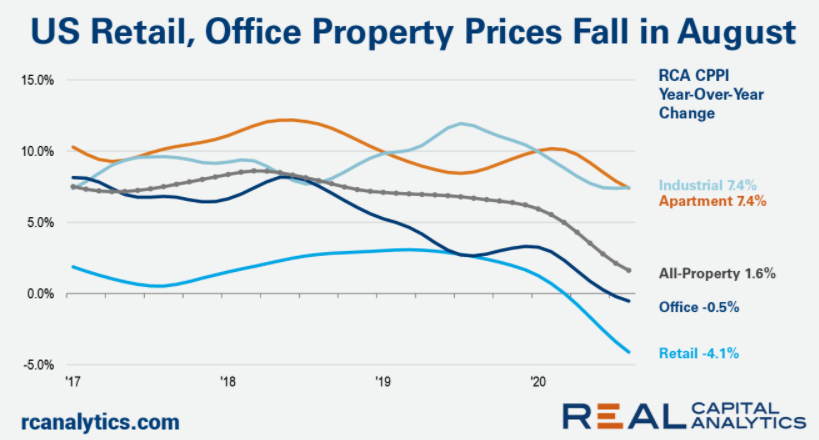
US National Prices Creep Higher in August
U.S. commercial property prices posted a 1.6% year-over-year gain in August as declines in retail and office pricing weighed against continued growth in industrial and apartment prices, the latest RCA CPPI summary report shows. The US National All-Property Index was rising at close to a 6% rate at the start of 2020, before the Covid-19 crisis hit the economy. Retail prices sank in August, posting a 4.1% year-over-year drop. Prices for the beleaguered sector started declining in April and have accelerated each month since then. Overall office prices were dragged down by a 1.4% annual decline in suburban office prices. September 24, 2020
Source - read more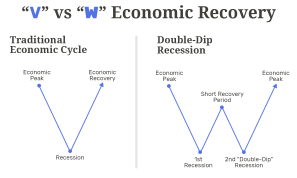
80% of economist see a chance of a double-dip recession
Almost 80% of economists say there’s at least a one-in-four chance of a double-dip recession, following a record 32.9% plunge in GDP in the second quarter, according to a survey released on Monday from the National Association for Business Economics. About 40% of respondents rate the COVID-19 response from Congress as “insufficient” and 37% said it’s “adequate,” according to the survey that summarized the opinions of 235 members and was conducted between late July and early August. “The panel is split in its view on Congress’s fiscal response to the recession,” said NABE President Constance Hunter, who is KPMG’s chief economist. “Nearly three out of four panelists believe the optimal size for the next fiscal package to be $1 trillion or greater, compared to 17% who favor a smaller package.” August 24, 2020
Source - read more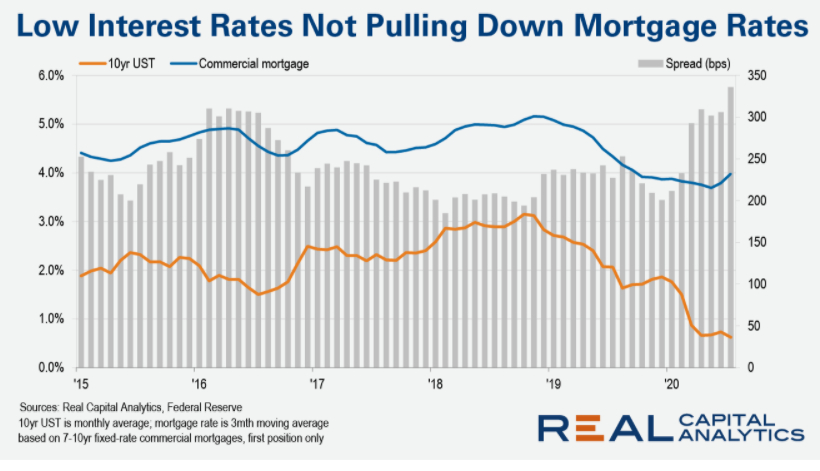
Low Interest Rates Not Enough to Kindle CRE Sales Activity
The 10yr US Treasury has averaged less than 1% every month since March 2020. Commercial mortgage rates have barely budged despite this sustained low level for the interest rate environment. In any normal period, low interest rates would be a positive sign for commercial real estate investment. Interest rates remaining at such a low level over a sustained period is a sign of weakness in the economy. Investors normally benefit from declines in both cap rates and mortgage rates in periods of falling interest rates. The US Capital Trends report, released today by Real Capital Analytics, shows that these low rates have not inspired new acquisitions, with national sales activity down 68% year-over-year in August and down 36% for the year to date. September 23, 2020
Source - read more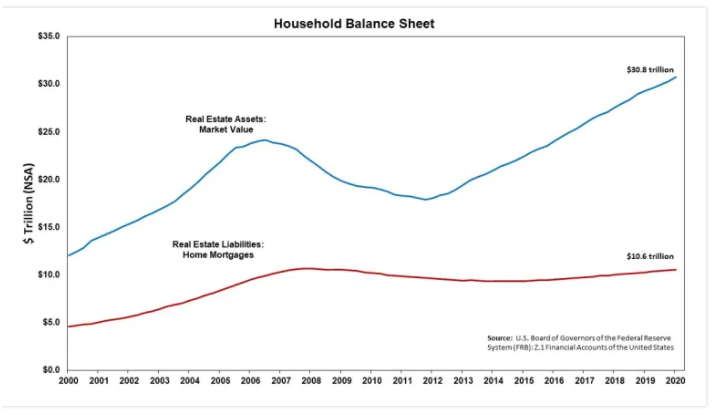
Home Values, Owner's Equity Rise in 2Q20
As the novel coronavirus took hold in the second quarter, households’ market values continued to rise, per second quarter 2020 Federal Reserve Flow of Funds report. In the second quarter, the aggregate value of all household mortgages rose by $80 billion to $10.6 trillion, while the aggregate value of the households’ market values, i.e., that of all owner-occupied real estate including vacant land and mobile homes, increased by $450 billion to $30.8 trillion. The result was an increase in net equity by $370 billion to $20.2 trillion. In the previous quarter, net equity stood at $19.8 trillion. A recent study by the Federal Reserve showed that among the various categories of expenditures spent from “equity extraction”, the highest included home improvements and home maintenance. Such residential investment bodes well for future values of the homes. September 21, 2020
Source - read more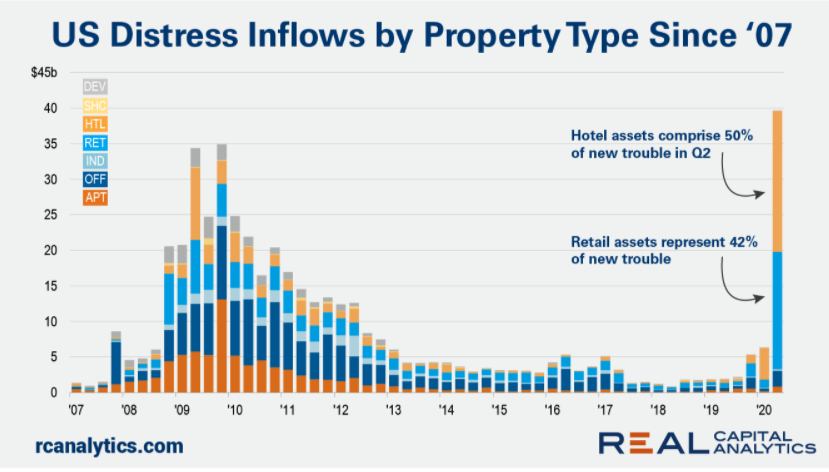
Retail, Hotel Assets Dominate US Distress Inflows
The latest US Capital Trends report from Real Capital Analytics focused on U.S. lending activity in the first half of 2020 and distress flows in the market. In the current downturn, we have seen aggregate distress across all property types grow at a pace much faster than that seen during the Global Financial Crisis (GFC). Just two commercial property sectors, however, are behind the bulk of new distress. RCA tracks all stages of distress, from the first signs of potential trouble through to resolution. We will classify a property as troubled when we have direct knowledge of property-level distress. Announcements of bankruptcy or default, tenant distress, or CMBS loans transferred to a special servicer are just a few examples of events that can trigger this troubled status. The chart below shows the levels of new distress. Given news headlines, it’s to be expected that retail and hotel properties would represent a large share of newly troubled assets since the start of this Covid-19 recession. The magnitude of their shares may be more surprising. Retail and hotel assets combined represented 92% of new trouble in the second quarter of 2020. In the depths of the GFC, these two sectors were behind only about half the total distress. September 29, 2020
Source - read more
'Perfect Storm' Hits Housing Market
It appears that the month of September and homebuying no longer go hand in hand. That is, based on intel from a new realtor.com report. Under most circumstances, due to the typical availability of more homes, tamped down competition and an ease in prices, September’s the optimal time of year to invest in a home. Well, this time, the brakes have been slammed on that pattern, according to realtor.com's September Monthly Housing Trends Report. Turns out an atypically competitive fall homebuying season--in which the usual buyers are plucking down about $20,000 more for a home and face 25% more competition than at the start of the year--has stoked a buying spree induced by COVID-19. The best time to buy a home was the week of Sept. 22-28 last year. It that pattern was holding this year, it would have been Sept. 20-26, when the housing market typically encountered a pull back. However, listings slid 21% this year contrasted to the beginning of the year. There commonly are 17% more homes available in September than in the dawn of the year. October 1, 2020
Source - read more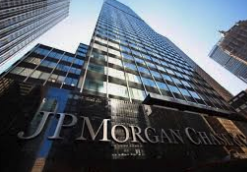
Banks Prepared for Wave of Loan Defaults
The largest U.S. banks signaled that the worst of the coronavirus recession is yet to come, opting to stow away tens of billions of dollars to prepare for an expected wave of loan losses. JPMorgan Chase & Co., Citigroup Inc. and Wells Fargo & Co. said Tuesday they took large hits to their second-quarter profits to collectively stockpile $28 billion to cover losses as consumers and businesses start to default on their loans. The provisions amount to a sharp increase above what they put away in the first three months of the year, reflecting a shift in their assumptions about the length and severity of the pandemic's economic toll. JPMorgan, the largest U.S. bank by assets, said it put aside extra to prepare for an unemployment rate that remains at double digits well into next year and a slower recovery in gross domestic product than the bank's economists assumed three months ago. "This is not a normal recession," said James Dimon, JPMorgan's chief executive. "The recessionary part of this you're going to see down the road." July 15, 2020
Source - read more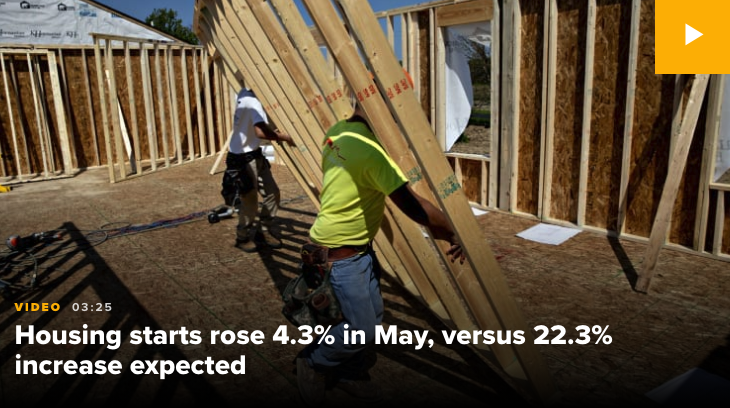
Real estate CEO expects ‘exodus’ of central business districts to last the next two years
The coronavirus pandemic is pushing businesses and dwellers out of city centers and downtowns into the outskirts in the short term, but demand can be expected to return to big cities, according to the head of the largest commercial real estate broker in the country. Hessam Nadji, president and CEO of Marcus & Millichap, on Tuesday told CNBC that it will be a test for suburban areas to accommodate exponential demand. Suburban areas outside of major cities are in high demand, as people migrate from dense urban areas in response to the Covid-19 outbreak. “I think the next 18 to 24 months are going to show a lot of exodus out of central business districts, as you can expect,” Nadji said in an interview on “The Exchange.” “We’re seeing there’s a lot of office vacancy, for example, in the suburbs that have now been absorbed; there’s a lot of demand for rental homes that we’re seeing because people are fleeing especially hot spots like New York, but ... you just have to keep a long-term view on it.” July 7, 2020
Source - read more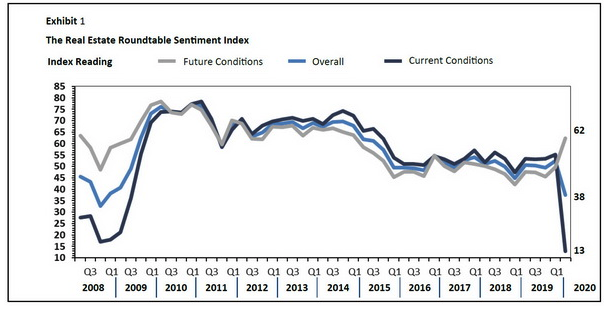
Q2 Economic Sentiment: Commercial Real Estate Execs Confirm COVID-19 Market Downturn
Commercial real estate executives confirmed a downturn in Q2 market conditions due to job losses and business shutdowns related to COVID-19, according to The Real Estate Roundtable’s 2020 Q2 Economic Sentiment Index released today. The report also shows there is an expectation for an improvement in market conditions by next year, dependent upon the return of jobs and the ability to safely reopen businesses. “The commercial real estate industry, like all industries, experienced in the second quarter a sudden onset of economic disruption due to business lockdowns and stay-at-home shutdown orders put in place to combat the pandemic,” said Real Estate Roundtable President and CEO Jeffrey DeBoer. “The economic damage to commercial real estate has been particularly harmful for the retail and lodging sectors of the industry. Although our Q2 survey results show there is hope for improved conditions within the next year, there are significant concerns that other sectors of the industry could be dragged down if jobs don’t rebound and government assistance tapers off. June 30, 2020
Source - read more
Warehouses Offer Crowded Shelter in Retail Storm
Warehouses are proving to be a safe haven in a commercial real-estate market battered by the coronavirus. While retail and mall landlords are facing a reckoning as stores go out of business, owners of sites focused on distribution are on a steady path thanks to the broad changes that are sweeping the consumer sales world the WSJ’s Carol Ryan writes. Spending has moved online during widespread lockdowns aimed at containing the virus, and many experts say some of that shift will be permanent. UBS expects one-quarter of all U.S. retail spending to be online by 2025, a trend expected to force 100,000 physical stores to close by the middle of the decade and punish owners of retail properties. U.K. department-store landlord Intu just filed for the local equivalent of bankruptcy. Meanwhile, warehousing giant Prologis says it collected 95% of rent due globally in May. June 30, 2020
Source - read more
US Property Price Growth Decelearates in June
Commercial property price growth slowed in June across all U.S. property types, dragged down by the continued impact of the health and economic crisis. The US National All-Property Index was flat in June from May and gained just 3.6% year-over-year, the latest RCA CPPI summary report shows. Retail prices fared the worst of the sectors, dipping 0.3% from May and down 0.7% over the past year. This is the first annual decline in prices seen for the beleaguered sector since 2011. Retail sector distress ballooned in the second quarter of 2020, which will likely speed price discovery for this asset class. The office sector gained just 2.3% year-over-year and was flat on the month. CBD office was hit especially hard, with prices falling 0.8% from the first quarter and increasing just 0.8% from a year ago. Apartment price growth wound down to 7.1% year-over-year. Industrial prices eased to a 7.6% year-over-year increase. Activity in the U.S. commercial real estate market plunged 68% in the second quarter of the year, as shown in the new edition of US Capital Trends, also released this week. Industrial sector sales volume was half that of a year earlier, and the other major property types fared worse." July 23, 2020
Source - read more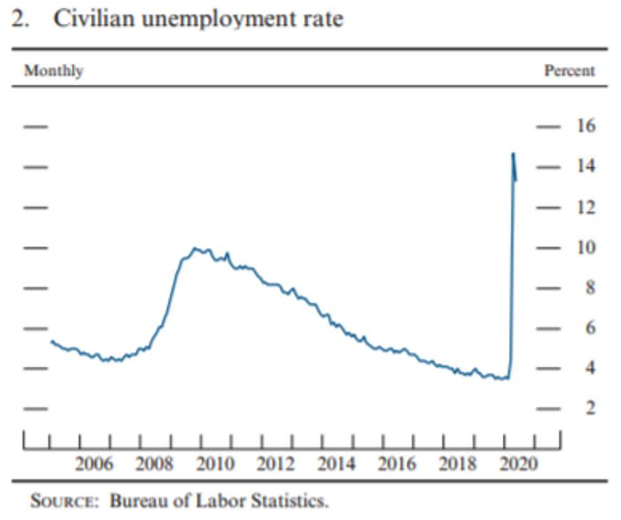
Top Federal Reserve Officials Are Starting To Brace For A Prolonged Recession
Policymakers at the Federal Reserve, after some initial optimism that the Covid-19 slump would be deep but confined to the second quarter of this year, now seem braced for a more prolonged recession marked by high unemployment and a rising risk of corporate bankruptcies. Top officials have launched what appears to be a coordinated shift in tune in public remarks over the last couple weeks, particularly as the prospect of a worsening second wave of infections that could deal yet another blow to an already fragile economy becomes reality. July 21, 2020
Source - read more
6% Economic Contraction then Recovery starting in the 3rd Quarter
16 chief economists from some of the largest U.S. Banks say that the U.S. economy will experience about a 6% contraction this year, but will begin to recover from a severe second-quarter downturn in the third quarter, according to the latest forecast of the American Bankers Association’s Economic Advisory Committee. May 29, 2020
Source - read more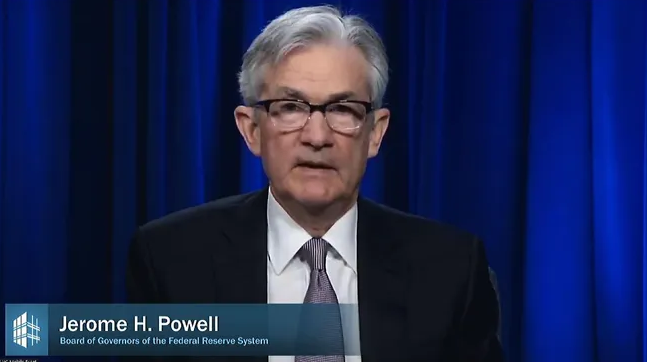
Fed signals interest rates near 0% through 2022
Despite last week’s blockbuster jobs report, the Federal Reserve is showing no letup as it continues to respond aggressively to economic damage from the coronavirus pandemic that could linger for years. The Fed on Wednesday held its key interest rate near zero and signaled it likely won’t lift it until at least 2022, noting the outbreak “will weigh heavily on economic activity” and “poses considerable risks to the economic outlook.” “We’re not even thinking about raising rates,” Fed Chair Jerome Powell said in a virtual news conference. “We’re not even thinking about thinking about raising rates." June 10, 2020
Source - read more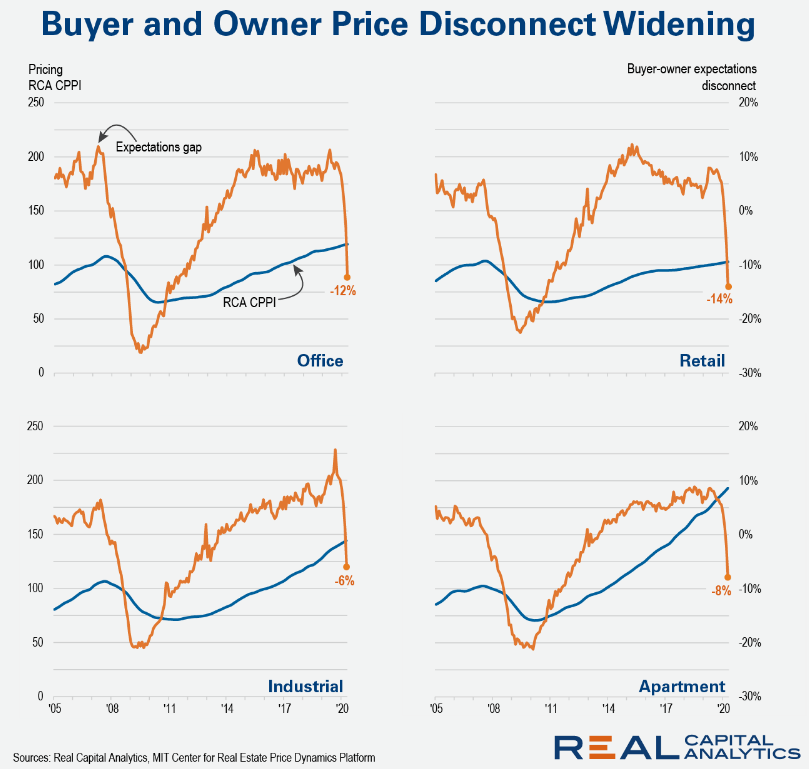
Buyer/Owner Price Disconnect Widening
Do not be fooled into thinking that U.S. commercial property prices have already fallen at high double-digit rates. Until market participants can comfortably start visiting properties, clients, and other service providers – and we enter the price discovery phase of the downturn – prices cannot move. However, the spread between buyer and owner expectations on pricing has widened sharply. June 11, 2020
Source - read more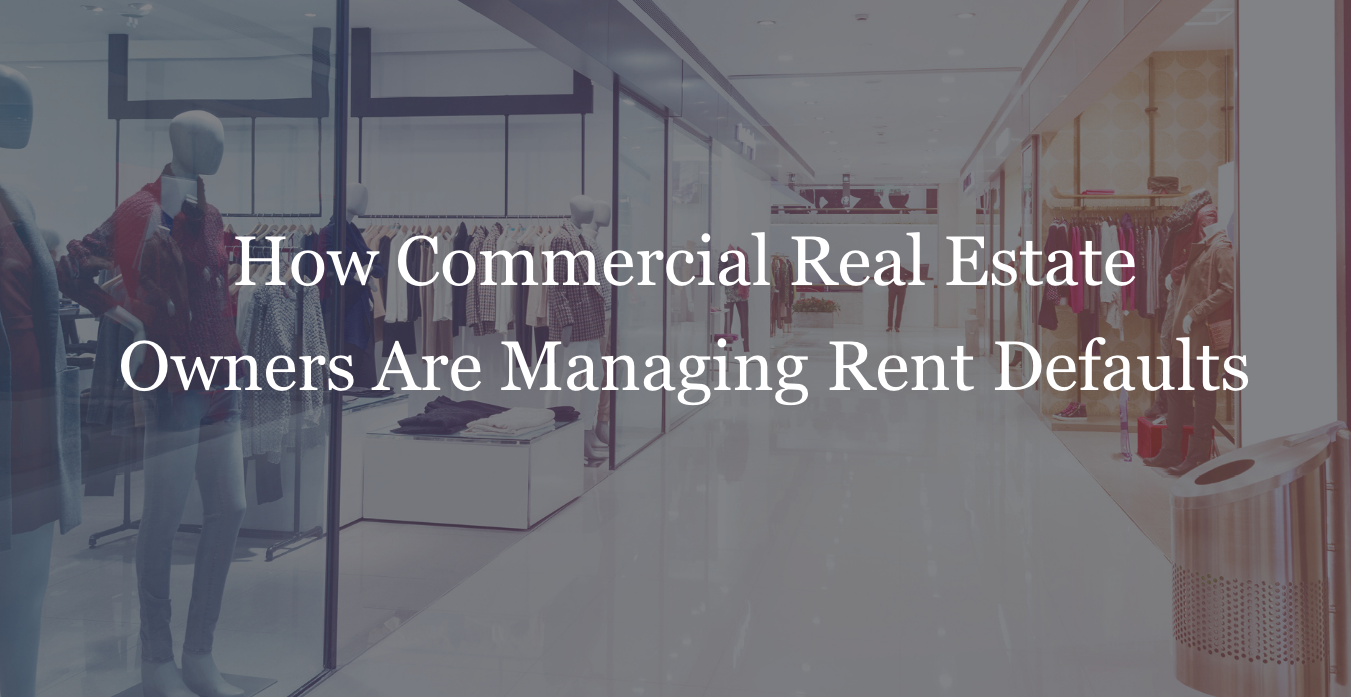
Commercial Rental Defaults Up in April
As businesses begin to re-open across the U.S., commercial property owners are coping with rent-collection woes triggered by the COVID-19 pandemic and protest-related property damage, which was reported in at least 25 cities. The retail and hospitality sectors have been especially hard-hit. Owners of 30,000 strip malls in the U.S. received just 30 to 50 percent of April rent, according to Green Street Advisors. June 10, 2020
Source - read more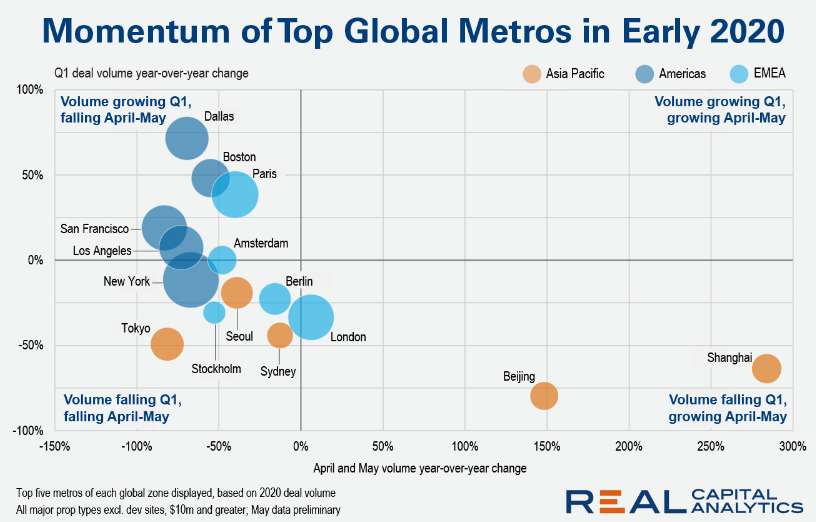
Global Trend is bouncing back? Maybe
Despite the slowdown in real estate markets accelerating across most of the world into the second quarter of the year, acquisition trends in two key global cities, both in China, have turned positive. Global volumes started to wane around March this year, but the weakness in Asia Pacific had already been apparent for some time, as all of the region’s top 10 metros suffered double-digit declines in the first quarter. In contrast, more than half of the key metros in Europe and the U.S. recorded an increase in transaction activity, as economic shutdowns and travel restrictions were implemented later in the quarter. June 10, 2020
Source - Read more
Home Prices/Rents directly linked to jobs
The U.S. economy added 2.5 million jobs in May and the unemployment rate declined to 13.3% from the prior report’s 14.7%, according to the Bureau of Labor Statistics. With jobs on the upswing, Mike Swell, co-head of global fixed income portfolio management at Goldman Sachs Asset Management, says a housing crisis is unlikely. According to Swell, the residential housing market will be 100% correlated to the jobs market and adds that he expects the commercial real estate market to stabilize. In this Video Spotlight, Swell speaks with Bloomberg's Tom Keene, Lisa Abramowicz and Jonathan Ferro on the job market's relationship with the housing market. June 8, 2020
Source - Read more
CBRE Expert Roundtable Flash Call
The COVID-19 situation around the world is fluid and evolving. As difficult as this period is, uncertainty will bring about unprecedented change and an opportunity to influence the future—and likely some transformational innovation, too. Preparing to reopen workplaces will require careful consideration and tailored plans. As we begin to execute a thoughtful and phased reopening approach, human behavior, along with digital and building technologies, will play a vital role in mitigating risk. To explore this topic further, CBRE hosted a roundtable discussing key issues related to a safe and healthy return to work. Subject matter experts shared insights on the global economy, prudent reopening practices, the role of smart buildings and technology, COVID-19 track-and-trace strategies, and more. May 19, 2020
Source - read more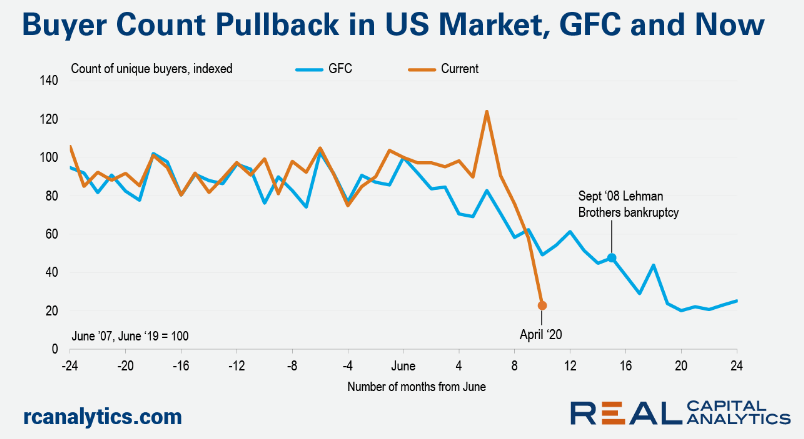
Shrinking Buyer Pool May Accelerate Price Floor Discovery
The drivers of the current downturn in the economy and commercial property markets are distinct from those which led to the Global Financial Crisis (GFC). This Covid-19 downturn came on suddenly, while warning bells were ringing a number of years ahead of the collapse of the housing market in the last recession. The variation in drivers could lead to a faster race to the bottom for market prices this cycle. May 27, 2020
Source - read more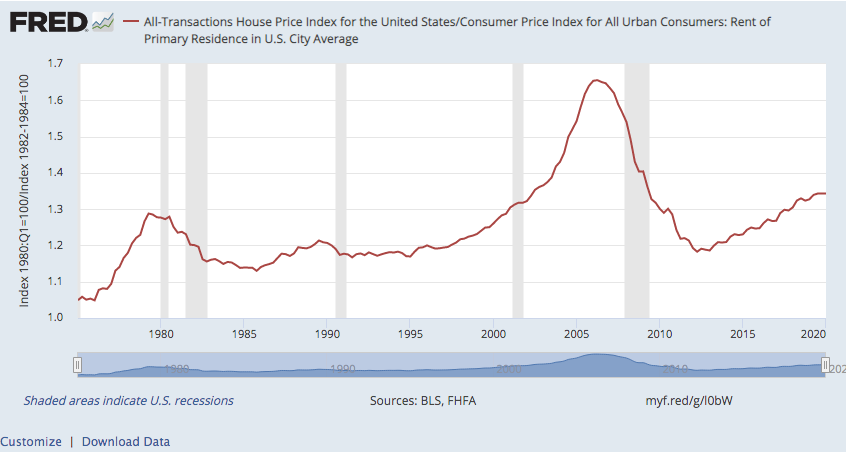
Is the housing price-rent ratio a leading indicator?
Economic forecasters are always on the lookout for variables that can help predict upcoming recessions. One such variable that has gotten some recent attention is the housing price-rent ratio. As this ratio becomes higher, the rental option becomes more attractive. If it rises high enough, some households might switch from owning their homes to renting them; then the demand for owner-occupied housing would fall. The result is a contraction in the housing market that can have adverse effects on the entire economy. This narrative seems to match well with the behavior of the housing price-rent ratio leading up to the Great Recession. So if the housing price-rent ratio is on the rise again, does that mean it’s cause for concern? Let’s try to evaluate whether the housing price-rent ratio is a reliable leading indicator by graphing it, with data going back to 1975.
Source - read more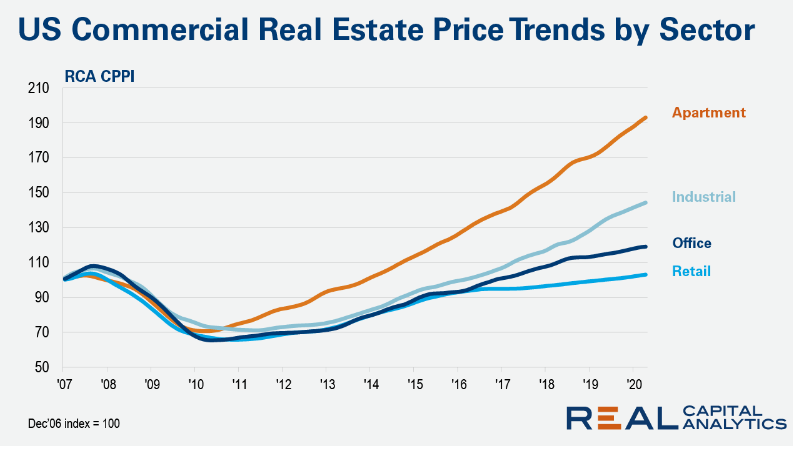
Commercial Sales Activity off 71%
The headline rate of annual U.S. commercial property price gains came in at 6.5% in April, little changed from the growth rate seen in 2020 so far, the latest RCA CPPI summary report shows. The US National All-Property Index gained 0.5% from March. While transaction prices have not yet been pounded by the Covid-19 upheaval, acquisition volume has. April sales activity across all property types sank 71% from a year earlier, on the heels of a 17% year-over-year decline in March, as reported in the latest edition of US Capital Trends, also released this week. May 21, 2020
Source - read more
Multifamily Sector Sees Reduced Construction: Report
Around 300,000 multifamily units were expected to open this year, but projections now show the number is closer to 250,000 due to the effects of the coronavirus pandemic, according to commercial real estate firm Marcus & Millichap, Multi-Housing News reported May 12, 2020. The multifamily outlook for the next couple years is mixed and largely dependent on lender confidence.
Source - read more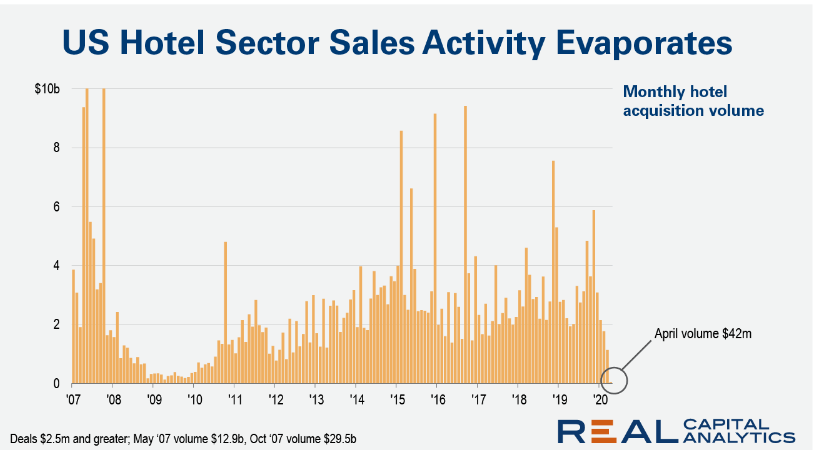
US Hotel Market Frozen
In the month of April fewer than 10 hotel properties changed hands across the entire U.S. We have never seen this level of illiquidity in the hotel market. It is effectively a frozen marketplace. Hotel sector investment activity was already spinning downward even before the economic crisis wrought by Covid-19. A construction glut in key markets and challenges from upstarts such as Airbnb had put the sector under pressure. May 20 2020
Source - read more
Small Business Pulse Survey: Tracking Changes During the COVID-19 Pandemic
The experimental Small Business Pulse Survey (Business Pulse) measures the changes in business conditions on our nation’s small businesses during the coronavirus (COVID-19) pandemic. May 14, 2020.
Source - read more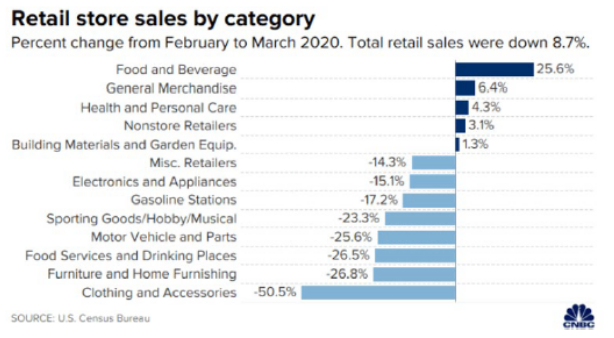
The Good and Bad of Retail Sales
Abundance of demand for high-quality assets with investment grade credit tenants that are open and paying rent. - Financing is readily available. - Capitalization rates for high-quality assets are unchanged from pre-COVID-19 20%-50% of retail tenants paid rent in April. - 30% of small business paid no rent or mortgage payments while 20% made a partial payment. - On average, market rents have probably declined to levels seen 1 to 2 years ago. - 10% to 40% or restaurants are projected to not reopen. See this 120 minutes presentation from experts examining the impact of the coronavirus on commercial property. April 20, 2020.
Rource - read more
NAIOP CRE Sentiment Index at New Low; Occupancy, Cap Rates Among Low Scores
The Commercial Real Estate Development Association's CRE Sentiment Index fell to 45 in March — its lowest score since NAIOP launched its bi-annual index in 2016; a score below 50 indicates that unfavorable CRE conditions are expected for 12 months. The scores for occupancy rates and first-year cap rates were among the lowest. May 14, 2020
Source - read more
Office Sector Expected to Recover; Newer 'Green' Buildings to Grow in Demand:
CBRE The office sector is expected to recover from the coronavirus pandemic, but it likely will be changed as companies may seek more space, not less, to accommodate social distancing, and choose newer buildings with green elements like improved indoor air quality over older buildings with outdated features, according to real estate firm CBRE, CNBC reported. May 14, 2020
Source - read more
Recession vs. Depression
How would each affect housing and does it matter anyway? May 18, 2020.
Source - read more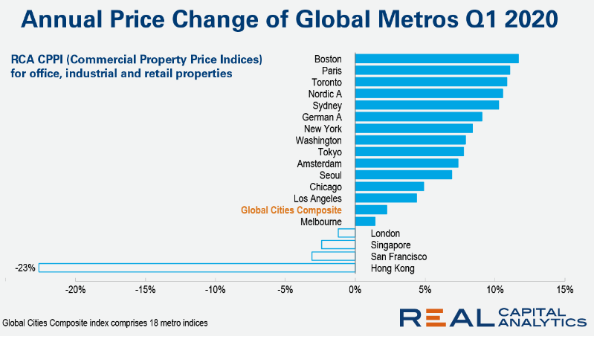
Annual Price Change of Global Metros Q1 2020